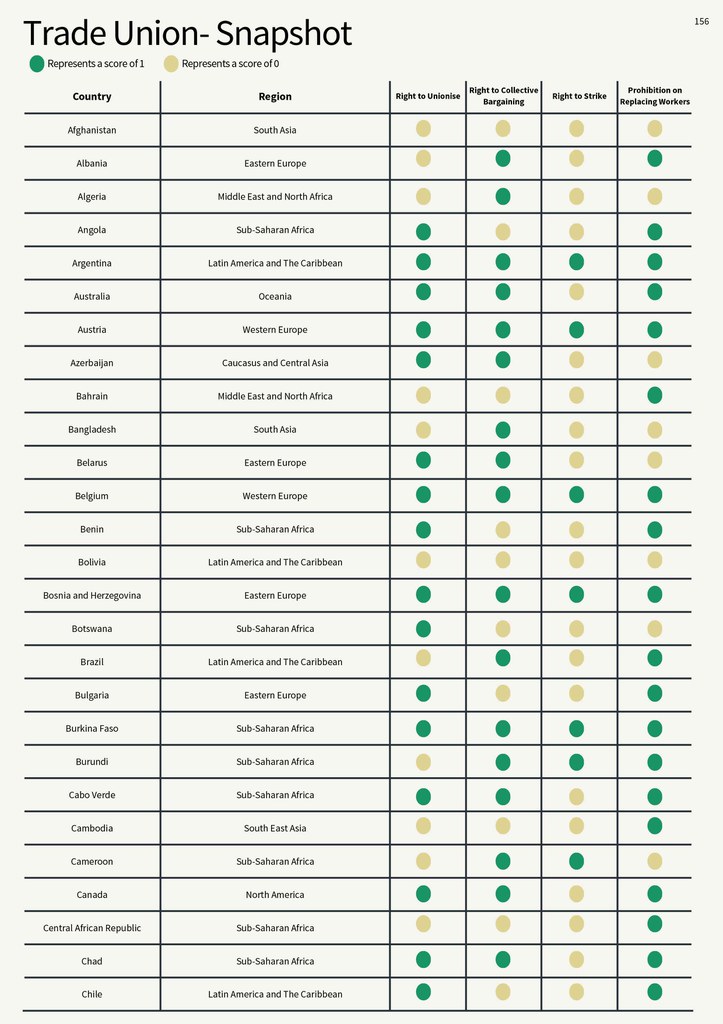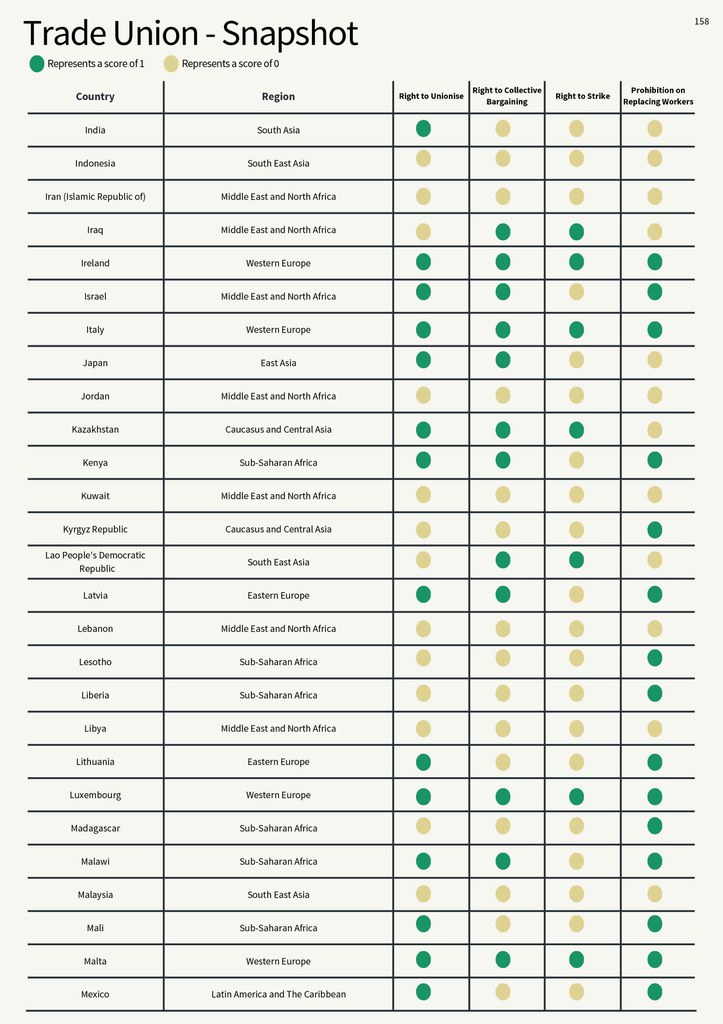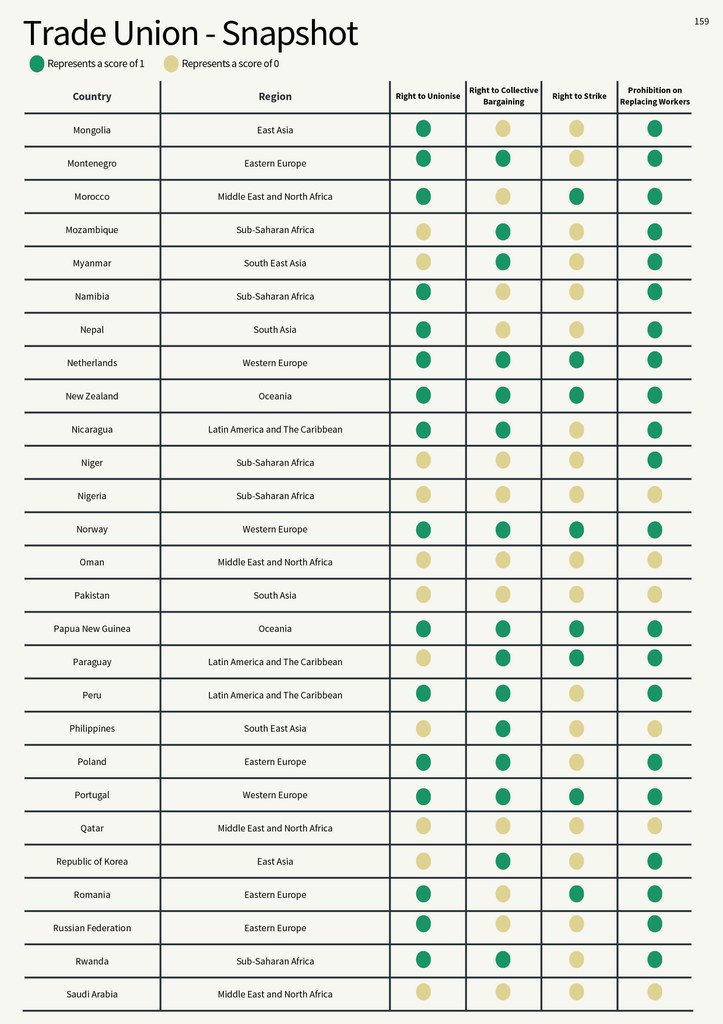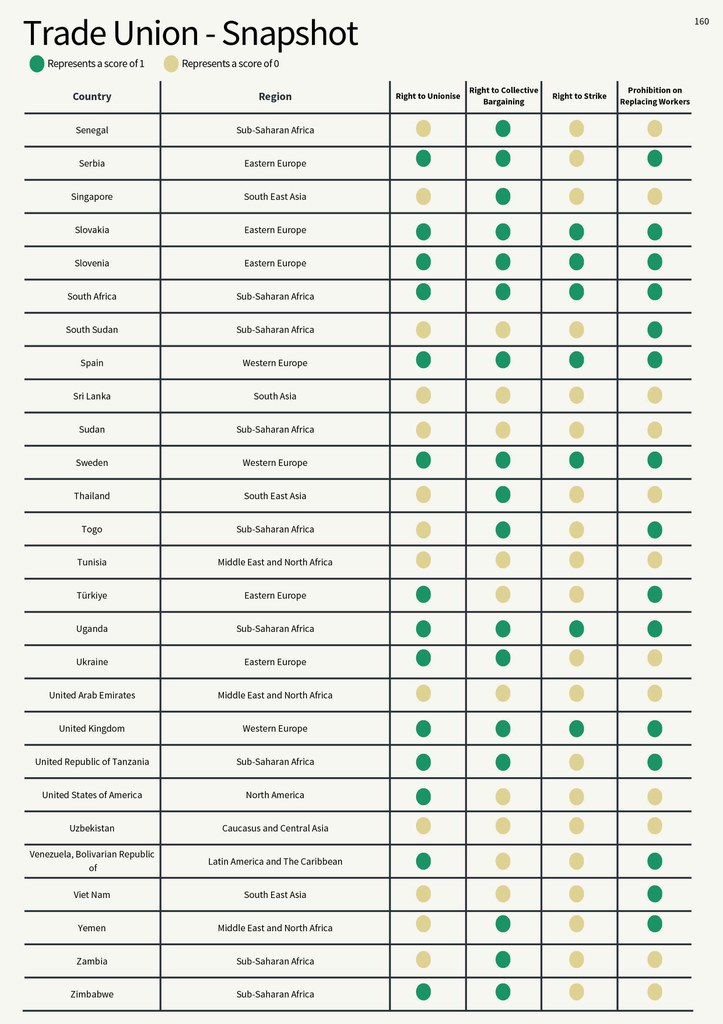Section 4 INDICATORS FOR DECENT WORK
Fair Wages
The Fair Wages indicator measures whether the law stipulates minimum wages or whether the wages are determined through collective bargaining. It also measures whether wages are paid in a regular and timely manner. Additionally, it evaluates 135 jurisdictions on their compliance to International Regulatory Standards on overtime and night work premium alongside the provision of a compensatory rest day for those working on a weekly rest day.
1.1 Minimum Wage
Does the law prescribe a minimum wage rate in the country?
International Regulatory Standard
Article 23 (3) of the Universal Declaration of Human Rights and Article 3 of the Minimum Wage Fixing Convention 1970 (No. 131), and Article 7 of the International Covenant on Economic, Social and Cultural Rights (Fair Wage clauses) require that all workers have the right to just and favourable remuneration so that workers are ensured fair wages and decent living. While determining the minimum wages, the needs of workers and their families alongside economic factors must be considered.
Methodology
Whether labour legislation sets the minimum wage:
1: Labour legislation, negotiation between parties or bargaining at the sectoral or national level sets the minimum wage. The minimum wage must have been updated at least once during the past two years (with reference to January 2020).
0: No provision in legislation on minimum wage or in the absence of statutory minimum wage, there is no sectoral bargaining. The minimum wage has not been updated in the past two years.
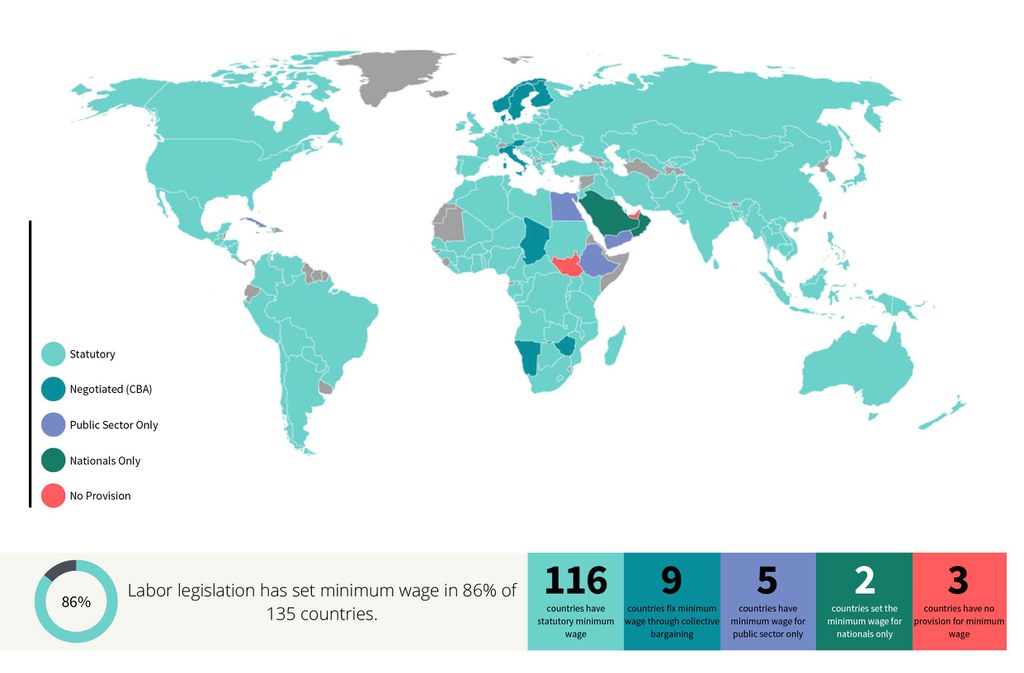
1.2 Regular Wage
Does the law require regular and timely payment of wages?
International Regulatory Standard
Article 12 (1) in Protection of Wages Convention 1949 (No. 95) and Article 11 (6) of Social Policy (Basic Aims and Standards) Convention 1962 (No. 117) state that wages should be paid regularly or at regular intervals (to reduce the likelihood of a worker becoming indebted) which need to be fixed in national laws or regulations or by collective agreements, except where other suitable arrangements are provided which ensure wages payment at regular intervals. The legislation must set a time limit within which wages must be paid after the completion of a wage period.
Methodology
Whether labour legislation requires regular and timely payment of wages:
1: Labour legislation requires employers to ensure regular and timely payment of wages. Wage payment periods can be set at the hourly, daily, weekly, fortnightly or monthly levels.
0: The labour legislation does not require employers to ensure regular and timely payment of wages on completion of a wage period.
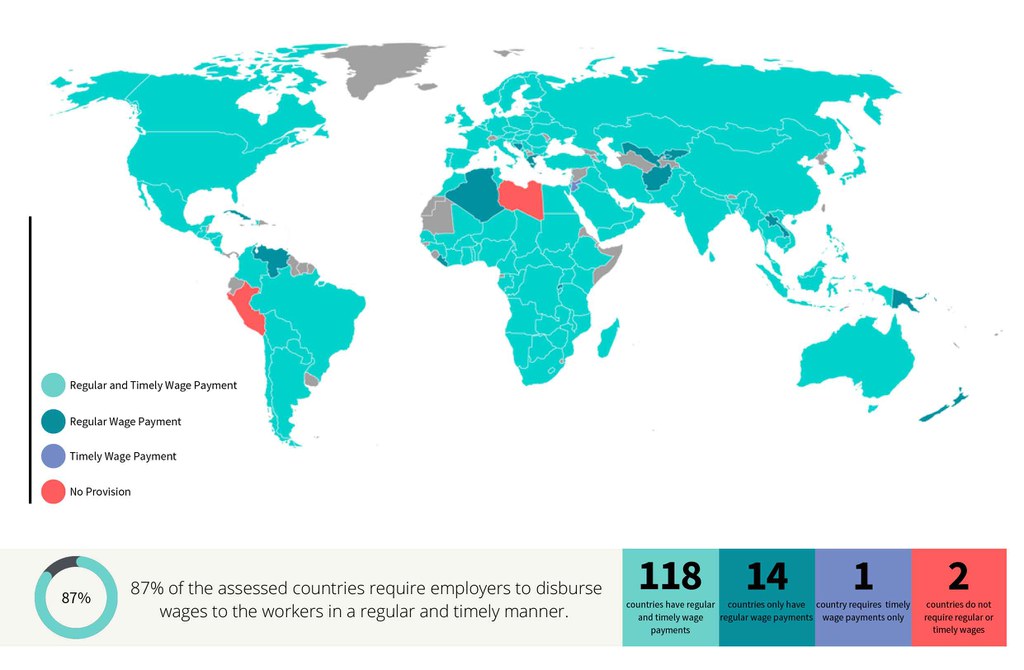
1.3 Overtime Premium
Does the law require overtime compensation to be at least 125% of the regular hourly rate?
International Regulatory Standard
Article 6 of Hours of Work (Industry) Convention 1919 (No. 1) and Article 7 of the Hours of Work (Commerce and Offices) Convention 1930 (No. 30) establishes that workplaces which necessarily have to carry out work after general working hours due to certain reasons such as force majeure, should develop regulations (by public authority and after consultation with employers’ and workers’ organisations where present) which fix the limit of additional hours in each instance and the rate of pay for overtime not less than one and one-quarter times the regular rate.
Methodology
Whether overtime compensation is at least 125% of the regular rate:
1: Monetary compensation for overtime is 125% or more of the regular hourly rate.
0: Overtime compensation is less than 125% of the regular hourly rate.
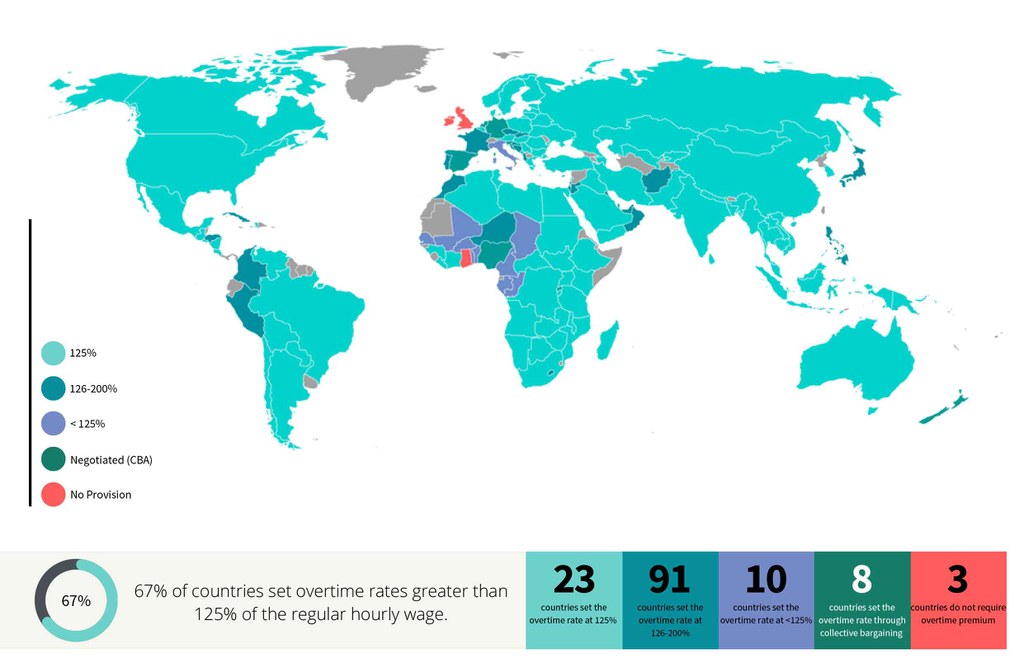
1.4 Weekly Rest Work Compensation
Does the law require additional compensation for working on a weekly rest day?
International Regulatory Standard
Both Article 5 of the Weekly Rest (Industry) Convention, 1921 (No. 14) and Article 8(3) of Weekly Rest (Commerce and Offices) Convention, 1957 (No. 106) state that provision for compensatory rest periods should be granted, with certain temporary exceptions, except in cases where agreements or customs already provide for such periods. Article 8(3) also refers to the provision of a compensatory period of rest of a total duration at least equivalent to a period of twenty-four hours.
Methodology
Whether there is additional compensation for working on a weekly rest day:
1: The legislation requires the provision of a compensatory rest day, or workers are given both the substitute day-off and premium payment.
0: Working on a weekly rest day is compensated with only a premium payment, or employers have the option to provide either a premium payment or a substitute day-off.
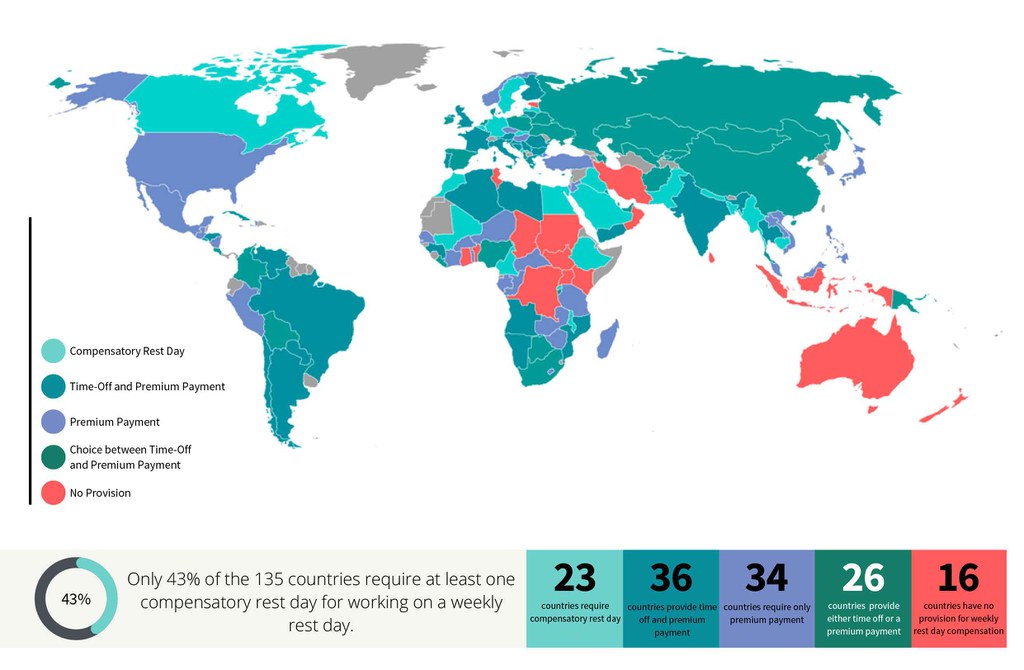
1.5 Night Work Premium
Does the law require additional compensation for night work?
International Regulatory Standard
Night Work Convention, 1990 (No. 171) states in Article 8 that compensation for night workers in the form of working time, pay, or similar benefits shall recognise the nature of night work.
Methodology
Whether there is additional compensation for work during night hours:
1: Monetary compensation is awarded for working night hours or if general working hours for night workers are reduced through shorter shifts or an additional day off.
0: Night work does not lead to a premium payment or a reduction in working hours.
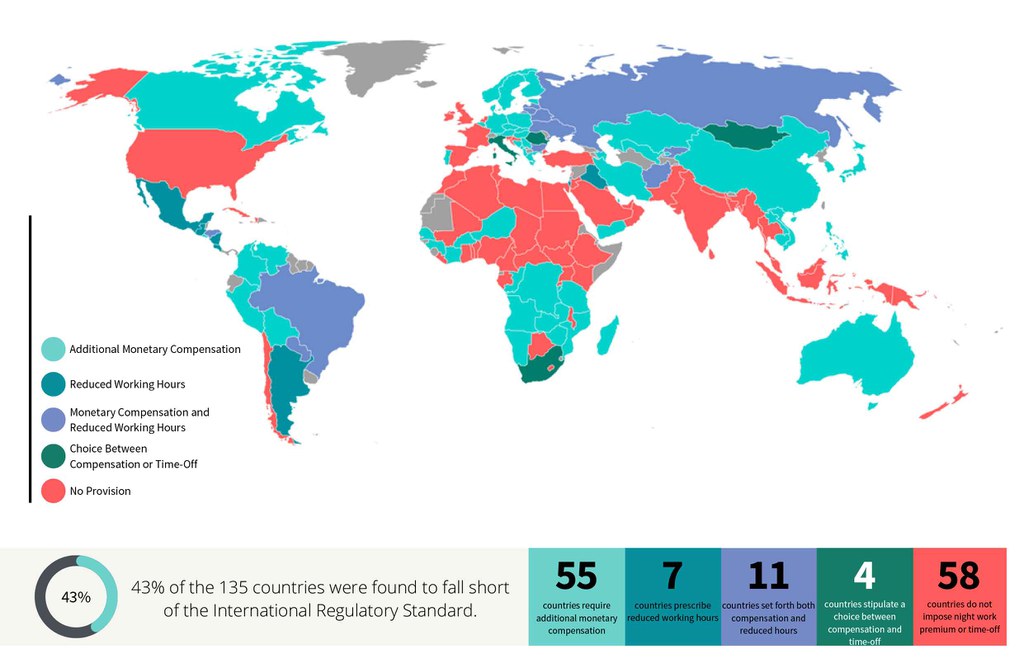
Fair Wages - Snapshot

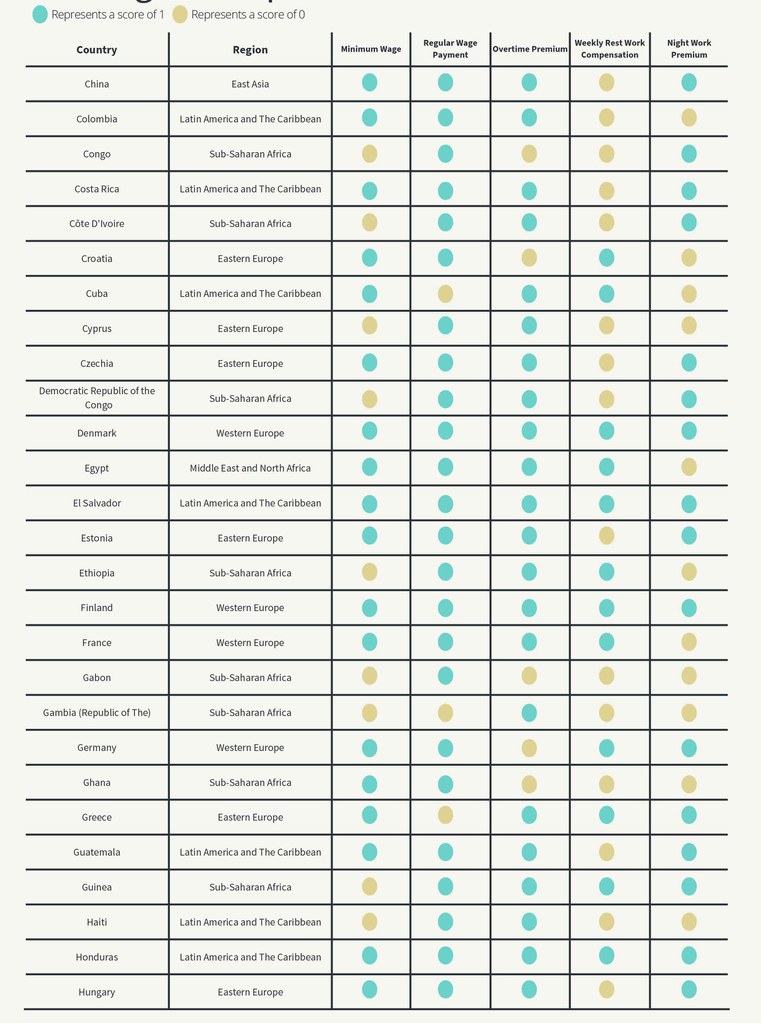
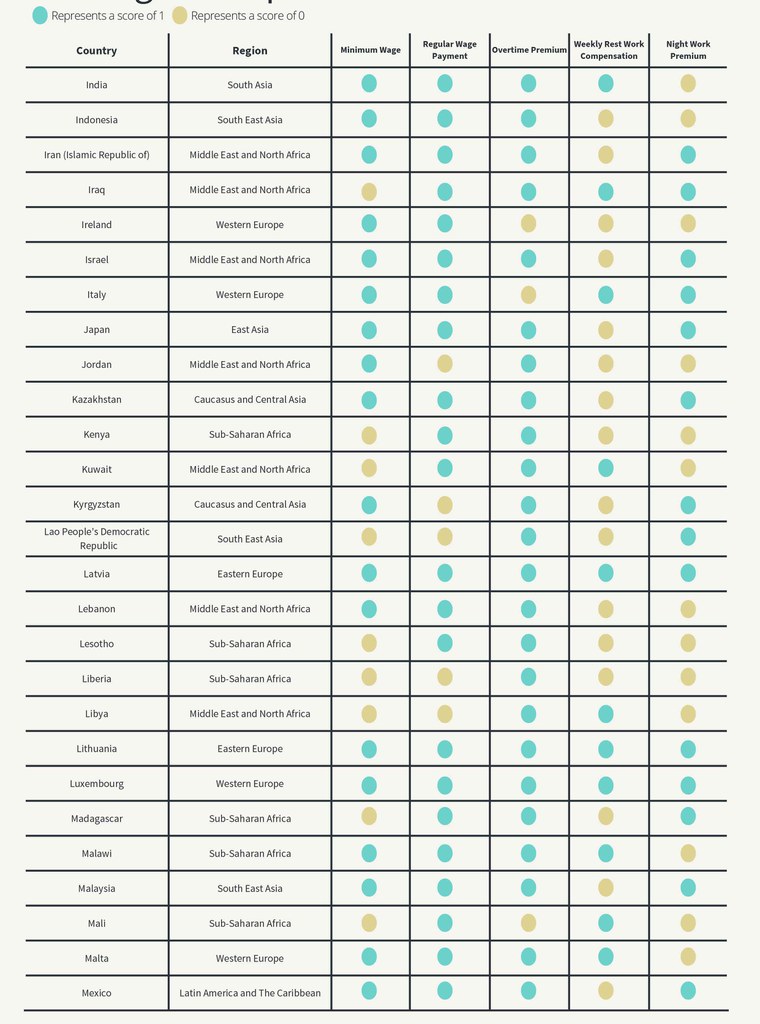
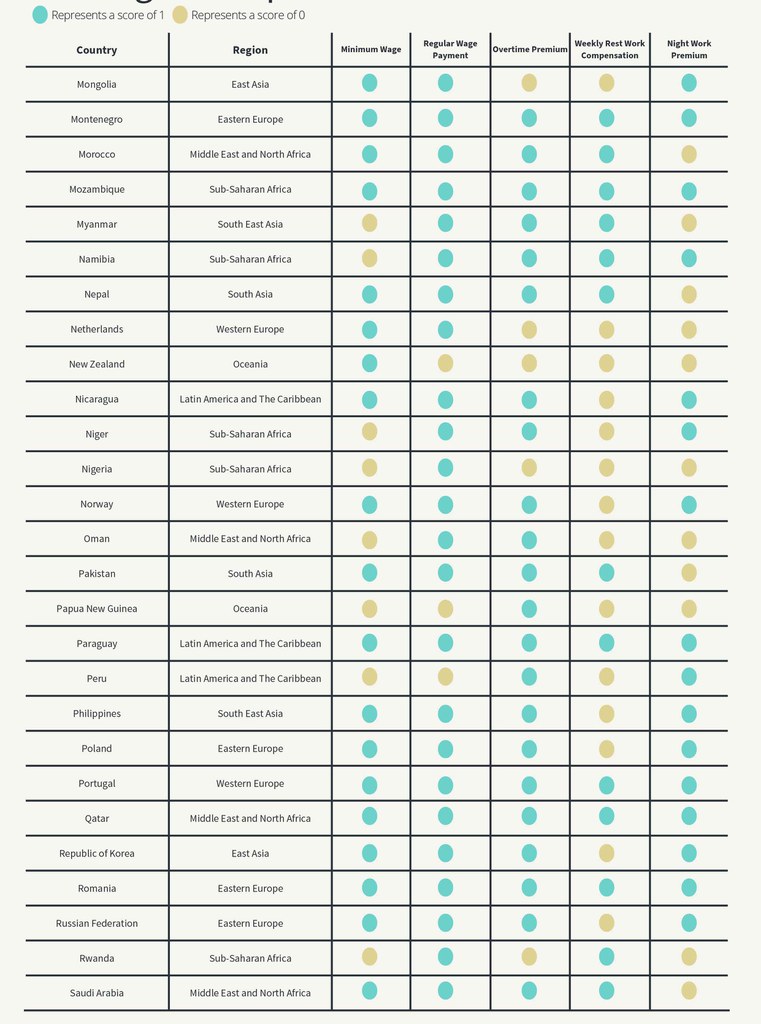
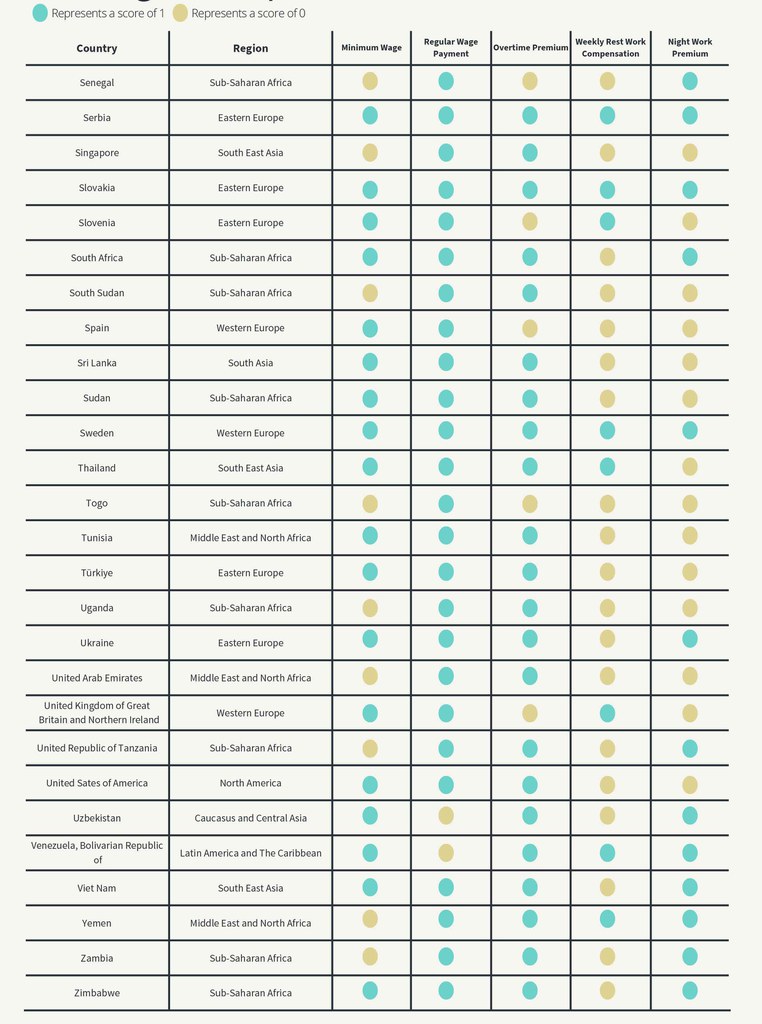
Decent Working Hours
The Decent Working Hours indicator measures whether workers' health and well-being are preserved while ensuring their productivity and motivation.
It assesses the law on working hours, overtime and the paid rest days - weekly rest, public holidays and annual leaves.
2.1 General Weekly Working Hours
Does the law stipulate general working hours as 48 hours or lower?
International Regulatory Standard
- Hours of Work (Industry) Convention 1919 (No. 1)
- Hours of Work (Commerce and Offices) Convention 1930 (No. 30)
- Forty-Hour Week Convention, 1935 (No. 47)
Articles 2 and 3 of C001 and C030 state that the working hours of employed persons should not exceed eight in the day and forty-eight in the week. Article 1 (C047) approves of a forty- hour week which is applied in a way so as not to reduce the living standard. C001 stated the exception; the provision on the forty-eight hours' threshold does not apply to supervisory, management, confidential positions, or whereby law, custom or agreement between employers’ and workers’ organisations or employers’ and workers’ representatives vary the daily hours limit (but not more than nine hours), or where shift workers are employed in excess of eight hours in a day and forty-eight hours in a week if the average hours over three weeks do not exceed eight per day and forty-eight per week.
Methodology
Whether labour legislation limits general working hours to 48 hours per week:
1: General working hours do not exceed 48 hours per week.
0: No restriction on weekly working hours or if general working hours are more than 48 hours per week.
34% of the 135 countries allow 48 hours as the general working hours. Kenya is the only country which sets working hours above 49 hours.
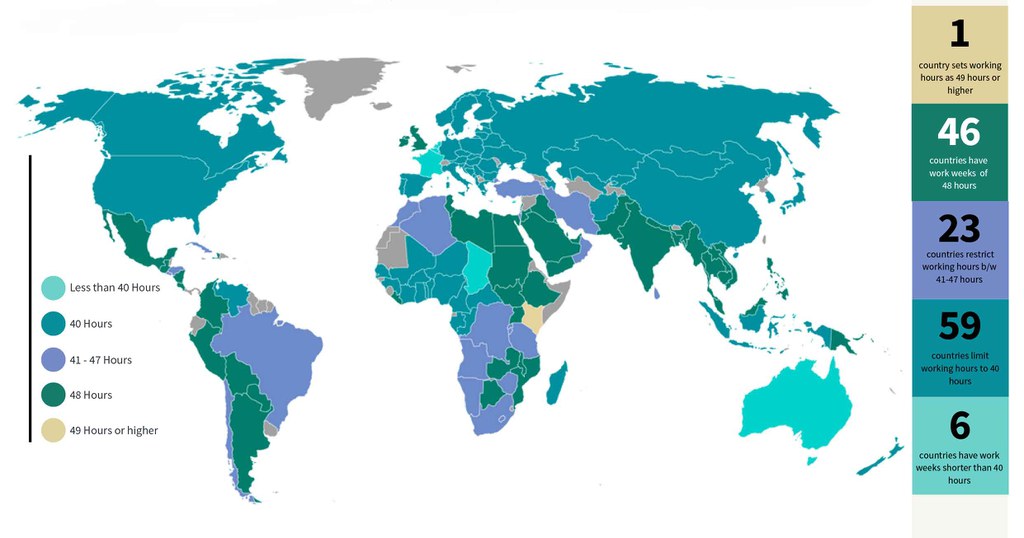
2.2 Maximum Weekly Working Hours
Does the law restrict maximum working hours, including overtime, to 56 hours per week?
International Regulatory Standard
The component, maximum weekly working hours, is grounded in Para 17 of the Reduction of Hours of Work Recommendation, 1962 (No. 116), Article 6(2) of Hours of Work (Industry) Convention 1919 (No. 1) and Article 7(3) of the Hours of Work (Commerce and Offices) Convention 1930 (No. 30).
Recommendation 116 mentions that the competent authority of every country should determine limits to the total number of overtime hours, except for cases of force majeure, worked during a specified period. C001 and C030 make it necessary for regulations (only after consultation with the organisations of employers and workers concerned) to fix the maximum of additional hours in each instance, aside from temporary exceptions, and the overtime pay rate to be not less than one and one-quarter times the regular rate.
Methodology
Whether labour legislation limits maximum working hours to 56 hours per week:
1: Total working hours inclusive of overtime do not exceed 56 hours per week.
0: Total working hours are more than 56 hours per week, or no relevant provision is found in the legislation.
10% of the 135 countries do not set maximum weekly hour limits.
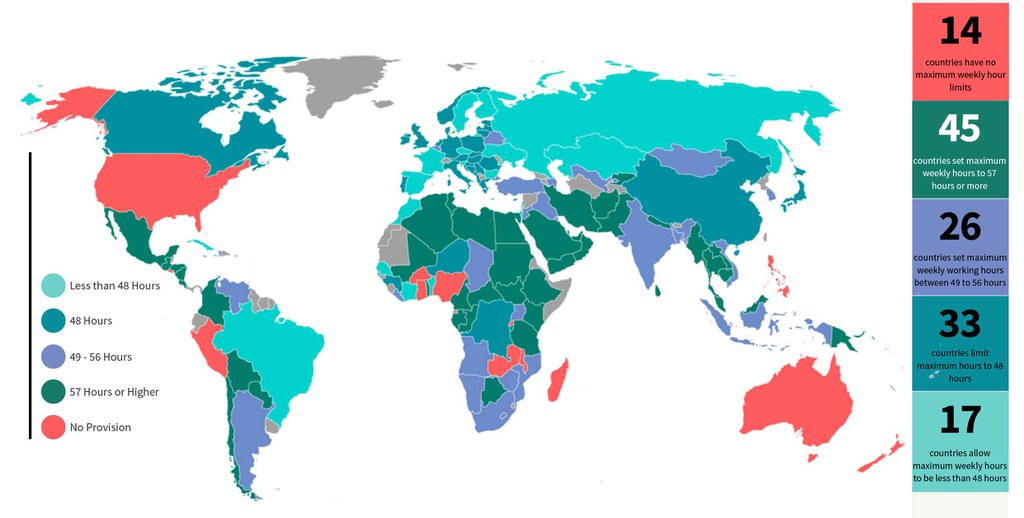
2.3 Weekly Rest Hours
Does the law require a weekly rest of at last 24 consecutive hours?
International Regulatory Standard
Article 2 of Weekly Rest (Industry) Convention 1921 and Article 6 of Weekly Rest (Commerce and Offices) Convention 1957 stipulates that every seven days, a weekly rest (comprising at least 24 consecutive hours) be granted simultaneously to all workers in every establishment. It should be fixed to coincide with the days already established by the traditions or customs of the country or district.
Methodology
Whether the labour legislation requires a weekly rest of at least 24 hours:
1: Workers have the right to a weekly rest of a minimum of 24 consecutive hours.
0: Labour legislation does not require a weekly rest day.
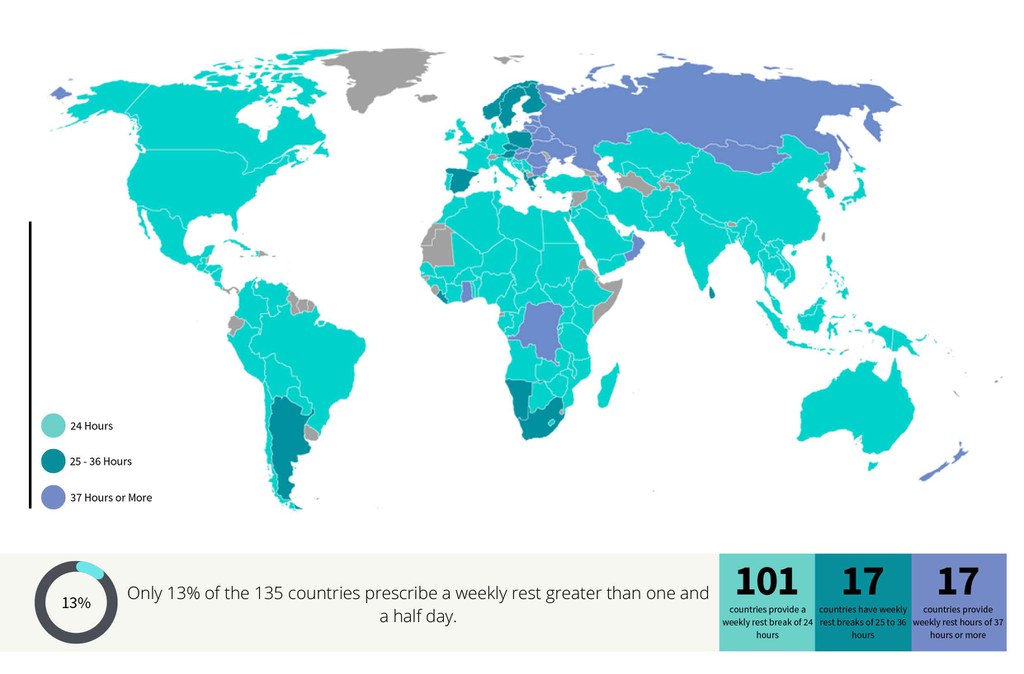
2.4 Paid Public Holidays
Does the law require paid public holidays?
International Regulatory Standard
It is stated in Article 7 (d) of the International Covenant on Economic, Social and Cultural Rights, 1966 that it is the right of everyone to enjoy just and favourable conditions of work that entail rest, leisure and remuneration for public holidays.
Methodology
Whether there are paid public holidays:
1: Legislation regulates paid public holidays, and there is a list of public and official holidays to follow.
0: Labour legislation does not require employers to grant a fully paid day off on public holidays.
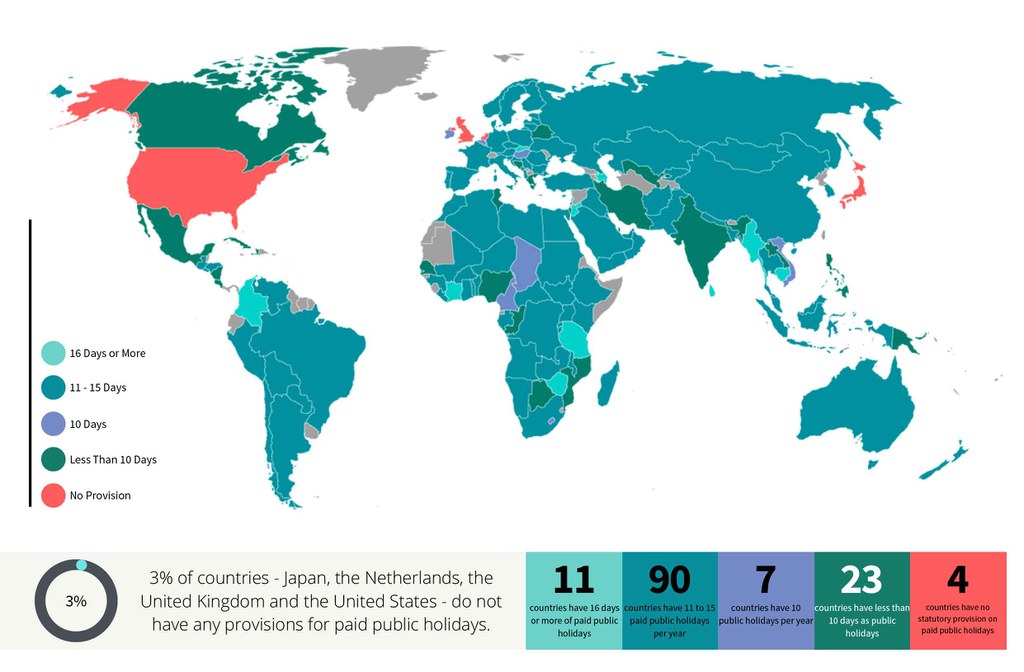
2.5 Annual Leave
Does the law require at least three working weeks of paid annual leaves?
International Regulatory Standard
Article 3 of Holidays with Pay Convention (Revised) 1970 (No. 132) requires that every person to whom this Convention applies shall be entitled to an annual paid holiday of a specified minimum length, where every Member who ratifies this Convention shall specify the length of the holiday, with the annual holiday not being less than three working weeks after one year of service.
Methodology
Whether there is paid annual leave:
1: The labour legislation requires employers to grant workers at least three working weeks of paid annual leave after completing one year of service.
0: The length of paid annual leave is less than three working weeks. A score of 0 is also assigned when the qualifying period for annual leave is more than a year.
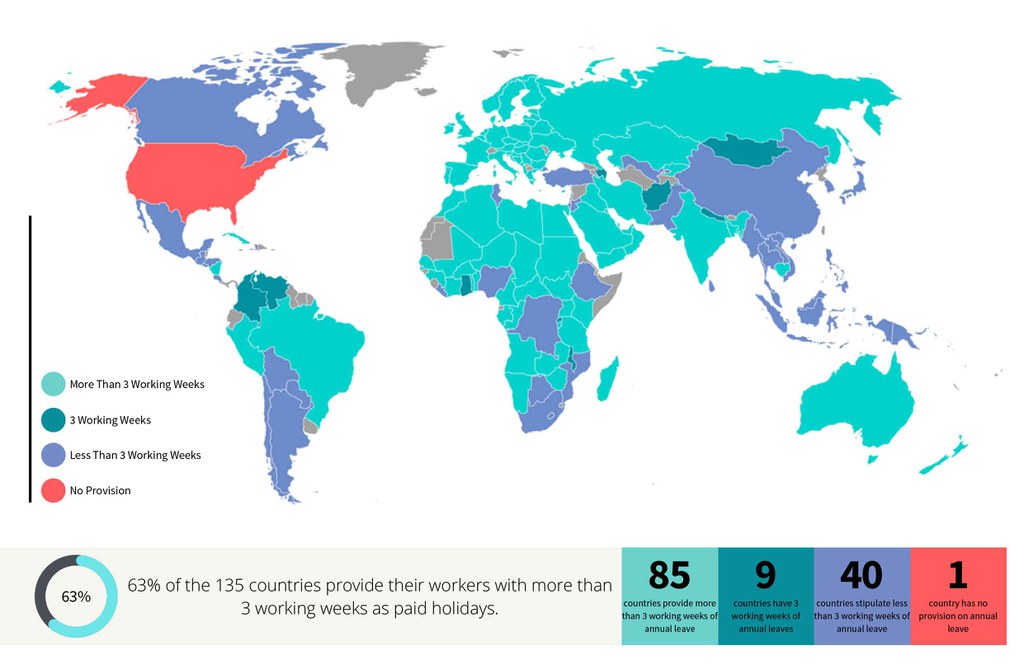
Decent Working Hours - Snapshot
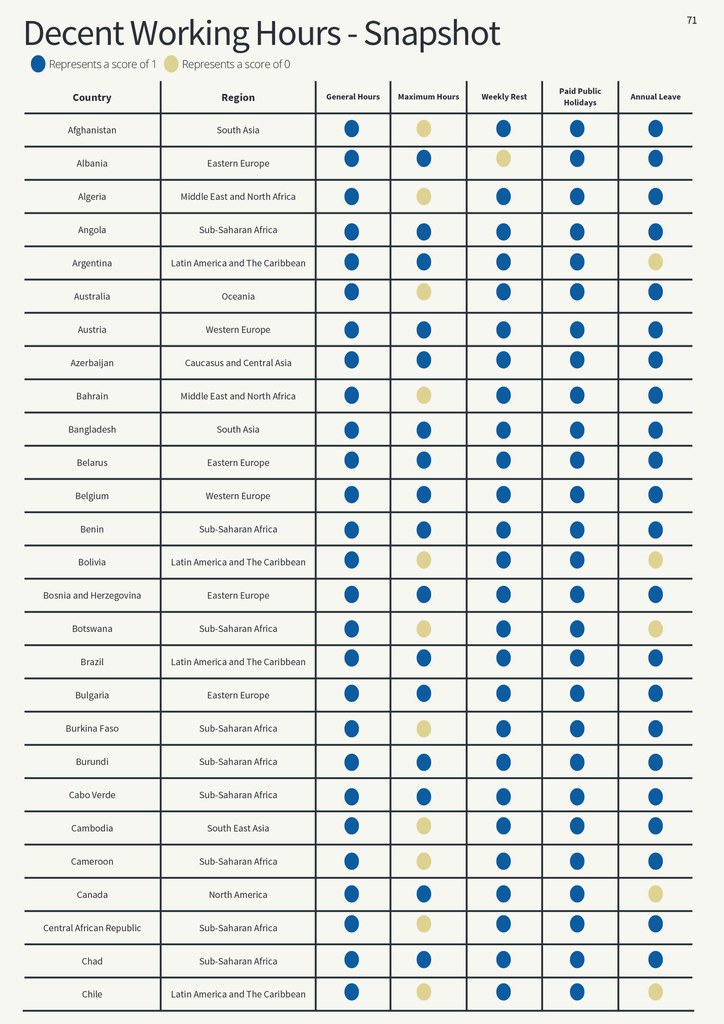
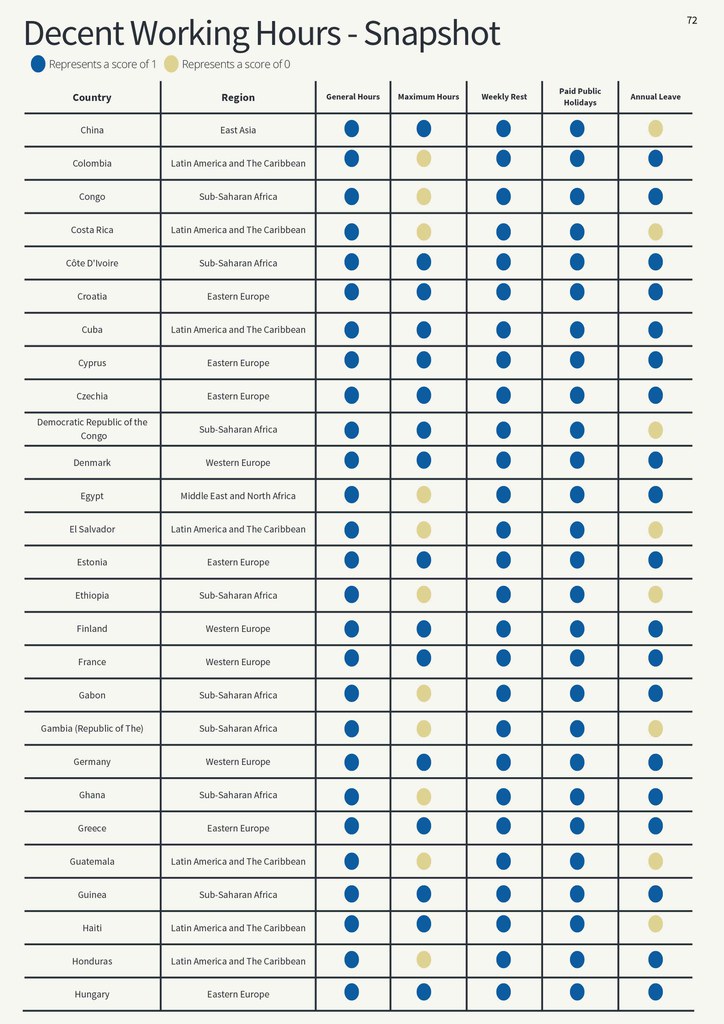
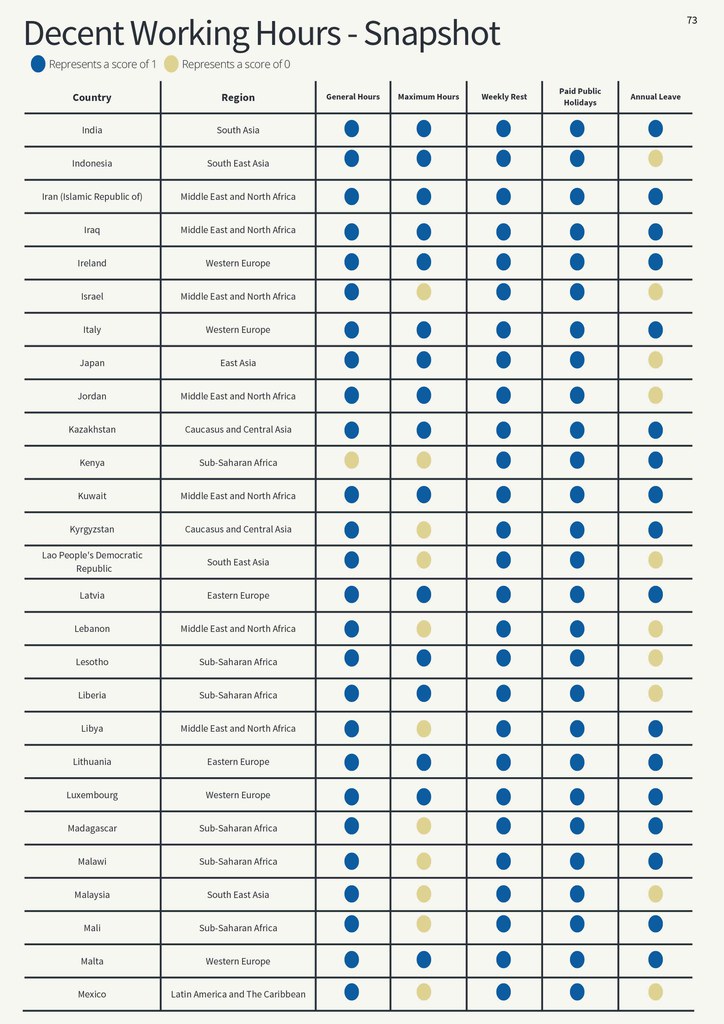
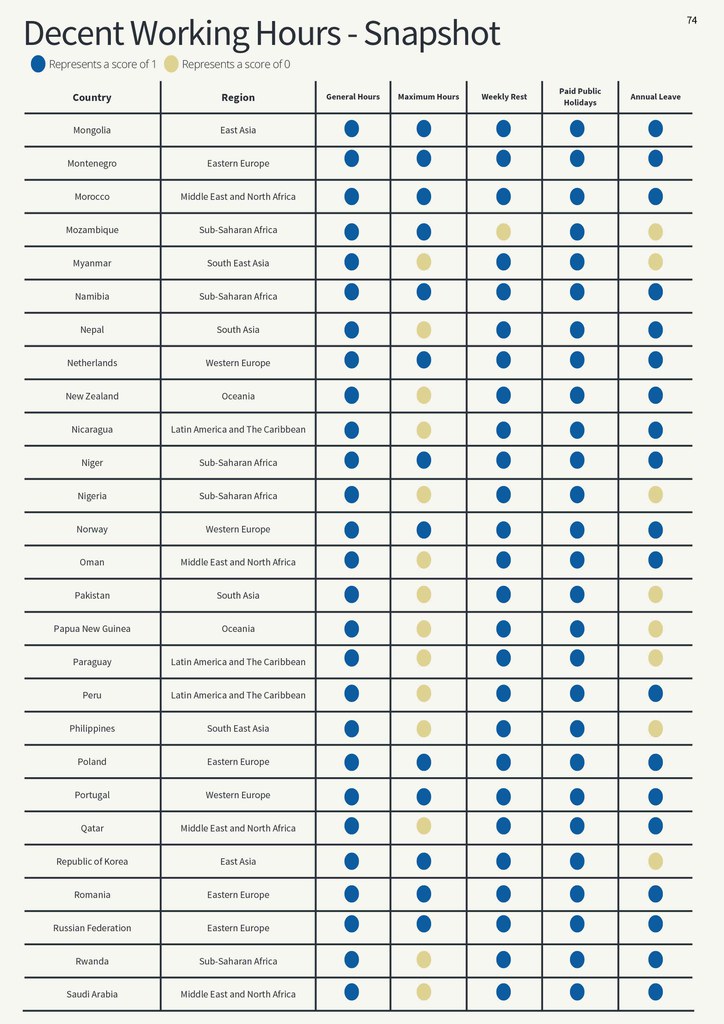
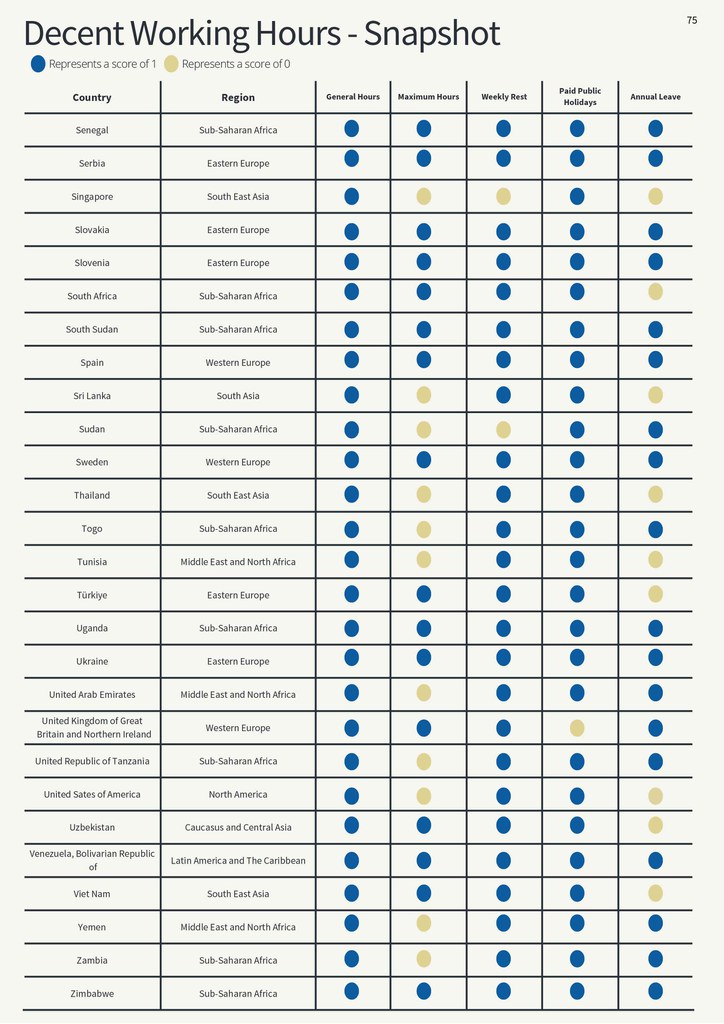
Employment Security
The Employment Security indicator measures whether labour legislation ensures that workers' jobs are characterized by a degree of permanence and reliability. The indicator considers various aspects of employment security and stability like a written employment contract, indefinite vs fixed-term contracts for tasks of a permanent nature, a probation period, a notice period before termination of contract and severance pay.
3.1 Written Employment Contract
Does the law require written employment contract or particulars?
International Regulatory Standard
Under Articles 7 and 8 of the Domestic Workers Convention, 2011 (No. 189), measures are to be taken to ensure that domestic workers are informed of their terms and conditions of employment in an appropriate, verifiable, and easily understandable manner and preferably, where possible, through written contracts (enforceable in the country where work is to be done) under national laws, regulations or collective agreements, and with written particulars. Similar provisions are found in the Maritime Labour Convention 2006.
Moreover, Part II (5) of the Private Employment Agencies Recommendation, 1997 (No. 188) suggest that workers employed by private employment agencies should, where appropriate, have a written contract of employment specifying their terms and conditions of employment. As a minimum requirement, these workers should be informed of their conditions of employment before the effective beginning of their assignment.*
Methodology
Whether employers are required to provide written employment contracts to workers:
1: The labour legislation requires employers to provide written employment contracts or at least written employment particulars to workers on commencement of employment.
0: No requirement on the employer’s part to provide any such written document.
Around 9% of the 135 countries do not require employers to provide written employment contracts or written employment particulars to workers.
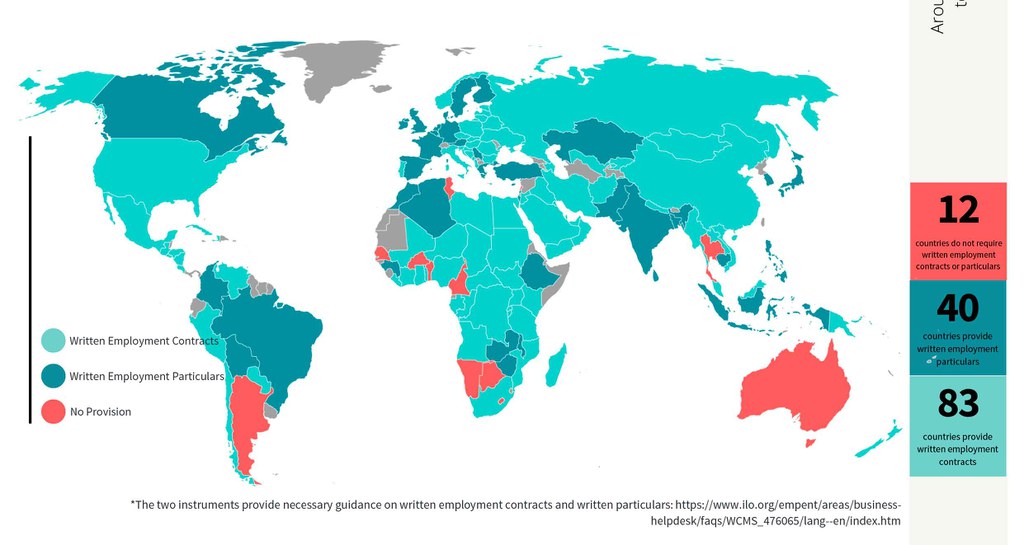
3.2 Fixed Term Contracts
Does the law restrict the hiring of fixed-term contract workers?
International Regulatory Standard
Article 2(3) of the Termination of Employment Convention 1982 (No. 158) states that adequate safeguarding measures should be provided against the use of fixed-term contracts of employment for a specified period of time with the aim of avoiding the protection resulting from this Convention.
Also, Article 3(2) of the Termination of Employment Recommendation, 1982 (No. 166) allows for a fixed or definite term contract, considering the nature of work or circumstances under which the work is carried out or the interests of the worker. The fixed-term contracts are considered indefinite term contracts if they are renewed once or more than once, except in the above cases.
Methodology
Whether labour legislation restricts the hiring of fixed-term contract workers:
1: The maximum length of fixed contracts, including renewals, does not exceed five years.
0: The labour legislation does not specify the maximum length of fixed-term contracts or allow the maximum length of Fixed-Term Contracts (FTCs), including renewals, to exceed five years.
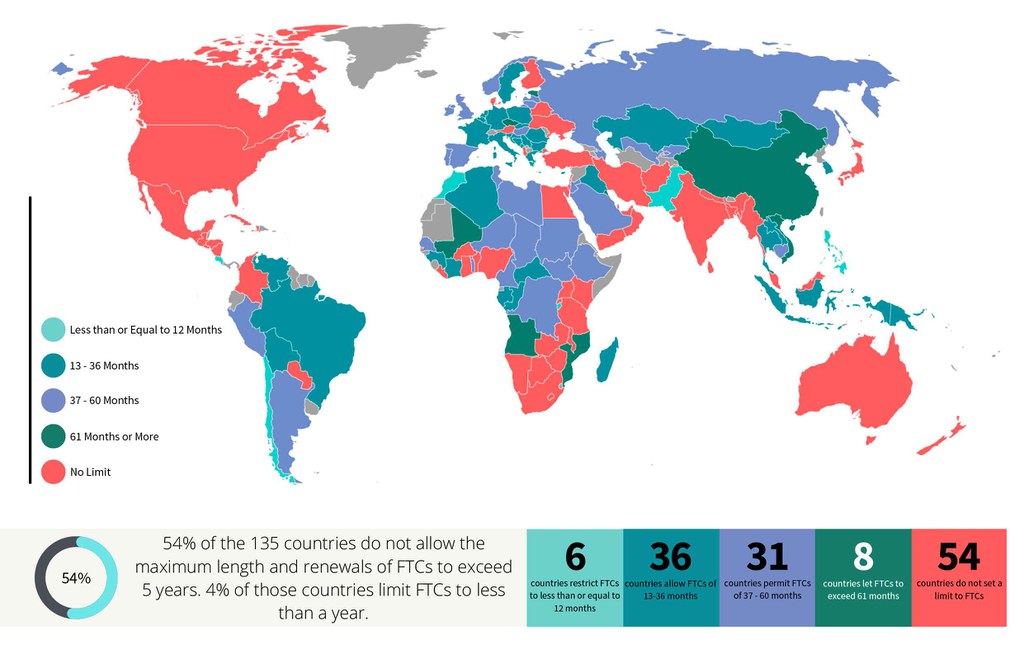
3.3 Probation Period
Does the law limit the length of probation period, including renewals, to three months?
International Regulatory Standard
This component is grounded in Article 2 (b) of the Termination of Employment Convention 1982 (No. 158). The Convention states that a Member may exclude workers serving a period of probation or a qualifying period of employment, determined in advance and of reasonable duration, from all or some of the provisions of this Convention. In view of this, a probationary period of three months was set as a standard.
Methodology
Whether labour legislation limits the length of the probation period to three months:
1: The labour legislation limits the maximum length of the probation period, including renewals, to three months.
0: The labour legislation does not refer to a probation/trial period or allow it to exceed three months.

3.4 Termination Notice Period
Does the law require a 30 day notice period before contract termination?
International Regulatory Standard
Article 11 of ILO Convention 158 states that a worker whose employment is to be terminated shall be entitled to a reasonable period of notice or compensation in lieu thereof unless the worker is guilty of serious misconduct - misconduct of such a nature that it would be unreasonable to require the employer to continue the employment during the notice period.*
Methodology
Whether there is a 30-day notice before contract termination:
1: A score of 1 is assigned if either of these scenarios is present.
a) Both the employer and employee can terminate an indefinite term contract after serving a 30-day written notice or paying in lieu of notice, except in cases of gross misconduct; or
b) where a termination notice required from employees is 30 days, but it is still less than the notice period required of employers; or
c) where the notice period required
0: Both the employer and employee are required to serve a contract termination notice of less than or more than 30 days.
13% of the 135 countries have different termination notice periods for the employer and employee. Argentina and Cuba are the only Latin American countries requiring different notice periods
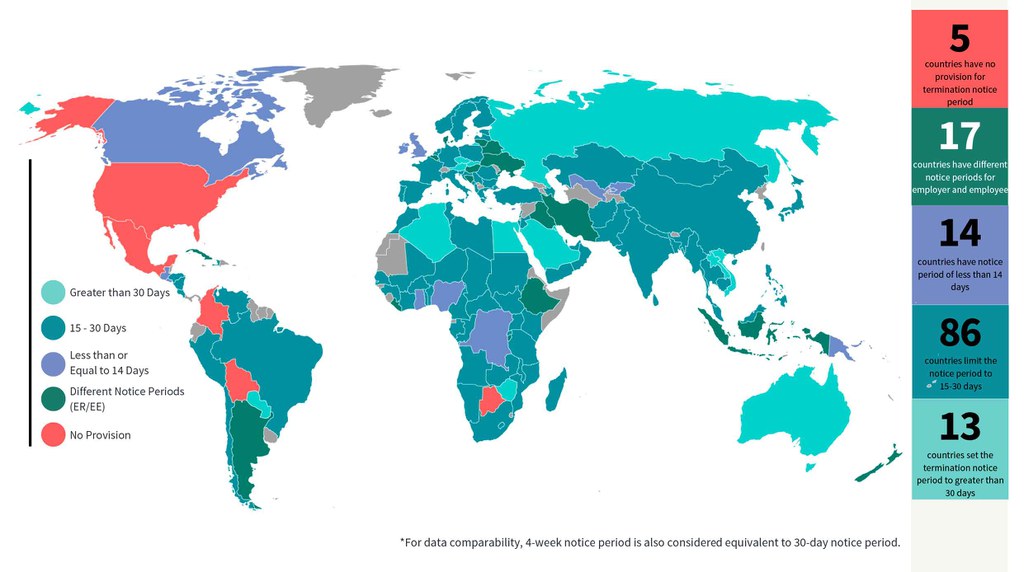
3.5 Severance Pay
Does the law require severance pay at the rate of at least two weeks of wages for every year of service?
International Regulatory Standard
Article 12 of the Termination of Employment Convention 1982 (No. 158) states that a worker whose employment has been terminated shall be entitled, in accordance with national law and practice, to a severance allowance or other separation benefits, the amount of which shall be based, among other things, on length of service and the level of wages. It is to be paid directly by the employer or by a fund constituted by employers’ contributions, unemployment insurance benefits or assistance or other forms of social security, or a combination of such allowance and benefits. Workers who do not fulfil the qualifying conditions for unemployment insurance or assistance or those workers who are terminated for serious misconduct need not be paid any severance allowance or separation benefits.
Methodology
Whether there is severance pay on contract termination:
1: Labour legislation requires employers to provide severance pay (gratuity or end of service allowance) at the rate of two weeks’ wages for each year of service* on contract termination in the event of individual dismissal or economic dismissals (redundancy) or on expiry of a fixed-term contract, except in cases of gross misconduct.
0: Severance pay is not required under the law or is provided at a rate lower than two weeks’ wages for each year of service or if the rate is not specified under the law.
24% of the 135 countries do not have any legal provision regarding severance pay.
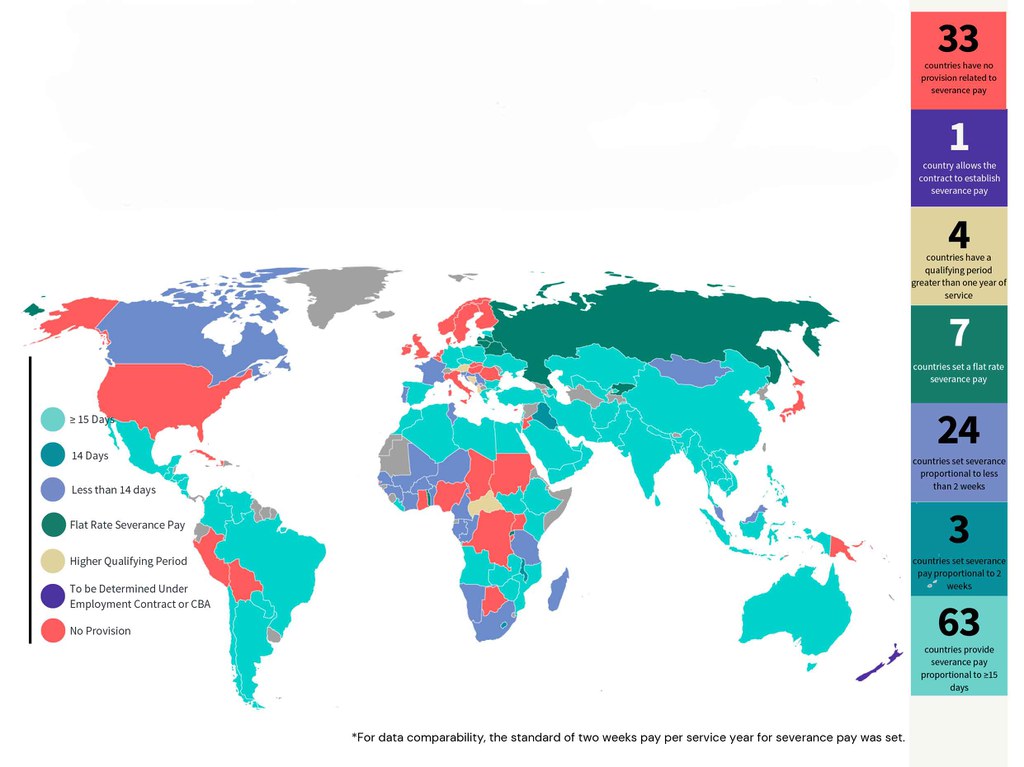
Employment Security - Snapshot

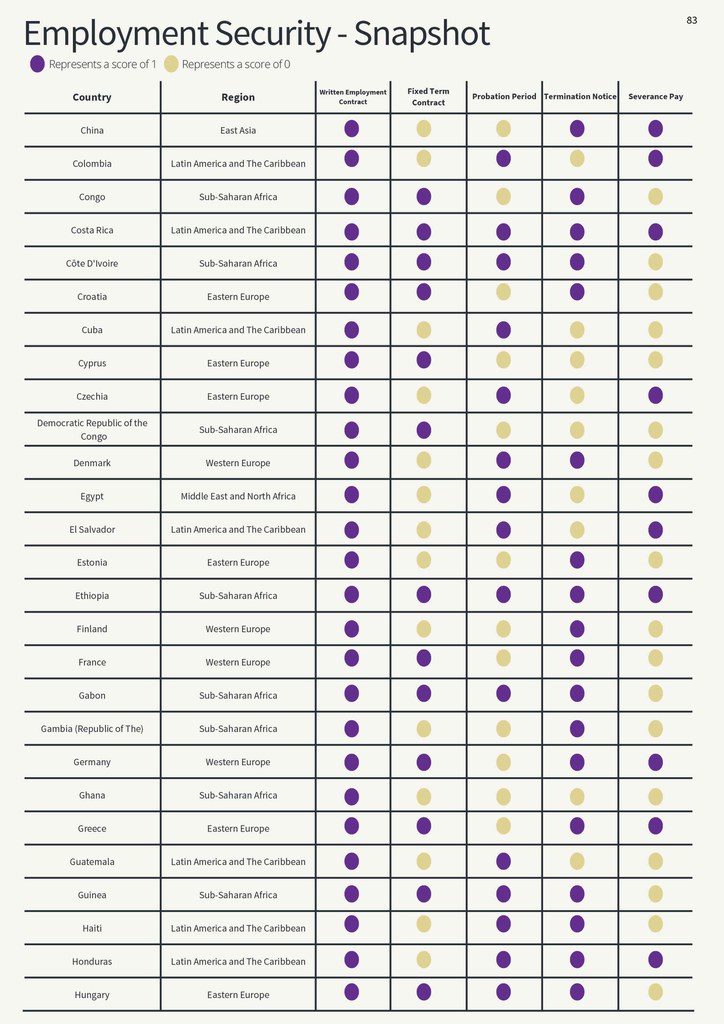
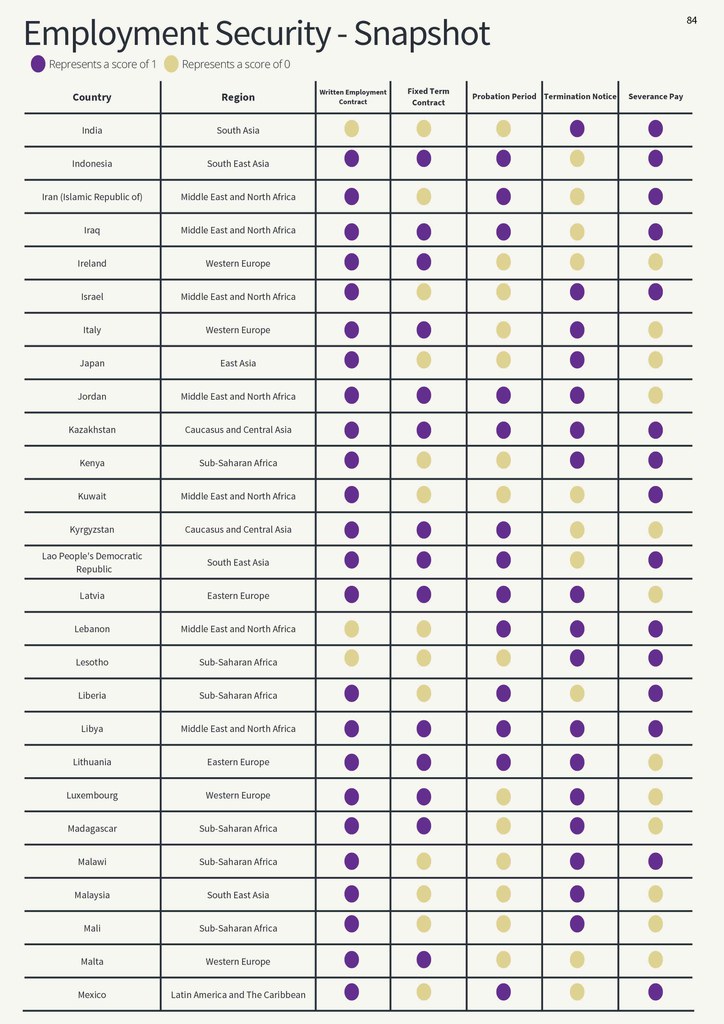
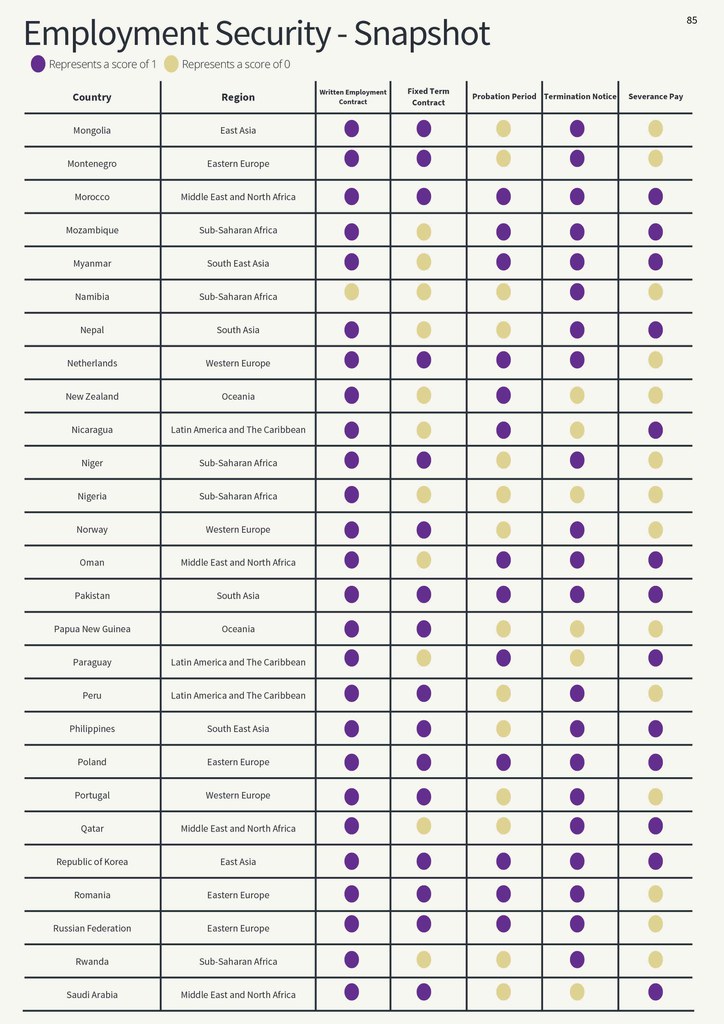
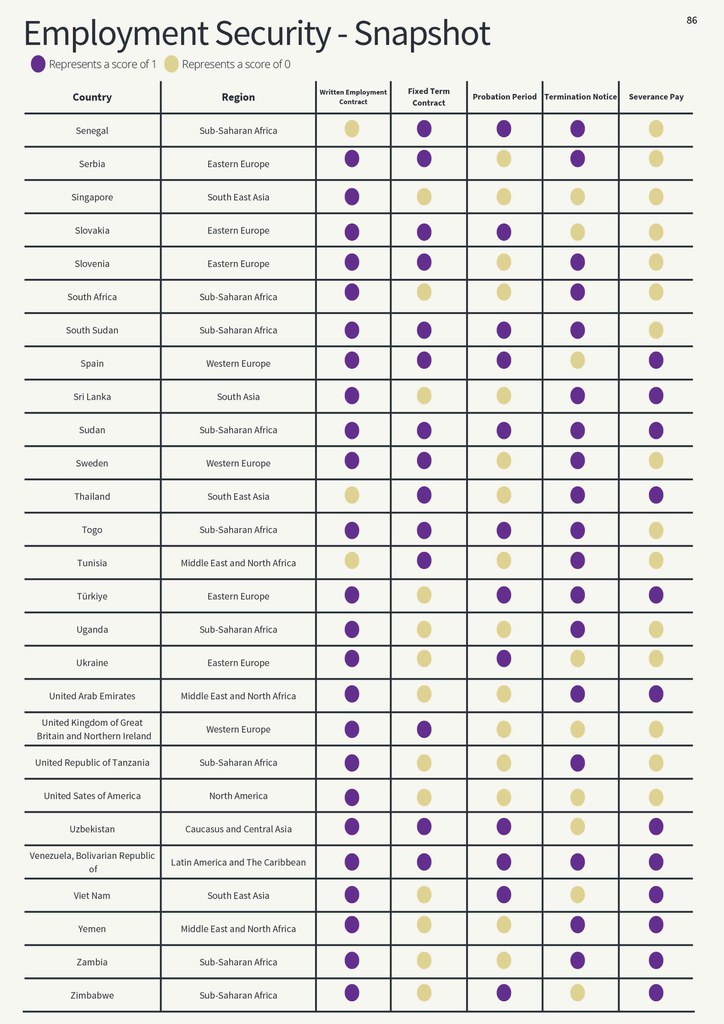
Family Responsibilities
Family responsibilities are responsibilities in relation to dependent children and other immediate family members who need care (sick, elder, infirm). The Family Responsibilities indicator measures whether labour legislation ensures that workers get paternity leave, parental leave and flexible work options while tending to their family responsibilities.
4.1 Parental Leave
Does the law require parental leave for parents?
International Regulatory Standard
Paragraph 22 of the Workers with Family Responsibilities Recommendation, 1981 (No. 165) and Paragraph 10 of the Maternity Protection Recommendation, 2000 (No. 191) insist that either parent should have the possibility, within a period immediately following maternity leave, of obtaining leave of absence (parental leave), without relinquishing employment and with rights resulting from employment being safeguarded. The parental leave period, its length, as well as payment of parental benefits and the use and distribution of parental leave between employed parents, should be determined by national laws or regulations or in any manner consistent with the national practice.
Methodology
Whether parental leave is available to parents:
1: Workers have the right to paid or unpaid parental leave of at least four months on exhaustion of paternity and maternity leave. 0: Labour legislation does not provide for the right to paid or unpaid parental leave of four months on exhaustion of paternity and maternity leave.*
56% of the 135 countries have no legal provision for parental leave. Chile, China and Singapore are the only countries to provide less than 4 months of parental leave.
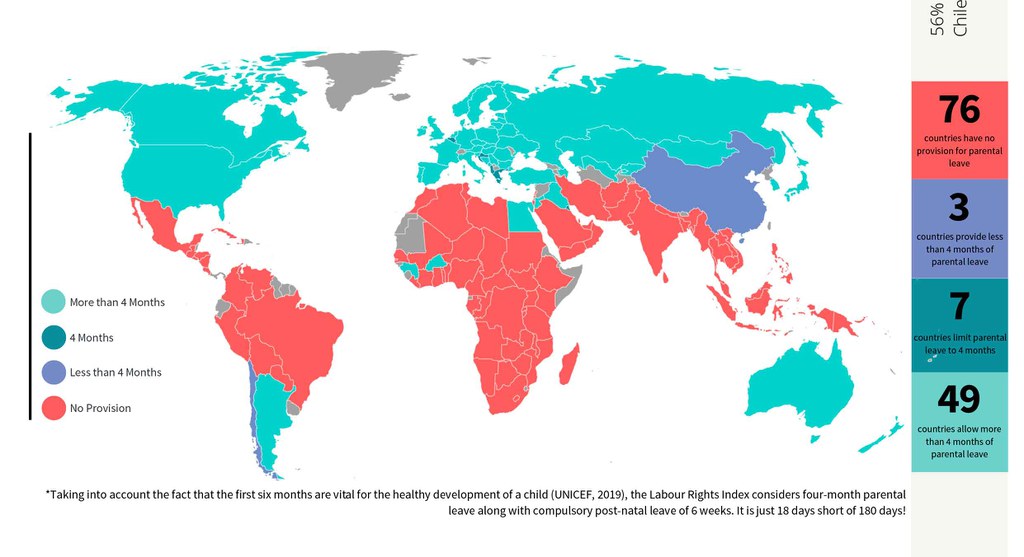
4.2 Paternity Leave
Does the law require at least one week of paid paternity leave for fathers?
International Regulatory Standard
In line with para 42 of the 2009 ILC Resolution Concerning Gender Equality at the Heart of Decent Work, Governments must develop, together with social partners, adequate policies for a better balance of work and family responsibilities for an equal sharing of these responsibilities. Other than parental leave, such policies should include paternity leave, with incentives for men to use them.
Methodology
Whether fathers have the right to take paid paternity leave:
1: Labour legislation requires employers to grant paid paternity leave of at least one week on the birth of a child. Paternity leave might be an employer liability or paid by the social security system or general tax financing.
0: There is no provision for paid paternity leave of at least one week.
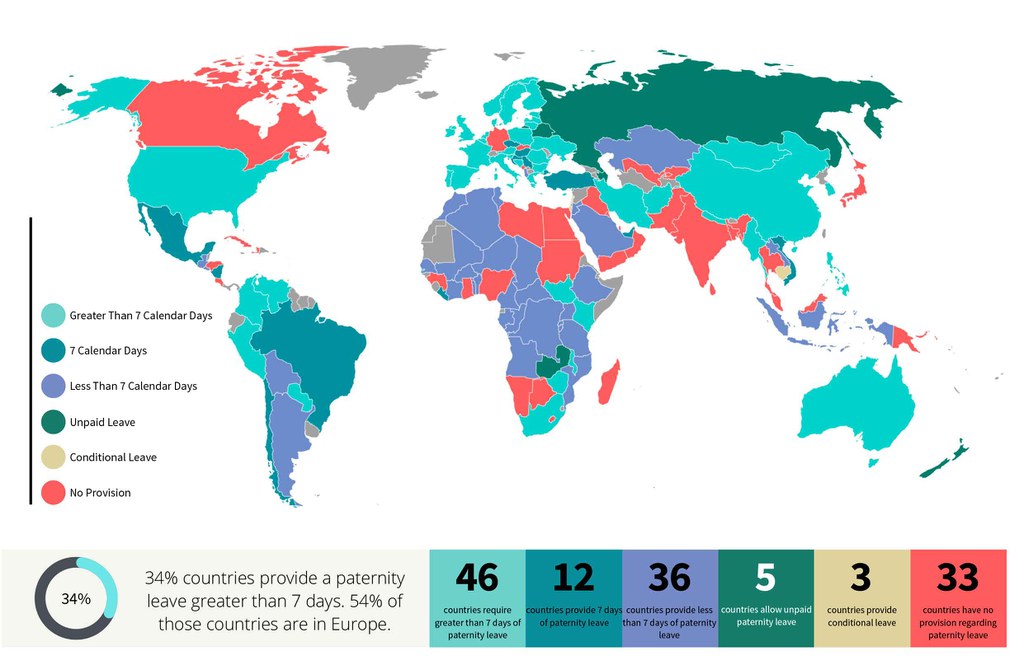
4.3 Flexible Work Arrangements
Does the law require flexible working arrangements for workers with family responsibilities?
International Regulatory Standard
Paragraph 18 of the Workers with Family Responsibilities Recommendation, 1981 (No. 165) suggests that particular attention should be given to general measures for improving working conditions and the quality of working life, including measures aiming at progressive reduction of daily hours of work and of overtime, and more flexible arrangements as regards working schedules, rest periods and holidays, account being taken of the stage of development and the particular needs of the country and of different sectors of activity.
Article 9(2) of the Part-Time Work Convention, 1994 (No. 175) states that measures should include the review of laws and regulations that may prevent or discourage recourse to or acceptance of part-time work. Special attention, in employment policies, to the needs and preferences of specific groups such as the unemployed, workers with family responsibilities, older workers, workers with disabilities and workers undergoing education or training needs to be there.
Methodology
Whether flexible working arrangements are available to workers with family responsibilities:
1: The labour legislation allows flexible work arrangements for workers with family responsibilities.
0: The labour legislation does not provide access to part-time work or flexible work for workers with family responsibilities.
67% of the 135 countries do not provide access to part-time work or flexible work for workers with family responsibilities.
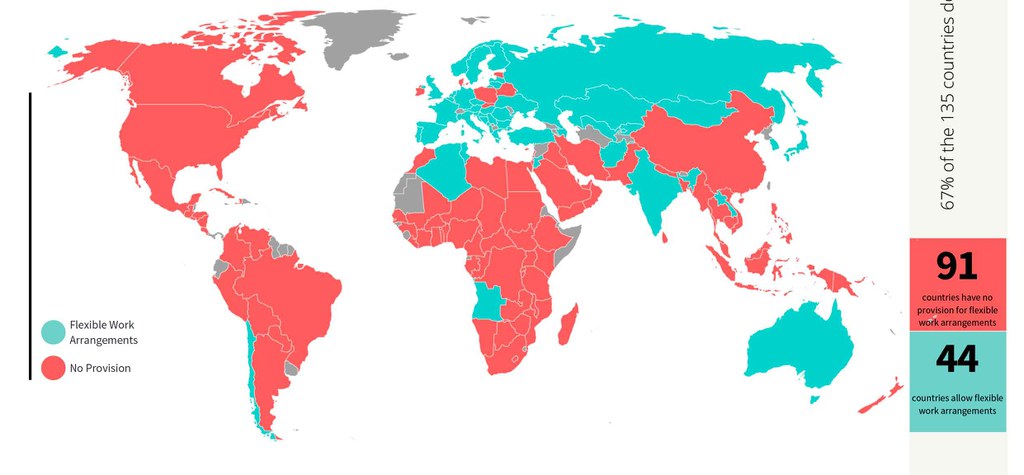
4.4 Paid Nursing Breaks
Does the law require paid nursing breaks?
International Regulatory Standard
Article 10 of the Maternity Protection Convention, 2000 (No. 183) requires that a woman worker must be provided with the right to one or more daily breaks or a daily reduction of hours of work to breastfeed her child. The period during which nursing breaks or the reduction of daily hours of work are allowed, their number, the duration of nursing breaks and the procedures for reducing daily hours of work shall be determined by national law and practice.
These breaks or the reduction of daily work hours shall be counted as working time and remunerated accordingly.
Methodology
Whether there are paid nursing breaks:
1: The labour legislation requires the provision of paid nursing breaks until the infant is six months old.
These nursing breaks can either be during the working day or can also take the form of reduced working hours.
0: Labour legislation does not require employers to grant fully paid nursing breaks to workers until the infant is six months old.
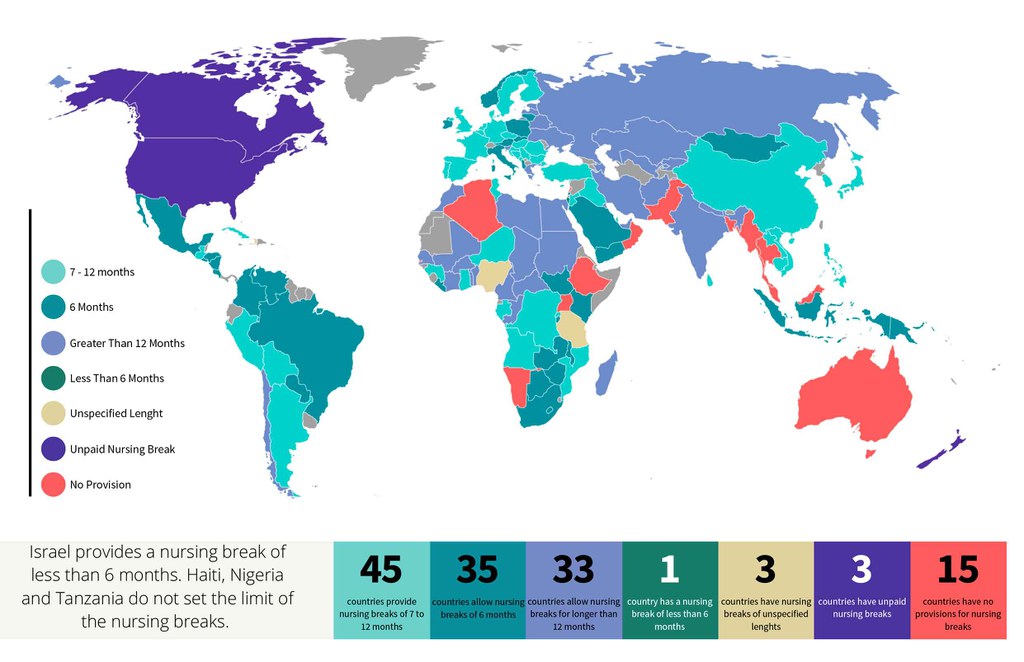
Family Responsibilities - Snapshot
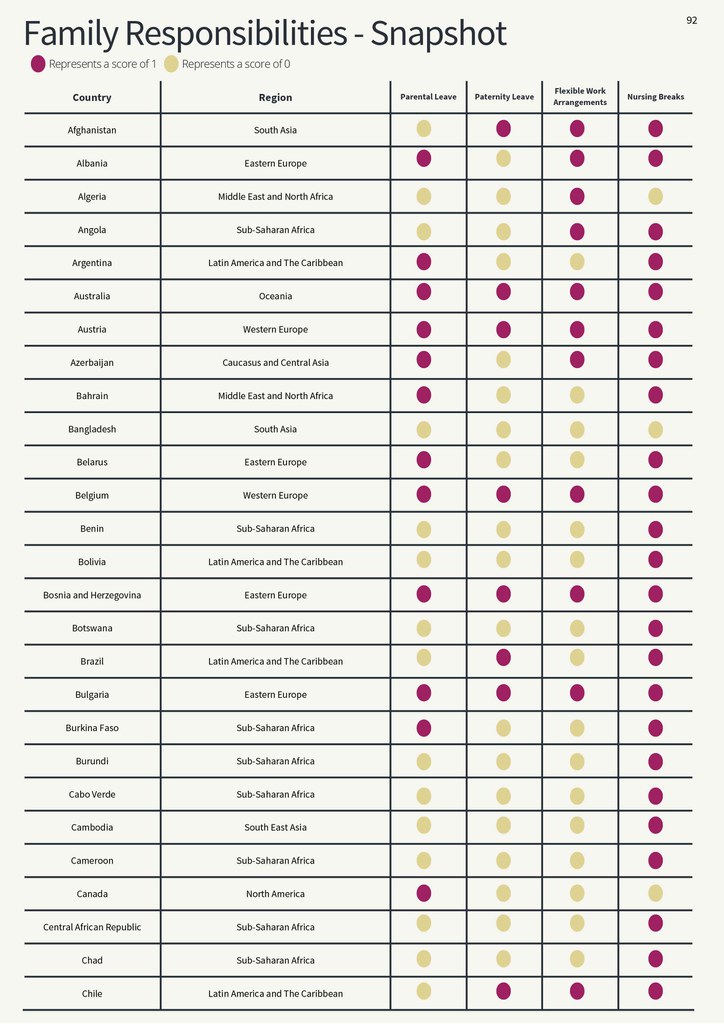
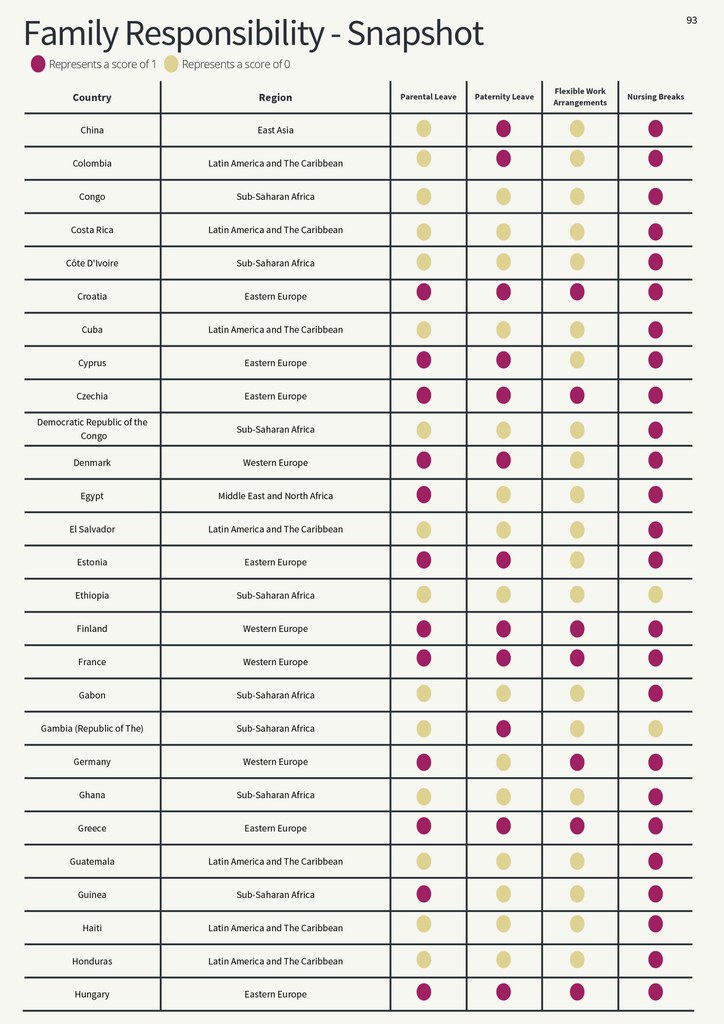
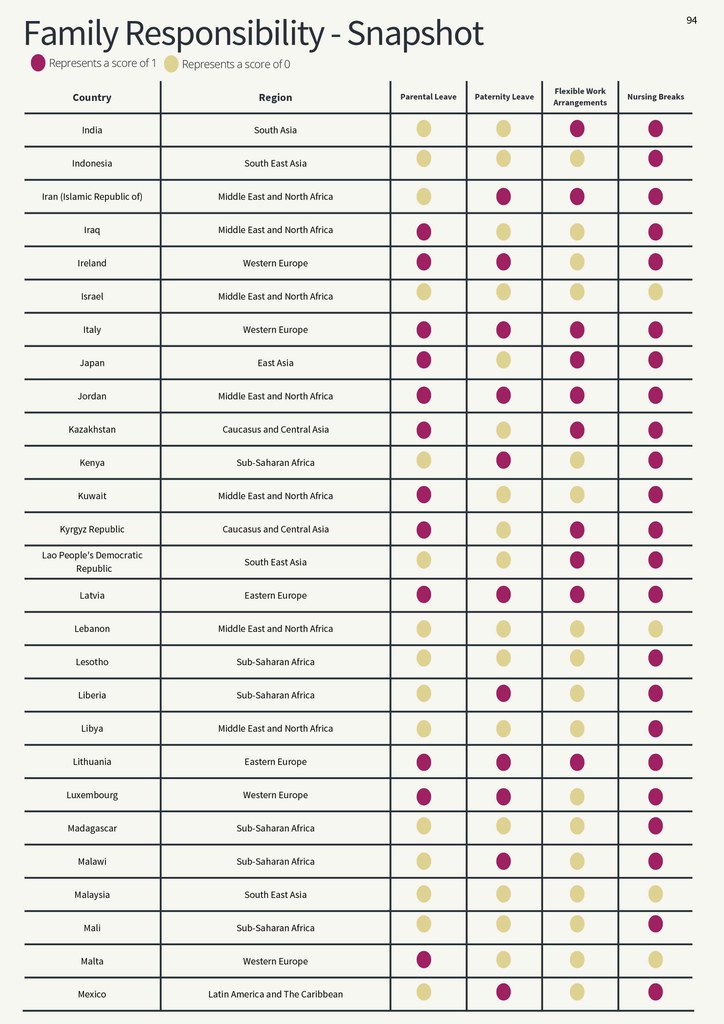
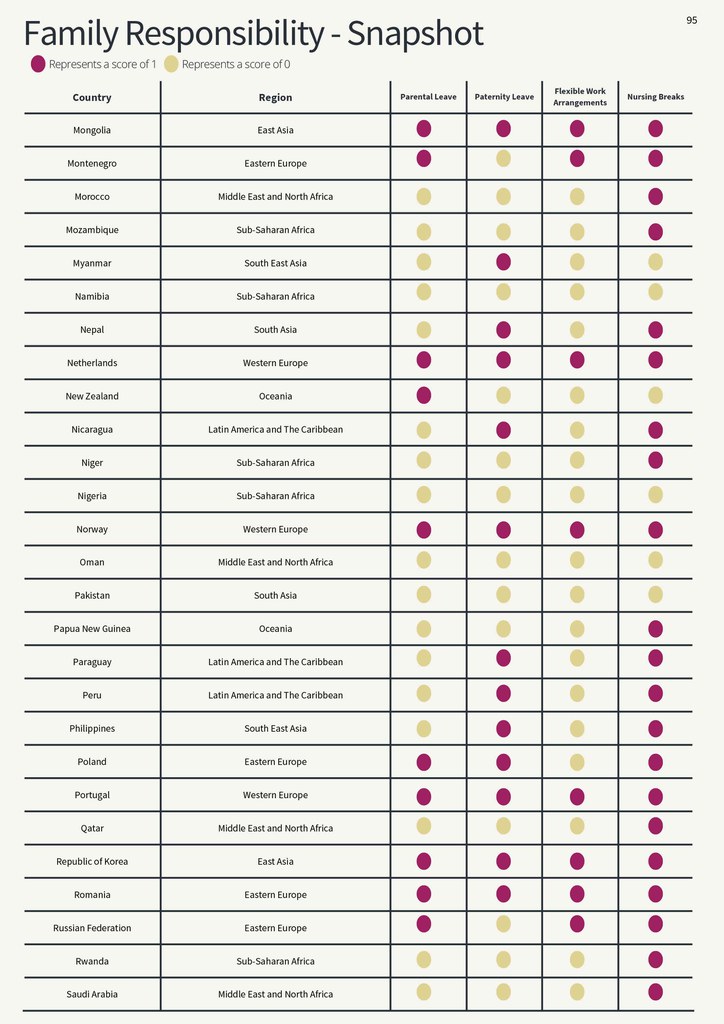
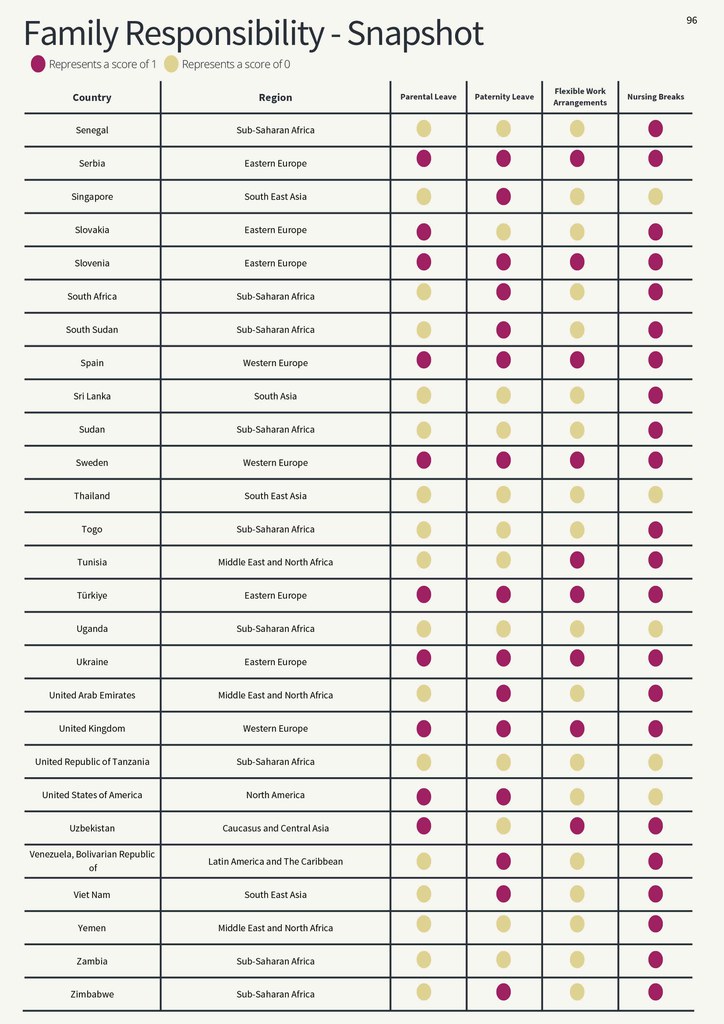
Maternity At Work
Maternity protection allows women to successfully combine their productive and reproductive roles without compromising one at the cost of another. Similarly, it protects women from discrimination in the labour market due to their reproductive roles. The Maternity at Work indicator measures whether labour legislation ensures that workers get paid maternity leave and are protected from dismissal during and on account of pregnancy.
5.1 Pregnancy Inquiry During Recruitment
Does the law prohibit inquiring about pregnancy during recruitment?
International Regulatory Standard
Article 9 of the Maternity Protection Convention, 2000 (No. 183) focuses on adopting appropriate measures to ensure that maternity does not constitute a source of discrimination in employment, including access to employment. Measures need to include a prohibition from requiring a test for pregnancy or a certificate of such a test when a woman is applying for employment, except where required by national laws or regulations in respect of work that is prohibited or restricted for pregnant or nursing women under national laws or regulations, or where there is a recognised or significant risk to the health of the woman and child.
Methodology
Whether law prohibits inquiring about pregnancy during recruitment:
1: Labour legislation prohibits employers from inquiring about pregnancy (through pregnancy testing or other means) during recruitment.
0: There is no prohibition in the law on inquiring about pregnancy/family planning during recruitment or making it a recruitment condition.
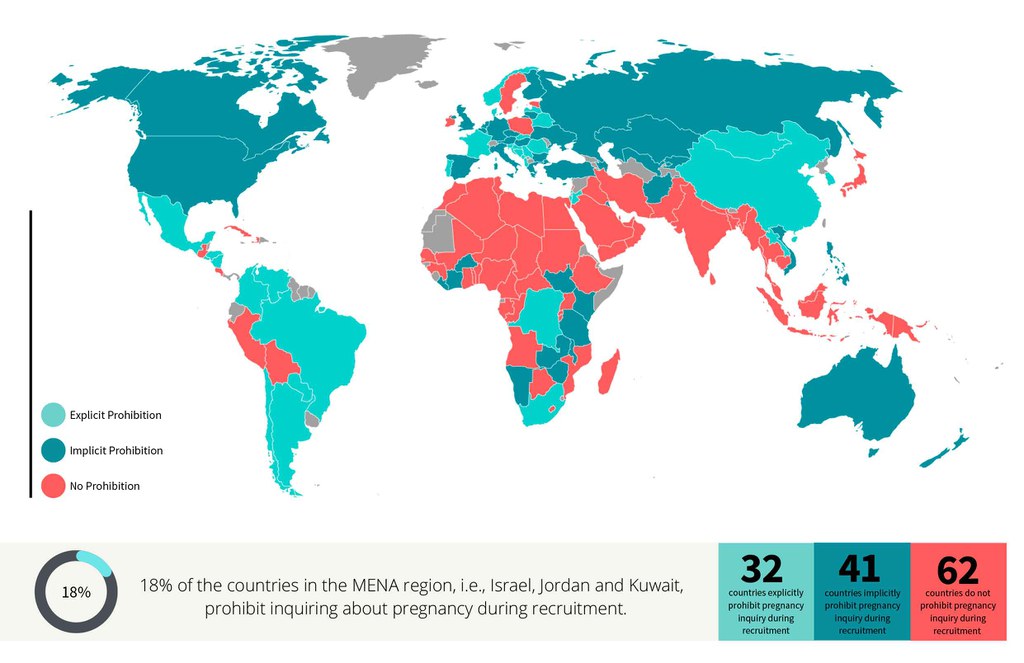
5.2 Maternity Leave
Does the law require paid maternity leave of at least 14 weeks?
International Regulatory Standard
Article 4 of the Maternity Protection Convention, 2000 (No. 183) stipulates that a woman worker shall be entitled to a maternity leave of at least 14 weeks. With due regard to the protection of the health of the mother and that of the child, maternity leave shall include a period of six weeks of compulsory leave after childbirth unless otherwise agreed at the national level by the government and the representative organisations of employers and workers.
Methodology
Whether maternity leave is available for 14 weeks:
1: Pregnant workers have the right to maternity leave of at least 14 weeks.
0: The length of maternity leave is less than 14 weeks.
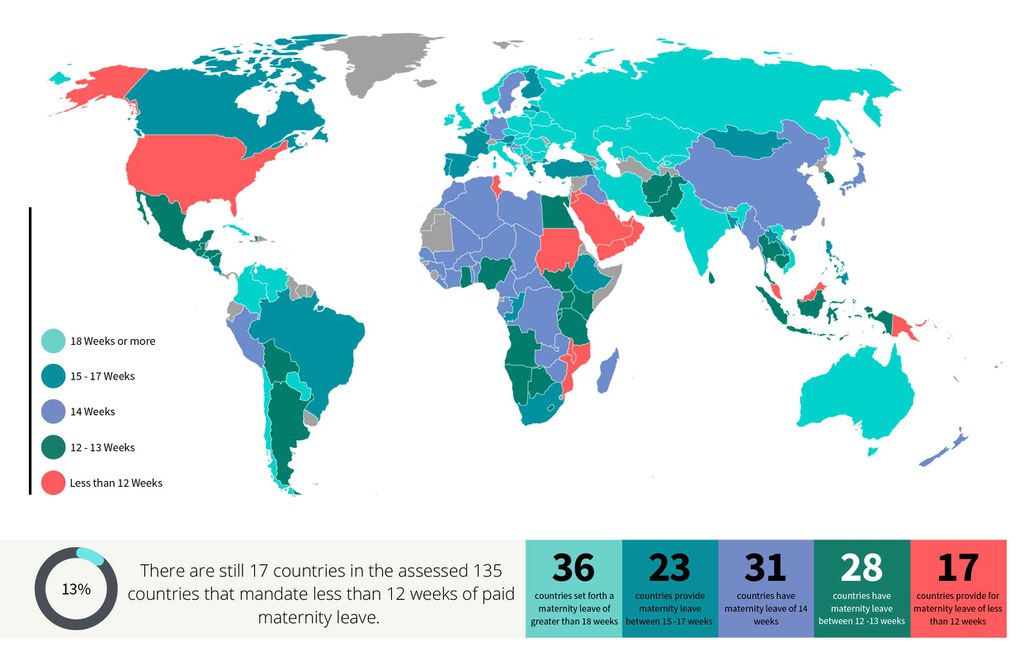
5.3 Maternity Benefits
Does the law require cash maternity benefits to be at least two-third of a worker's former wage?
International Regulatory Standard
Article 6 of the Maternity Protection Convention, 2000 (No. 183) shares that cash benefits shall be provided, in accordance with national laws and regulations, or in any other manner consistent with the national practice, to women who are absent from work on leave, and at a level which ensures that the woman can maintain herself and her child in proper conditions of health and with a suitable standard of living. The amount of such benefits shall not be less than two-thirds of the woman’s previous earnings or of such of those earnings as are taken into account for the purpose of computing benefits.
Methodology
Whether maternity leave benefit is at least two-third of the worker’s former wage:
1: Maternity leave benefit is two-third or higher than the pregnant worker’s former wage. In cases where the maternity leave is over and above 14 weeks, the score will remain 1 if the payment for maternity leave through social insurance or universal benefits is at least two-thirds of the former wage for at least the first 14 weeks. In cases where workers are paid flat rate maternity benefits, these must be at least two-thirds of the applicable minimum wage.*
0: Maternity leave benefit is less than the above threshold.
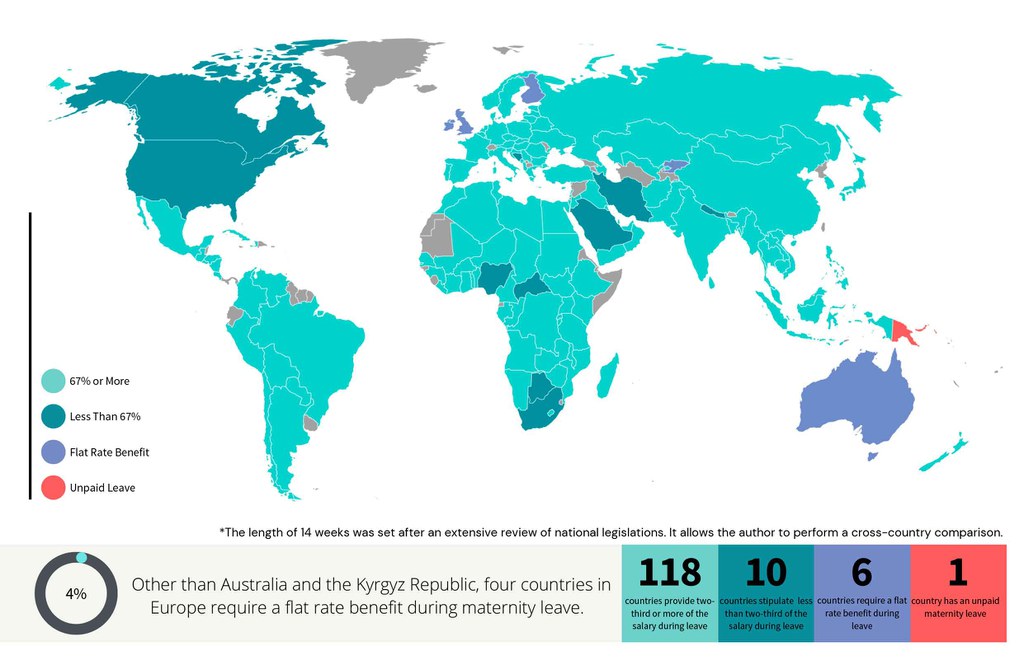
5.4 Source of Maternity Benefits
Does the law require maternity benefits be paid through contributory social insurance or universal benefits system?
International Regulatory Standard
Article 6(8) of the Maternity Protection Convention, 2000 (No. 183) states that in order to protect the situation of women in the labour market, benefits in respect of the leave shall be provided through compulsory social insurance or public funds or in a manner determined by national law and practice. An employer shall not be individually liable for the direct cost of any such monetary benefit to a woman employed by them without that employer’s specific agreement except where such is provided for in national law prior to the introduction of this Convention or it is subsequently agreed at the national level by the government and the representative organisations of employers and workers.
Methodology
Whether maternity benefit is employer liability:
1: Maternity benefit is paid through a contributory social insurance system or through a non-contributory universal benefits system financed through general taxation.
0: Maternity benefit is only employer liability, and employers are required to pay workers their wages during maternity leave.
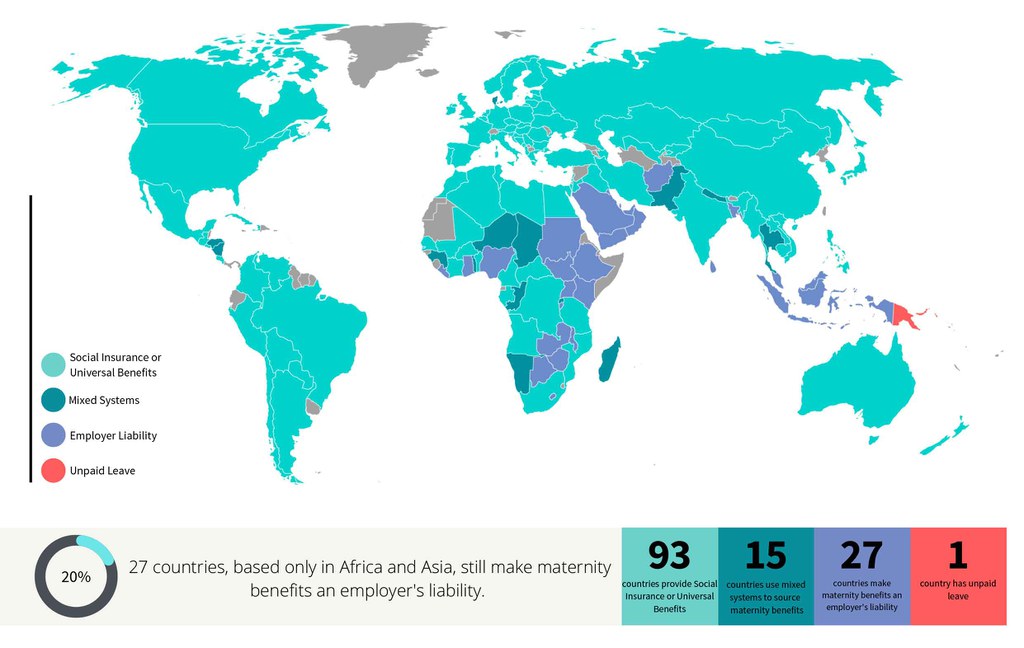
5.5 Dismissals During Pregnancy
Does the law protect workers from dismissals during or on account of pregnancy?
International Regulatory Standard
Article 8 of the Maternity Protection Convention, 2000 (No. 183) stipulates that it is unlawful for an employer to terminate the employment of a woman during her pregnancy or absence on leave or during a period following her return to work, except on grounds unrelated to the pregnancy or birth of the child and its consequences or nursing.
Moreover, a woman is guaranteed the right to return to the same position or an equivalent position paid at the same rate at the end of her maternity leave.
Article 11 (2)(a) of the UN Convention on the Elimination of All Forms of Discrimination against Women (CEDAW) states that to prevent discrimination against women on the grounds of marriage or maternity and to ensure their effective right to work, appropriate measures should be taken, including the prohibition on, subject to the imposition of sanctions, dismissal on the grounds of pregnancy or of maternity leave and discrimination in dismissals based on marital status.
Methodology
Whether law protects workers from dismissal during pregnancy:
1: The legislation prohibits employers from terminating workers during or on account of pregnancy (e.g., medically certified sickness related to pregnancy) except in cases of gross misconduct.
0: The legislation does not protect workers from dismissal during or on account of pregnancy.
87% of the countries prohibit dismissal during or on account of pregnancy.
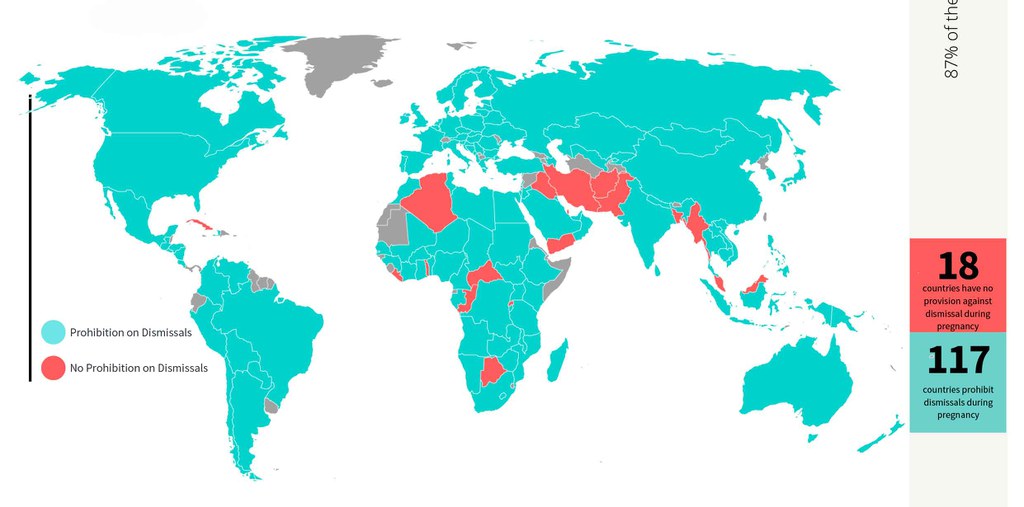
Maternity at Work - Snapshot
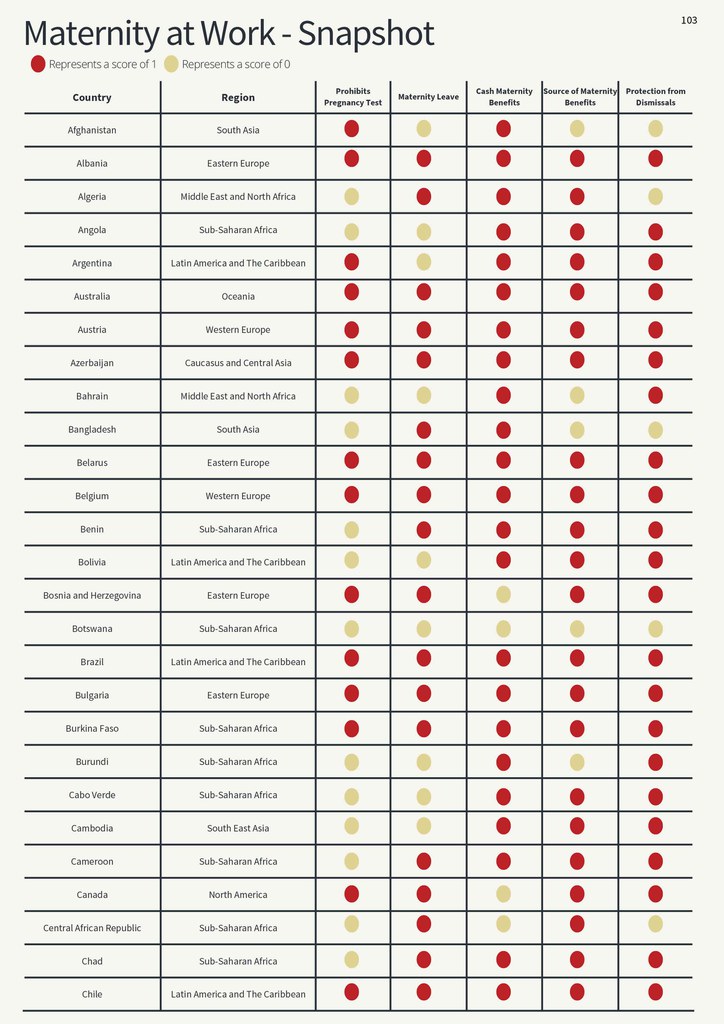
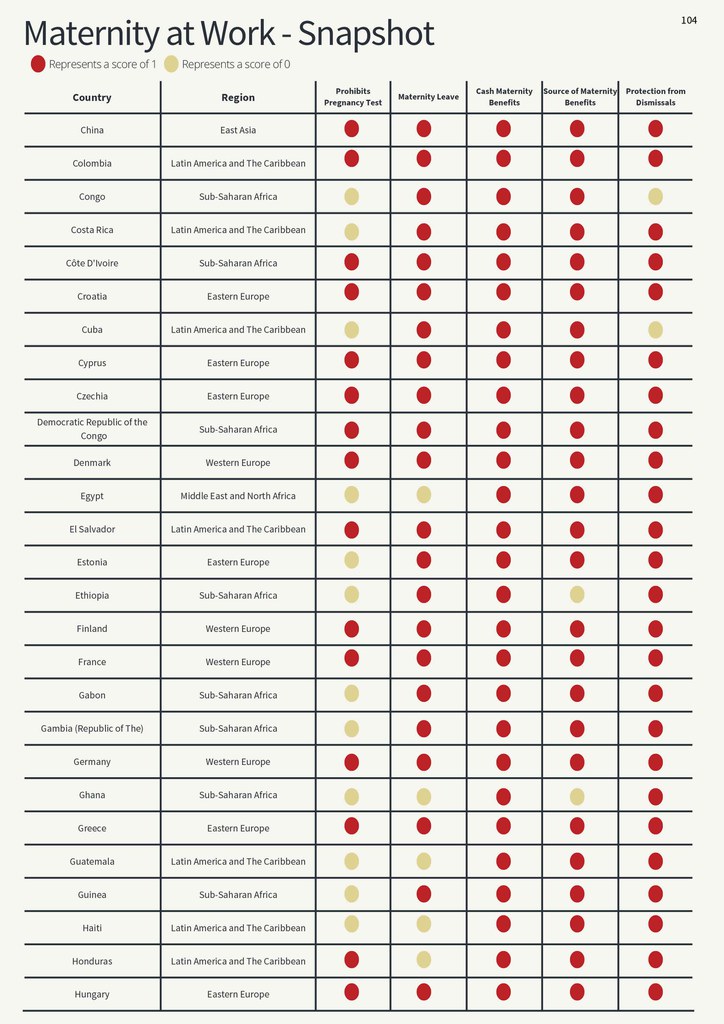
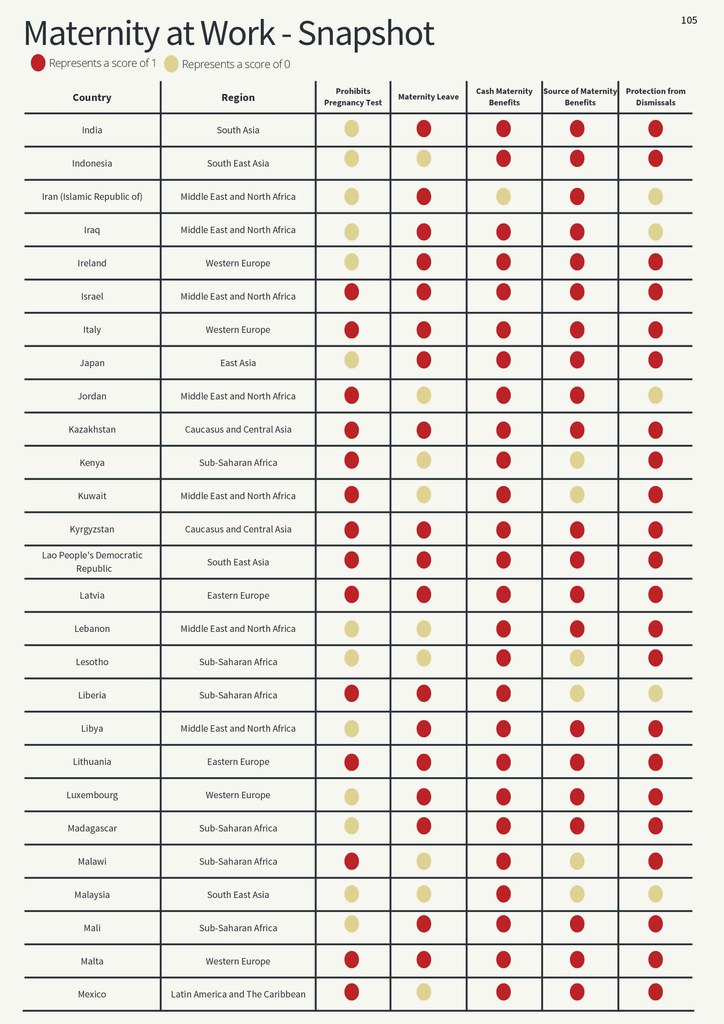
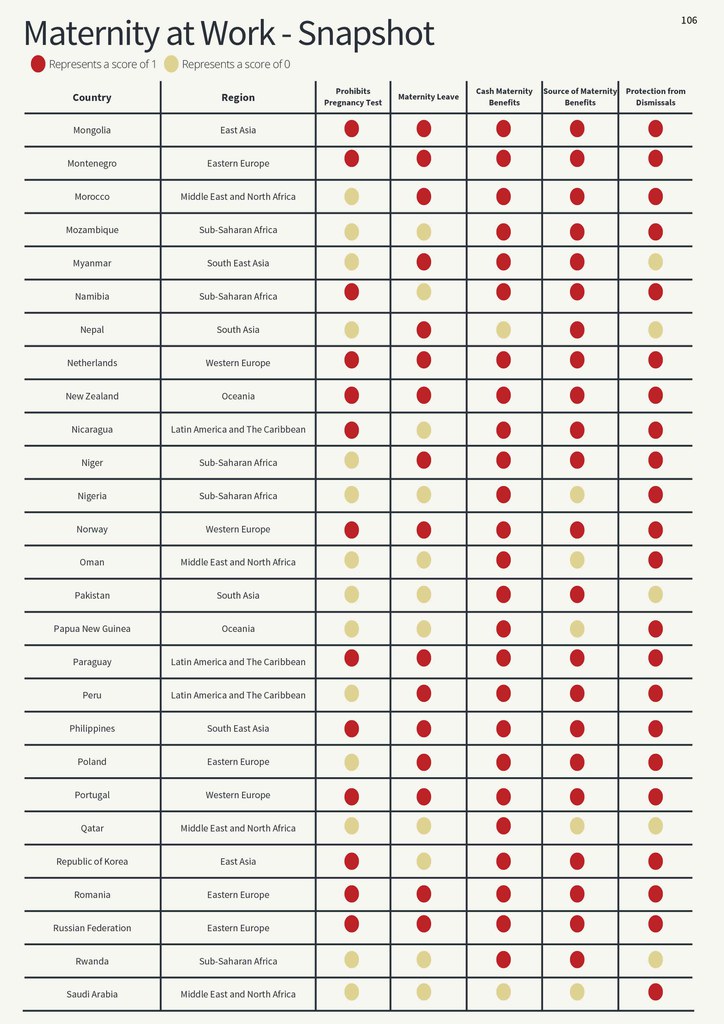

Safe Work
Decent work, in essence, is safe work. The Safe Work indicator measures whether labour legislation ensures that workers are trained about health and safety issues before the commencement of work and whether the employer provides free personal protective equipment to workers.
It also measures countries' compliance on restrictions on arduous work for pregnant workers and whether countries provide some kind of employment injury benefits.
6.1 Free Personal Protective Equipment
Does the law require employers to provide free personal protective equipment to workers?
International Regulatory Standard
Article 16 of the Occupational Safety and Health Convention, 1981 (No. 155) states that employers shall be required to ensure that, so far as is reasonably practicable, the workplaces, machinery, equipment and processes under their control are safe and without health risk; and that the chemical, physical and biological substances and agents under their control are without health risk when the appropriate measures of protection are taken. Also, the employers shall be required to provide, where necessary, adequate protective clothing and protective equipment to prevent, so far as is reasonably practicable, the risk of accidents or of adverse effects on health. Furthermore, Article 21 of this Convention states that occupational safety and health measures shall not involve any expenditure on the workers.
Methodology
Whether the law requires employers to provide free personal protective equipment to workers:
1: Labour legislation requires employers to provide free personal protective equipment to the workers.
0: There is no requirement to provide free personal protective equipment.
95% of the 135 countries require employers to provide free personal protective equipment to workers.

6.2 Training - Occupational Safety and Health
Does the law require the employers to train workers on health and safety issues?
International Regulatory Standard
Article 19(d) of the Occupational Safety and Health Convention, 1981 (No. 155) mentions that there should be arrangements at the level of the undertaking/enterprise under which workers and their representatives in the workplace are given appropriate training in occupational safety and health.
Methodology
Whether law requires training on health and safety issues:
1: The law requires employers to provide health and safety training to workers when they join work or are assigned some new work.
0: The legislation does not require training on health and safety issues.
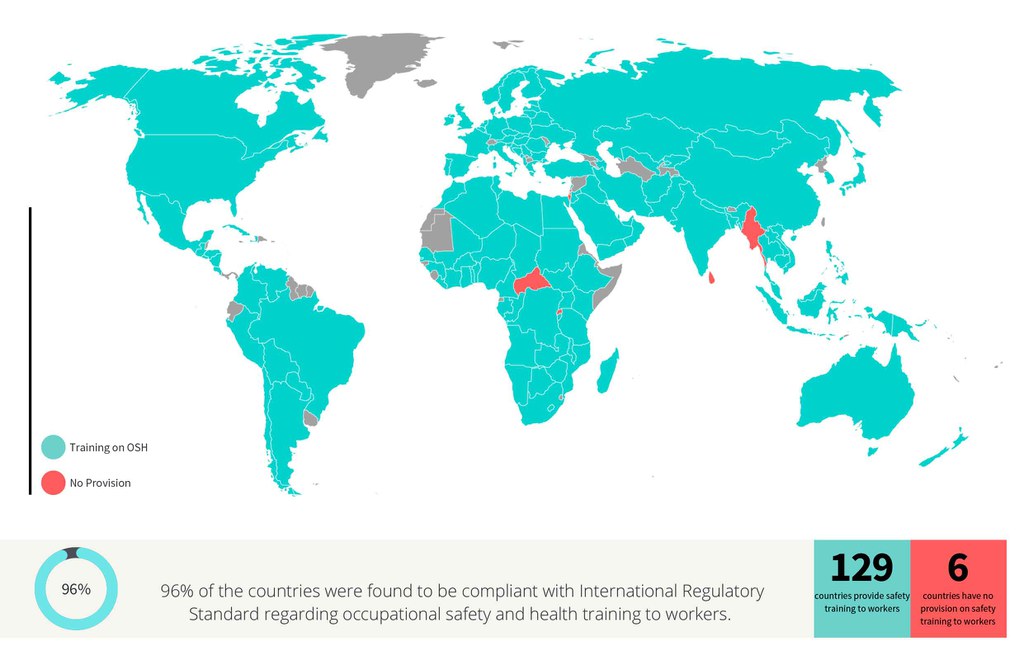
6.3 Restrictions on Work(for Pregnant or Nursing Women)
Does the law restrict work that is prejudicial to the health of the mother or the child?
International Regulatory Standard
From the Maternity Protection Convention, 2000 (No. 183), Article 3 states that after consulting the representative organisations of employers and workers, appropriate measures should be adopted to ensure that pregnant or breastfeeding women are not obliged to perform work which has been determined by the competent authority to be prejudicial to the health of the mother or the child, or where an assessment has established a significant risk to the mother’s health or that of her child.
Methodology
Whether law restricts work that is determined to be prejudicial to the health of the mother or the child:
1: The legislation restricts pregnant or nursing women from being obliged to perform arduous work and night work that is prejudicial to the health of the mother or the child. Based on the workplace assessment and medical certificate, legislation should require elimination of risk, adaptation of working conditions, transfer to another post without loss of pay, and access to paid leave when neither of the above is possible.
0: Arduous work and any of its other forms* are not restricted to pregnant or nursing workers, or there is a general prohibition only.
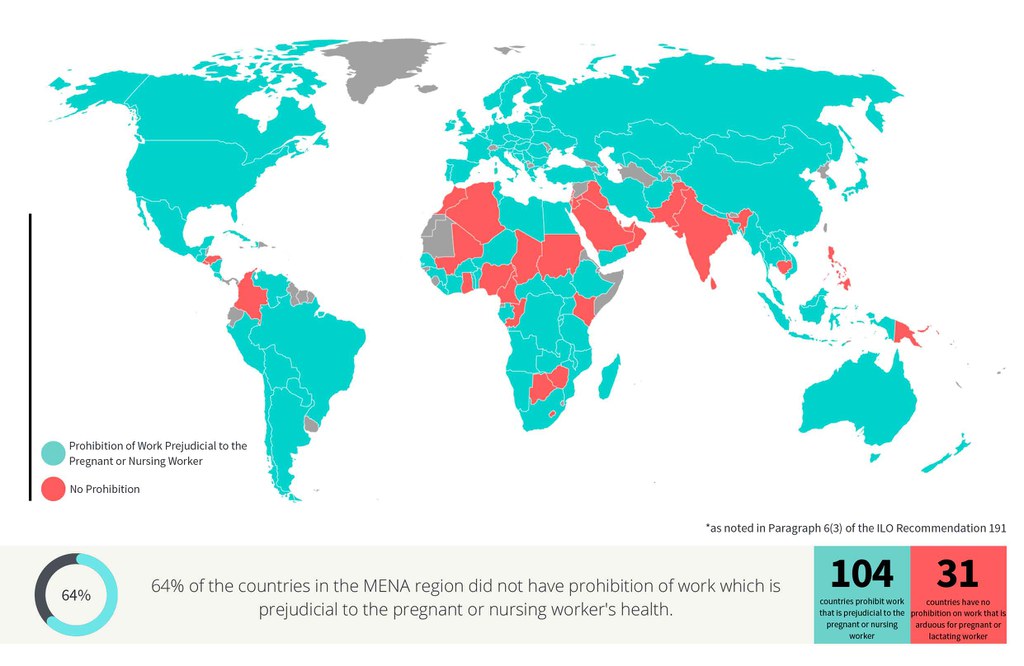
6.4 Employment Injury Benefits
Does the law provide for employment injury or disease benefits?
International Regulatory Standard
Social Security (Minimum Standards) Convention, 1952 (No. 102) stipulates the provision of employment injury benefits at the rate of at least 50 per cent (40 per cent for survivors) of a worker’s former wage. This applies to an accident or disease resulting from employment and the contingencies should cover a morbid condition; incapacity for work resulting from such a condition and involving suspension of earnings, as defined by national laws or regulations; total loss of earning capacity or partial loss thereof in excess of a prescribed degree, likely to be permanent, or corresponding loss of faculty; and the loss of support suffered by the widow or child as the result of the death of the breadwinner. In the case of a widow, the right to benefit may be made conditional on her being presumed, in accordance with national laws or regulations, to be incapable of self-support.*
Methodology
Whether legislation provides for employment injury benefits:
1: Employment injury or disease benefit is provided under the law and is paid through social insurance or where the employer pays a monthly premium to the private or public carrier (insurance provider) to provide employment injury benefits. 0: Employment injury benefit is not financed through the social insurance system (employer liability program only) or is not provided under the law.
3% of the 135 countries make employment injury benefits the employer's liability. Bangladesh, Gambia, Qatar and UAE require employers to pay benefits to workers injured on job.

Safe Work - Snapshot
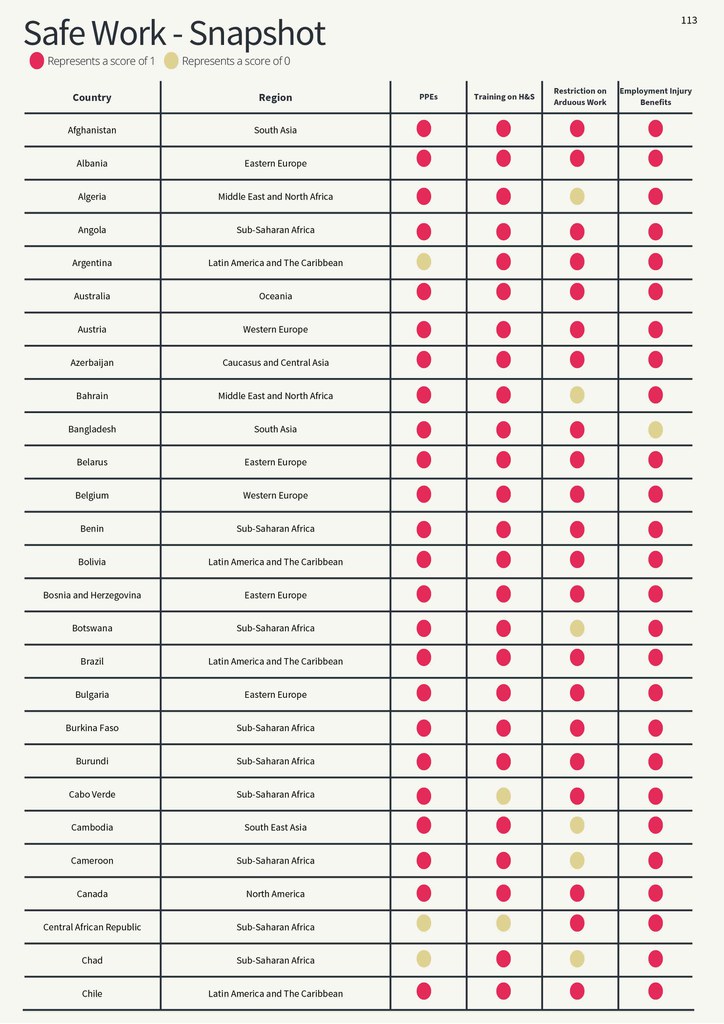
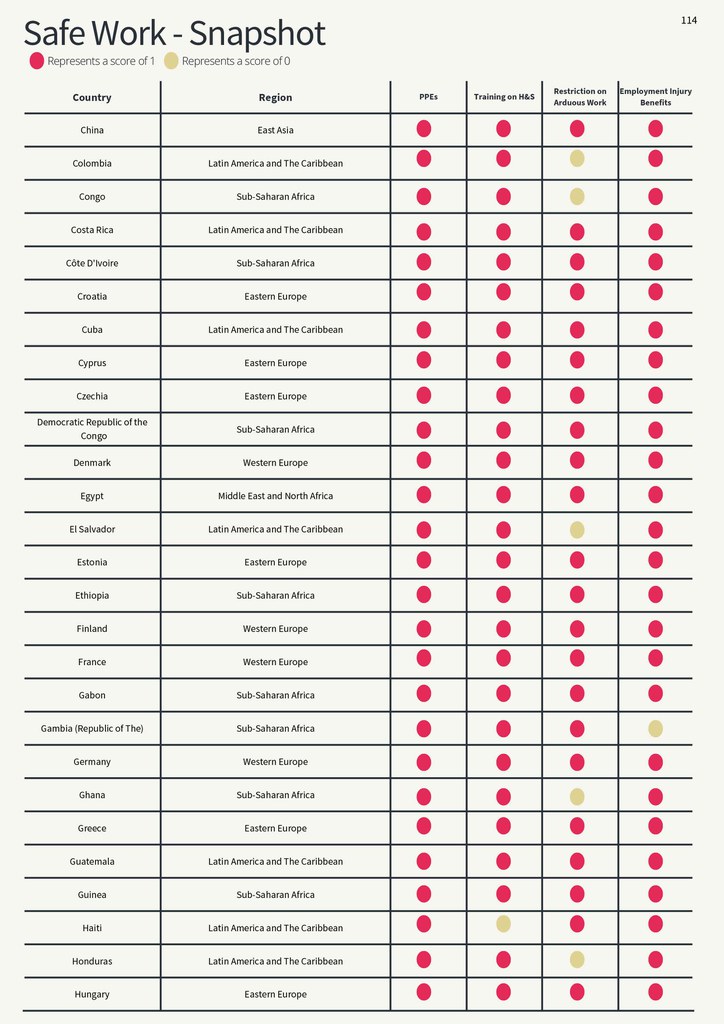

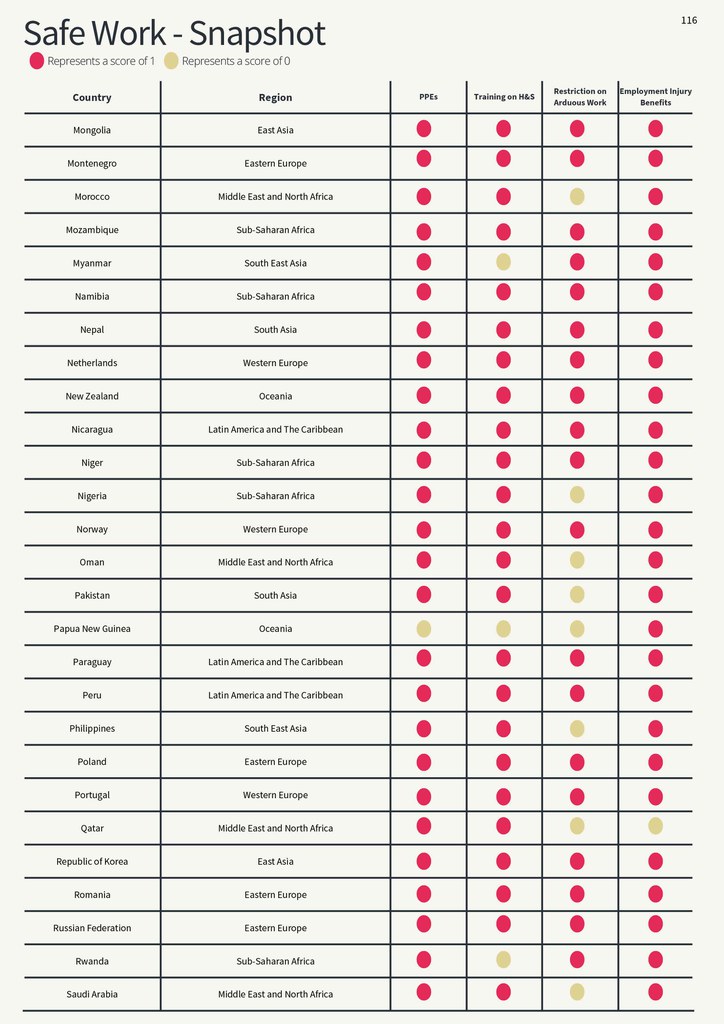
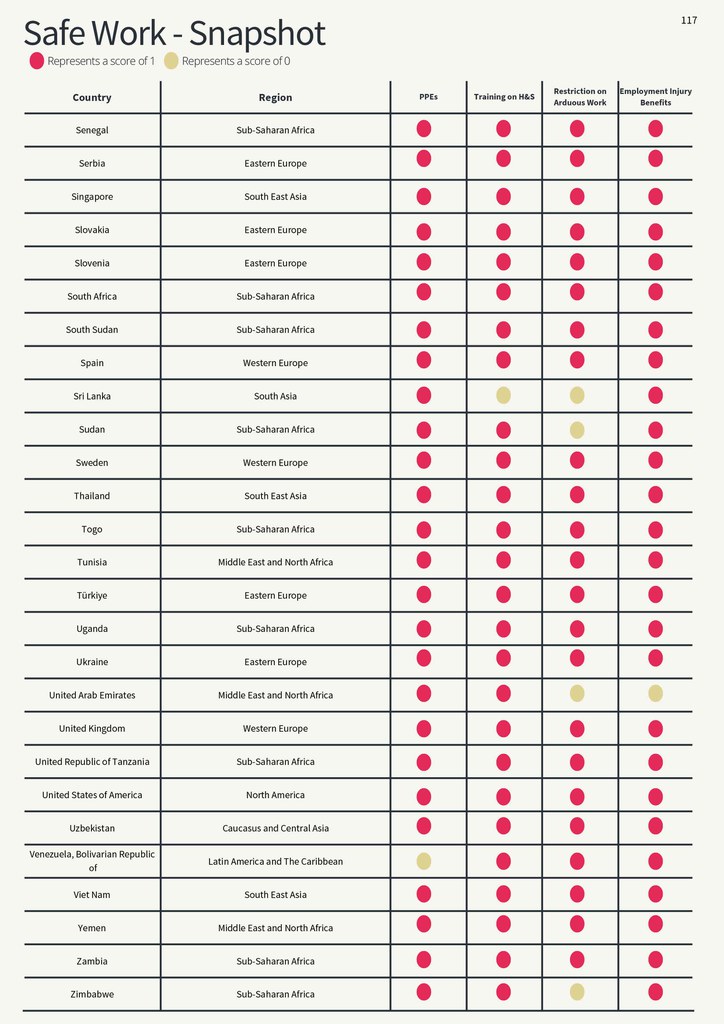
Social Security
Adequate social protection is an important aspect of decent work. Protection from the major risks in life through social protection helps keep people out of poverty and prevents them from being thrown into poverty when unforeseen catastrophes occur, such as an accident, an illness, loss of a job or in old age when work is impossible or very difficult
7.1 Old Age Pension
Does the law provide for old age pension?
International Regulatory Standard
Social Security (Minimum Standards) Convention, 1952 (No. 102) stipulates the provision of old-age benefits at the rate of 40 per cent of a worker’s former wage, where the contingency covered shall be survival beyond a prescribed age of not more than 65 years or such higher age as may be fixed by the competent authority with due regard to the working ability of elderly persons in the country concerned. National laws or regulations may provide that the benefit of a person otherwise entitled to it may be suspended if such person is engaged in any prescribed gainful activity or that the benefit, if contributory, may be reduced where the earnings of the beneficiary exceed a prescribed amount and, if non-contributory, may be reduced where the earnings of the beneficiary or his other means or the two taken together exceed a prescribed amount. The benefit shall be a periodical payment.
Methodology
Whether law provides for old-age pension:
1: Legislation creates a contributory old-age pension or if an old-age pension is paid through a non-contributory universal benefits system (both administered by the state).*
0: There is no explicit provision for the state-administered old age pension, it is employer liability, or the old age pension is means-tested.
87% of the assessed countries provide for a contributory old age pension, funded through a social insurance system.
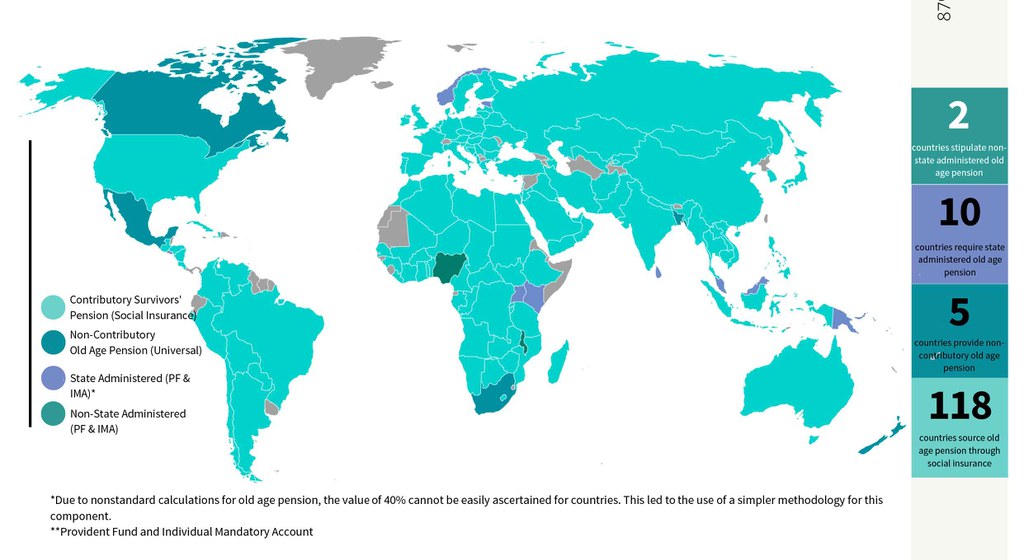
7.2 Dependents'/Survivors' Pension
Does the law provide for dependents'/survivors' pension?
International Regulatory Standard
Social Security (Minimum Standards) Convention, 1952 (No. 102) stipulates the provision of survivors’ benefits for wives and children of breadwinners at the rate of at least 40 per cent of the worker’s wage, where the contingency covered shall include the loss of support suffered by the widow or child as the result of the death of the breadwinner; in the case of a widow, the right to benefit may be made conditional on her being presumed, in accordance with national laws or regulations, to be incapable of self-support. National laws or regulations may provide that the benefit of a person otherwise entitled to it may be suspended if such person is engaged in any prescribed gainful activity or that the benefit, if contributory, may be reduced where the earnings of the beneficiary exceed a prescribed amount, and, if non- contributory, may be reduced where the earnings of the beneficiary or his other means or the two taken together exceed a prescribed amount. The benefit shall be a periodical payment.
Methodology
Whether law provides for survivors' /dependents’ pension:
1: The legislation provides for contributory social insurance or non-contributory universal benefits for the survivors’ or dependents’ pension in the event of workers’ or pensioners’ death once they are eligible for old-age pension or disability pension (both administered by the state).*
0: There is no explicit provision for state-administered survivors’ pension or is the employer’s liability or if survivors’ pension is means-tested.
Only 5% of the assessed countries require payment of survivors' pension through state administered provident funds and individual mandatory accounts.
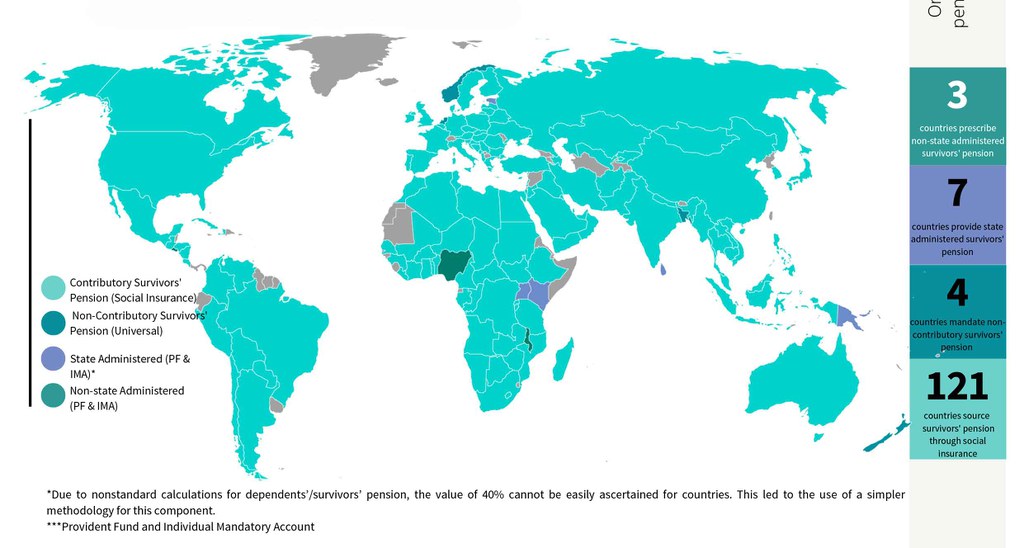
7.3 Unemployment Benefits
Does the law provide for unemployment benefits?
International Regulatory Standard:
Social Security (Minimum Standards) Convention, 1952 (No. 102) stipulates the provision of unemployment benefits at the rate of at least 45 per cent of a worker’s former wage, where the contingency covered should include earnings’ suspension as defined by national laws or regulations, due to inability to obtain suitable employment in the case of a person protected who is capable of, and available for, work. The minimum duration of the benefit shall be a periodical payment for 13 weeks in a period of 12 months or periodical payment for 26 weeks within 12 months where all residents whose means during the contingency do not exceed prescribed limits.
Methodology:
Whether law provides for unemployment benefits:
1: The legislation provides for unemployment benefits when a worker loses employment, either through a contributory social insurance system or a non- contributory universal benefits system.*
0: There is no explicit provision for a state-administered unemployment benefits system or where unemployment benefits are means-tested or where only severance pay is provided.
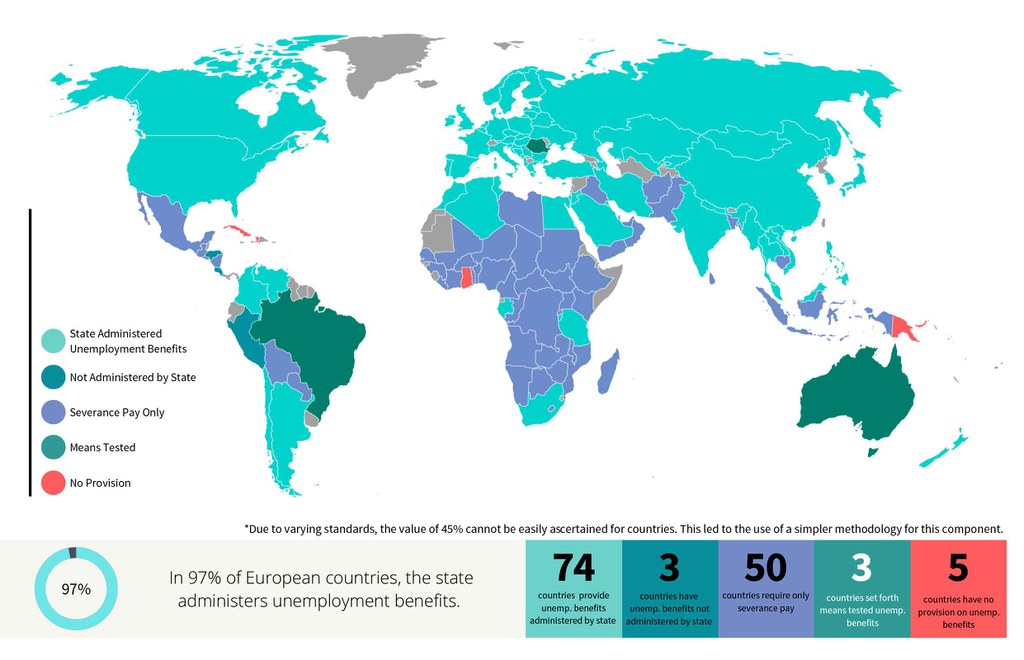
7.4a Sickness Benefits - Duration
Does the law require paid sick leave for the first six months of sickness?
International Regulatory Standard
Social Security (Minimum Standards) Convention, 1952 (No. 102) stipulates the provision of sickness benefits at the rate of at least 45 per cent of a worker’s former wage, where the contingency covered should include incapacity for work resulting from a morbid condition and involving suspension of earnings, as defined by national laws or regulations. The benefit shall be a periodical payment for the whole of contingency and limited to 26 weeks in each case of sickness, in which event it need not be paid for the first three days of suspension of earnings or where all residents whose means during the contingency do not exceed prescribed limits are protected.
Methodology
Whether law provides for paid sick leave for the first six months of sickness:
1: The legislation allows paid sick leave or sickness benefits for a minimum of the first six months of illness. The paid sick leave/sickness benefits must have been funded through a contributory social insurance system or universally accessible system.
0: Paid sick leave/sickness benefits are less than six months or if it is paid after a more than 10-day waiting period, or if it is only employer liability.
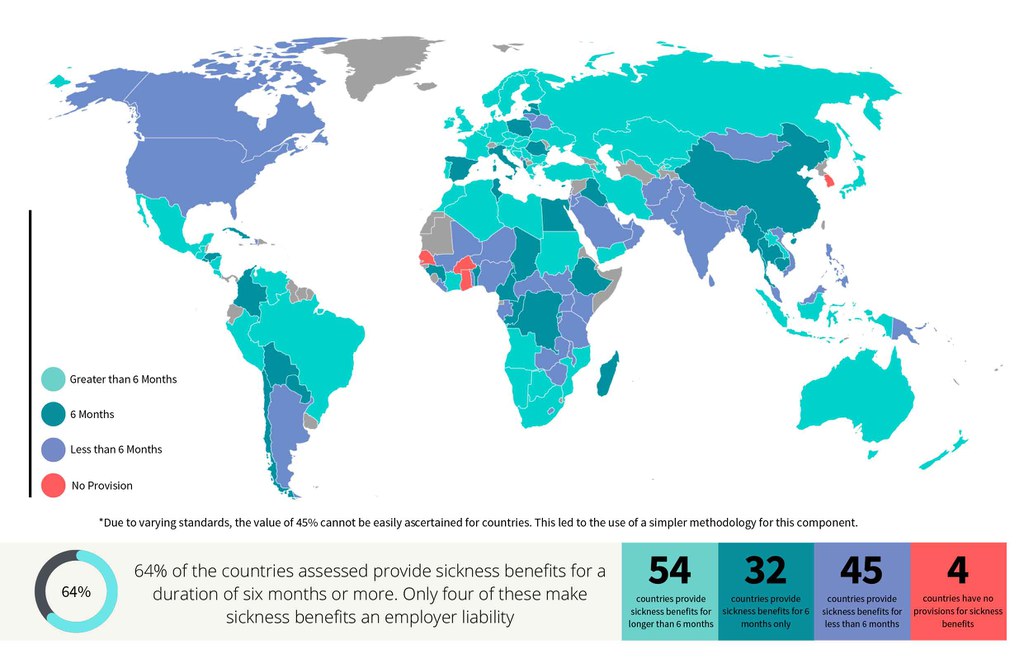
7.4b Sickness Benefits - Source
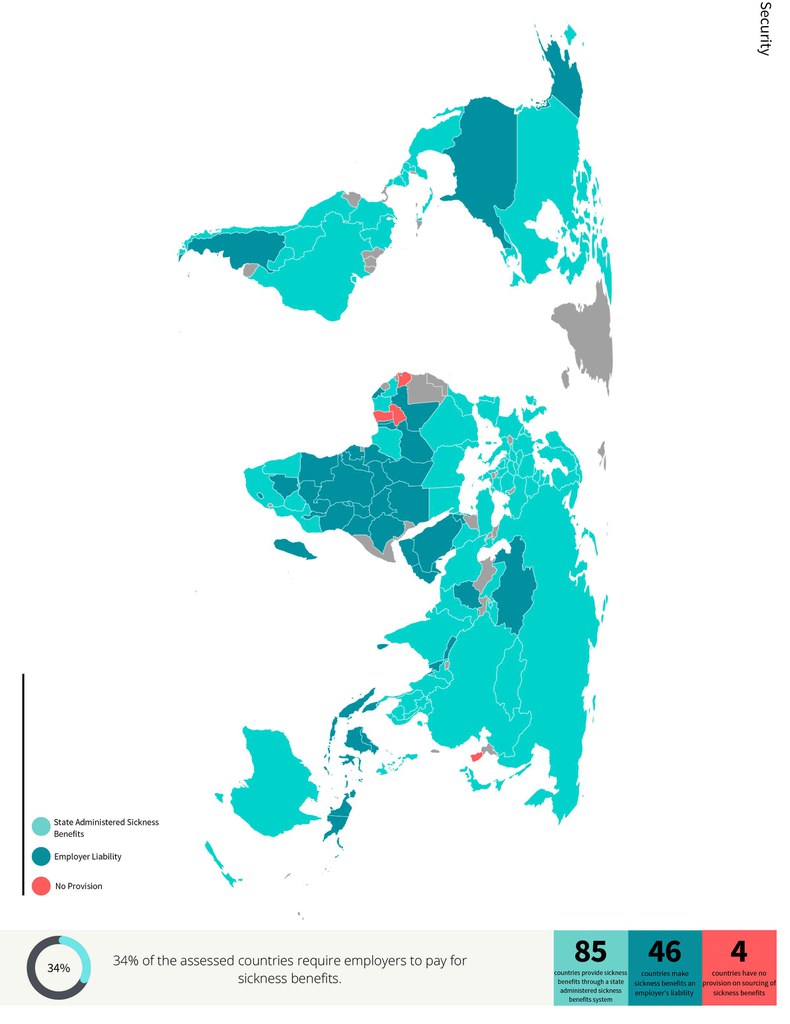
7.5 Invalidity Pension
Does the law provide for invalidity pension?
International Regulatory Standard
Social Security (Minimum Standards) Convention, 1952 (No. 102) stipulates the provision of invalidity benefit at the rate of 40 per cent of a worker’s former wage, where the contingency covered shall include the inability to engage in any gainful activity to an extent prescribed which inability is likely to be permanent or persists after the exhaustion of sickness benefit. The benefit shall be a periodical payment, and it shall be granted throughout the contingency or until an old- age benefit becomes payable.
Methodology
Whether legislation provides for invalidity pension:
1: Occupational disability or invalidity pension is provided under the law and is paid through a contributory social insurance system or through a non-contributory universal benefits system financed through general taxation (both administered by the state).*
0: The invalidity pension is only employer liability or means-tested, or if there is no explicit provision for a state-administered invalidity pension.
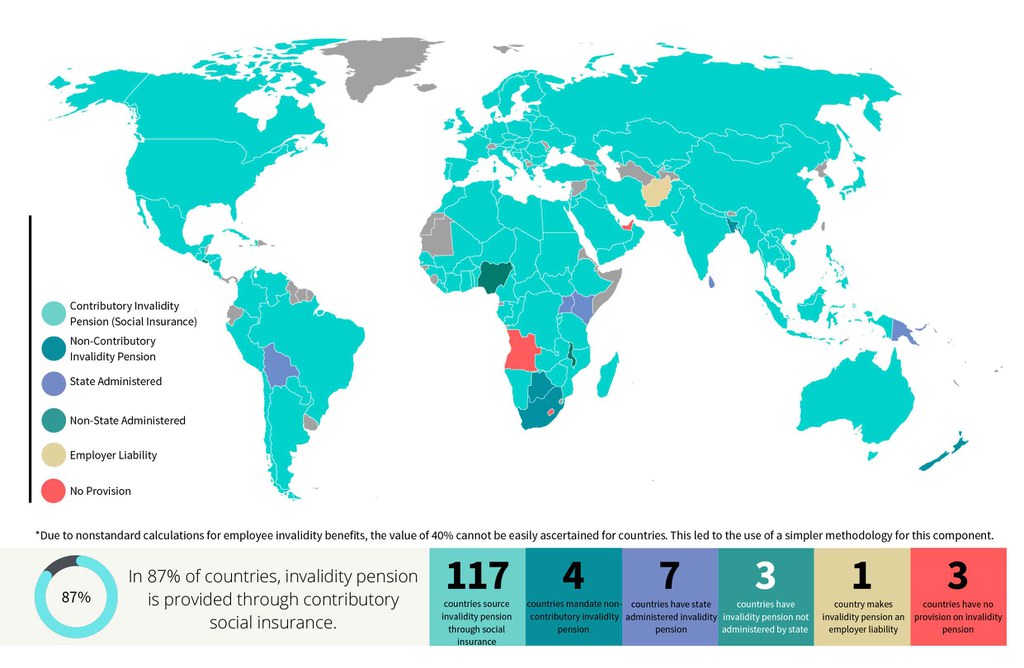
Social Security - Snapshot
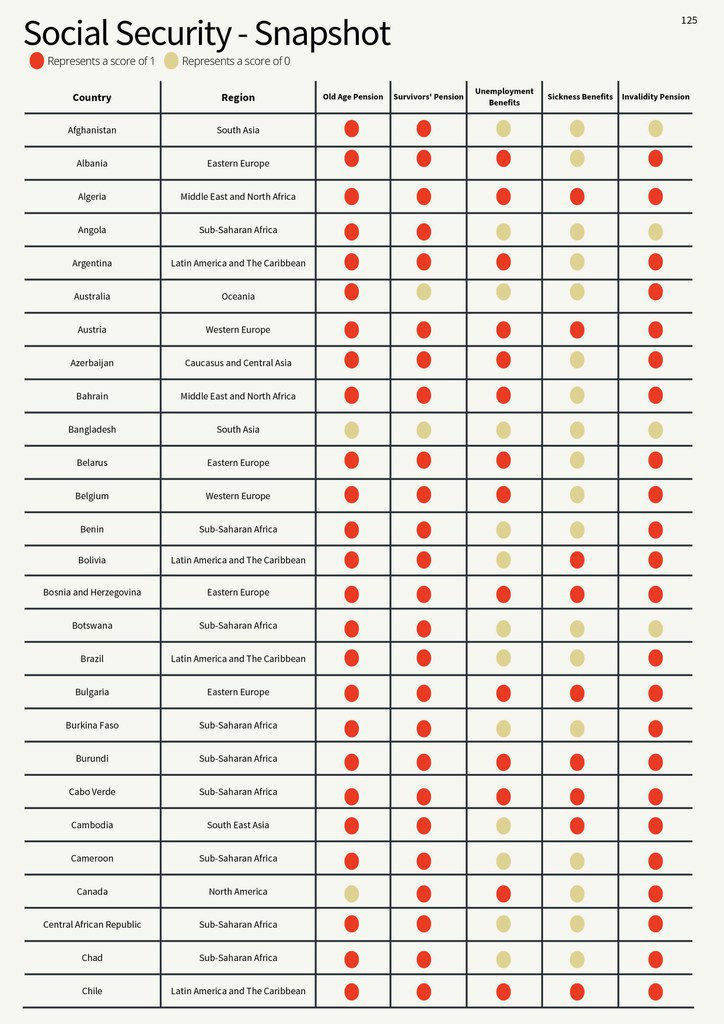
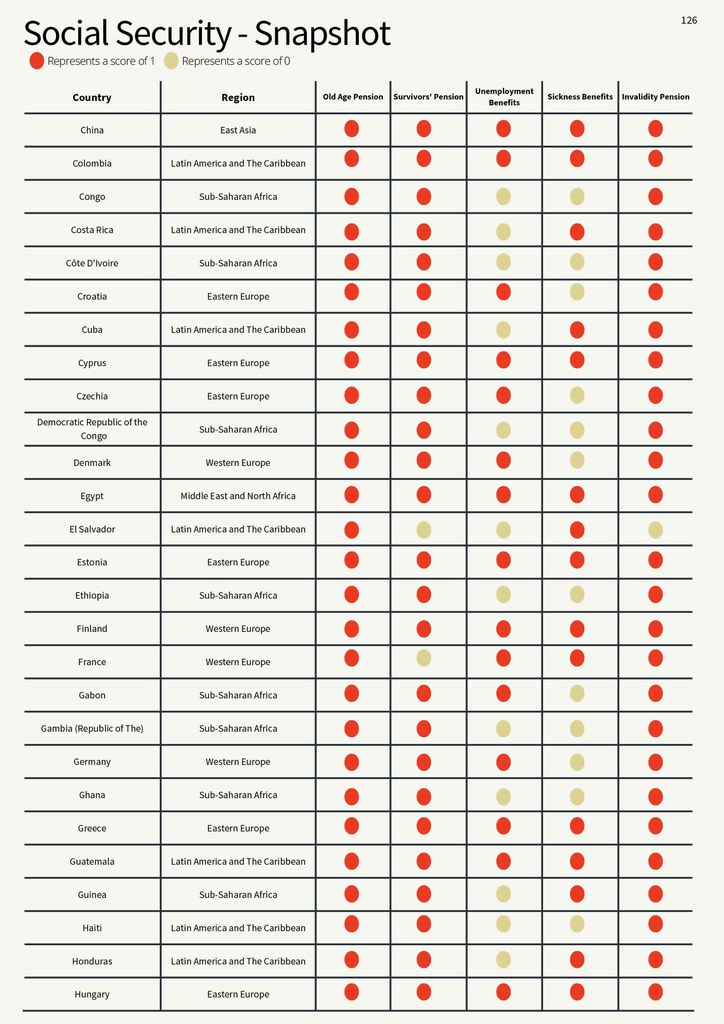
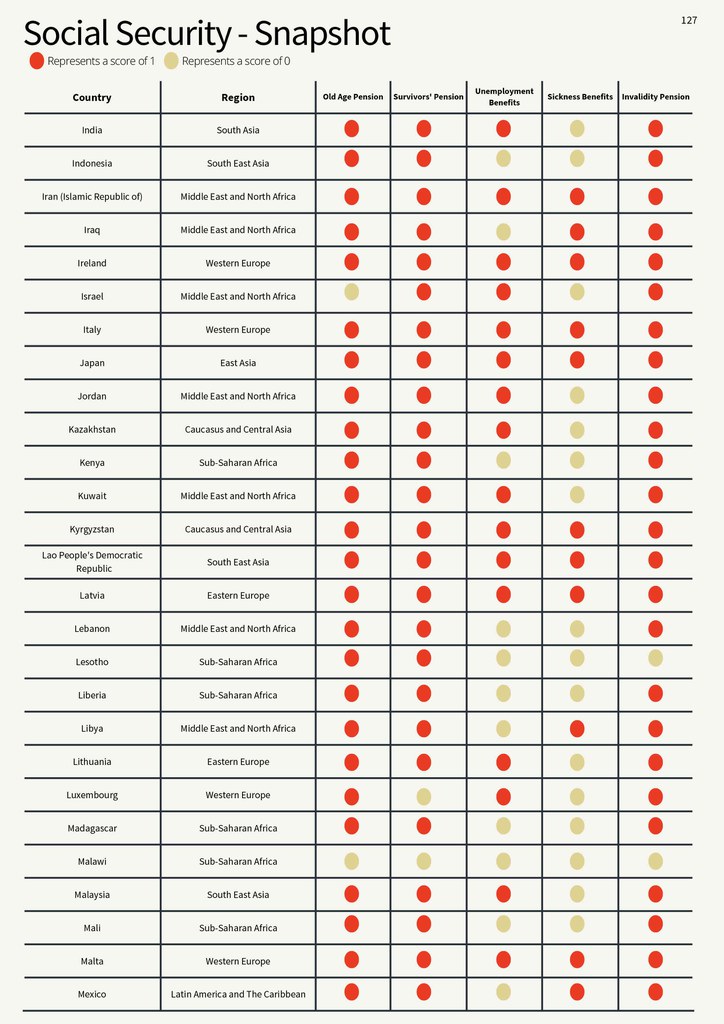
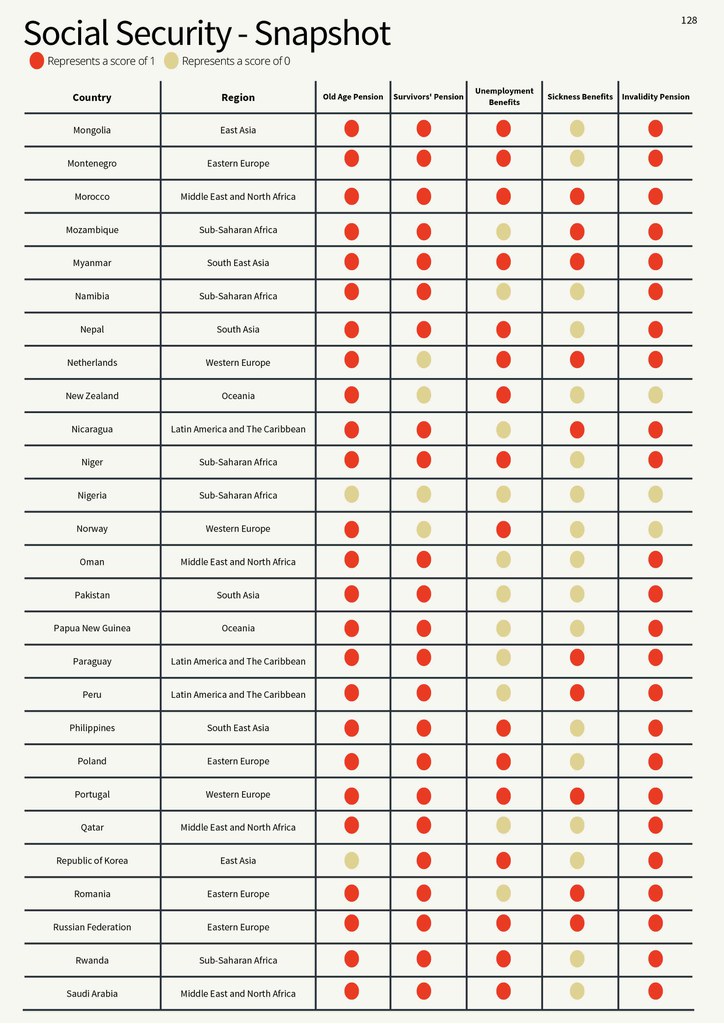
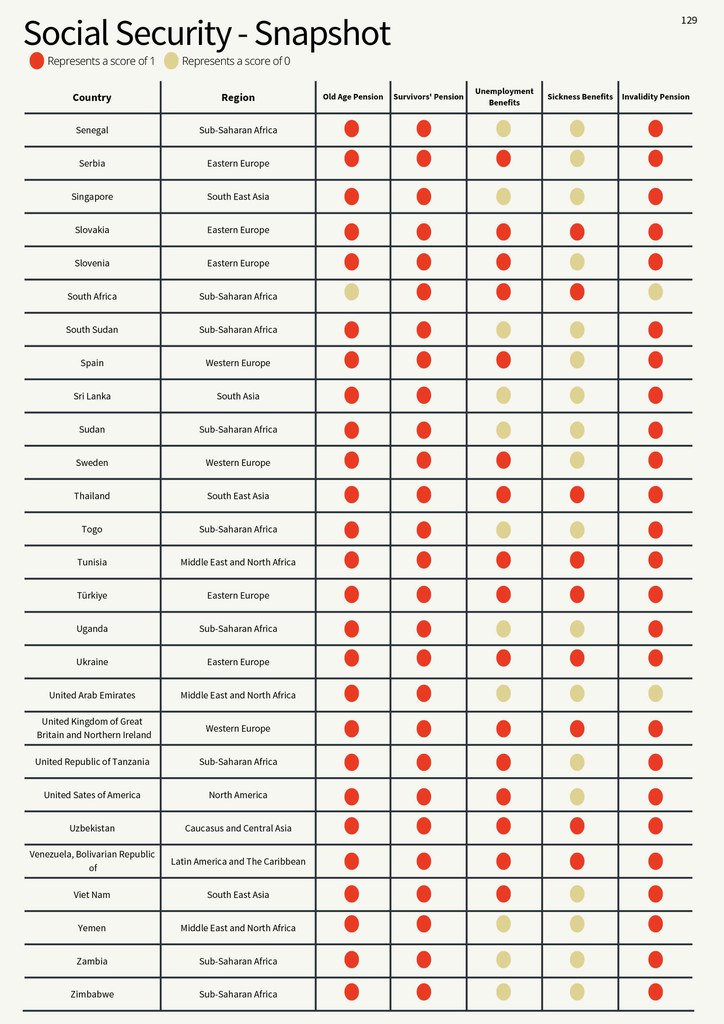
Fair Treatment
The Fair Treatment indicator measures legislation causing wage gap, discrimination in employment matters, sexual harassment at work, employment segregation and unequal access to basic labour protection for gig workers. Equal remuneration for all workers, referring to the rates of remuneration without discrimination based on gender and any other discriminatory grounds is the fundamental requirement for promoting non-discrimination at the workplace.
8.1 Equal Remuneration
Does the law require equal remuneration for men and women workers for work of equal value?
International Regulatory Standard
Article 2 of the Equal Remuneration Convention, 1951 (No. 100) stipulates that the principle of equal remuneration for men and women workers for work of equal value should be promoted and ensured for all workers by means appropriate to the methods in operation for determining rates of remuneration. This principle may be applied through national laws or regulations, legally established or recognised machinery for wage determination, collective agreements between employers and workers, or a combination of these various means.
Methodology
Whether the law requires equal remuneration for work of equal value:
1: The legislation mandates equal remuneration for male and female workers for work of equal value without discrimination on the grounds of sex.
0: The law limits the principle of equal remuneration to the same work, similar work, equal work or work of a similar nature.

8.2 Sexual Harassment in Employment
Does the law prohibit sexual harassment in employment?
International Regulatory Standard
Article 7 of the Violence and Harassment Convention, 2019 (No. 190) states that without prejudice to and consistent with Article 1 (definitions of violence and harassment as well as gender-based violence and harassment), each Member shall adopt laws and regulations to define and prohibit violence and harassment in the world of work, including gender-based violence and harassment. Article 10 of the Convention suggests that members may impose sanctions, where appropriate, in cases of violence and harassment in the world of work.
Methodology
Whether law prohibits sexual harassment at work:
1: The legislation protects against workplace sexual harassment.
0: There is no such legislation or if it addresses harassment in general or has a general prohibition on harassment only without any criminal penalties (either fines or imprisonment) or civil remedies (monetary compensation for victims and recovery of damages).

8.3 Discrimination in Employment
Does the law prohibit discrimination in employment matters?
International Regulatory Standard
Article 2 of the Discrimination (Employment and Occupation) Convention, 1958 (No. 111) states that equality of opportunity and treatment in respect of employment and occupation, with the purpose of eliminating any discrimination, should be promoted.
Article 8 of the Maternity Protection Convention, 2000 (No. 183) prohibits employers from terminating the employment of a woman during her pregnancy or absence on leave or during a period following her return to work to be prescribed by national laws or regulations, except on grounds unrelated to the pregnancy or birth of the child and its consequences or nursing.
Methodology
Whether the law prohibits discrimination in employment:
1: The law prohibits employers from discrimination or mandates equal treatment of all workers in an employment matter. A score of 1 is assigned only if a country has prohibited discrimination on at least seven of the above ten grounds.
0: the law does not prohibit such discrimination or only prohibits such in one aspect of employment, such as pay or dismissal. The prohibited grounds for discrimination are “race, colour, sex, religion, political opinion, national extraction or social origin, age, disability and trade union membership".
27% of the countries, representing more than 52% of the global labour force, do not prohibit discrimination in employment on at least 7 of the 10 grounds.
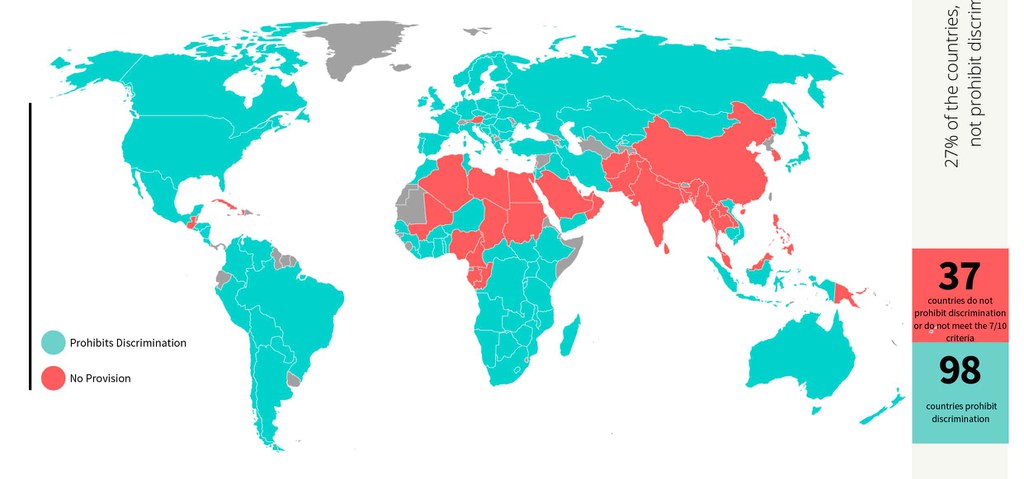
8.4 Access to Same Jobs as Men
Does the law allow women to do the same job as men?
International Regulatory Standard
The Discrimination (Employment and Occupation) Convention, 1958 (No. 111) requires each ratifying Member to declare and pursue a national policy designed to promote, by methods appropriate to national conditions and practice, equality of opportunity and treatment in respect of employment and occupation, to eliminate any discrimination in respect thereof.
Methodology
Whether the law allows women to do the same jobs as men:
1: The legislation does not restrict non-pregnant and non-nursing women from working in the same jobs as men.
0: The law prohibits or restricts women from working in jobs deemed hazardous, arduous, morally inappropriate and during night hours.
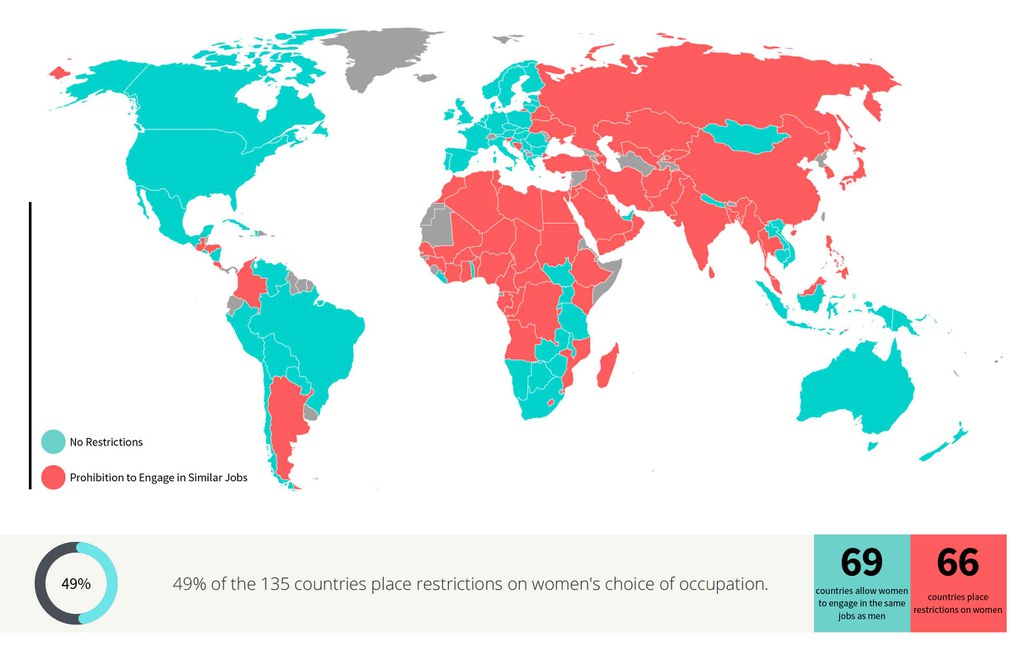
8.5 Basic Social Protection - Gig Economy
Does the law guarantee basic labour protection to the gig economy workers?
International Regulatory Standard
The Global Commission on the Future of Work 2019 recommended the development of an “international governance system for digital labour platforms”, requiring platforms (and clients) to respect certain minimum rights and protections. The Maritime Labour Convention 2006 (MLC, 2006) can be used as an example.
Similarly, provisions of the Tripartite Declaration of Principles concerning Multinational Enterprises and Social Policy (MNE Declaration) 2017, can be used as guiding principles.
Methodology
Whether the law guarantees basic labour protection to the gig economy worker:*
1: Considering the new phenomenon of the gig economy, a score of 1 is currently assigned to all such countries which provide at least the basic social protection** (old age pension, survivors’ benefits and invalidity benefits) to self-employed workers.
0: The basic social protection is not afforded to self- employed workers or where access to these benefits is linked to citizenship.
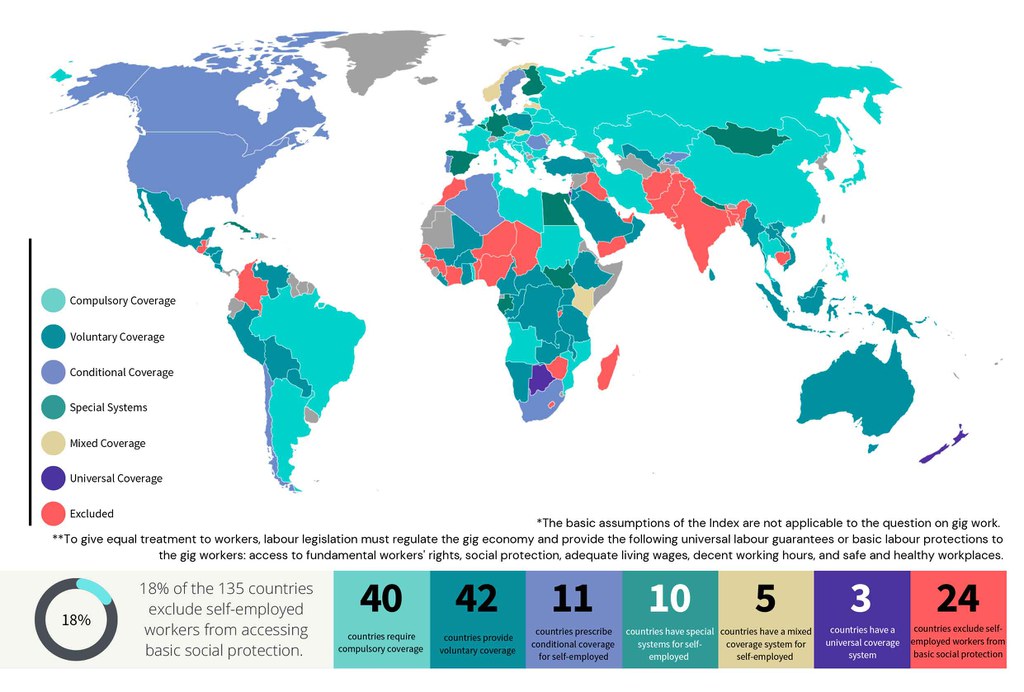
Fair Treatment - Snapshot
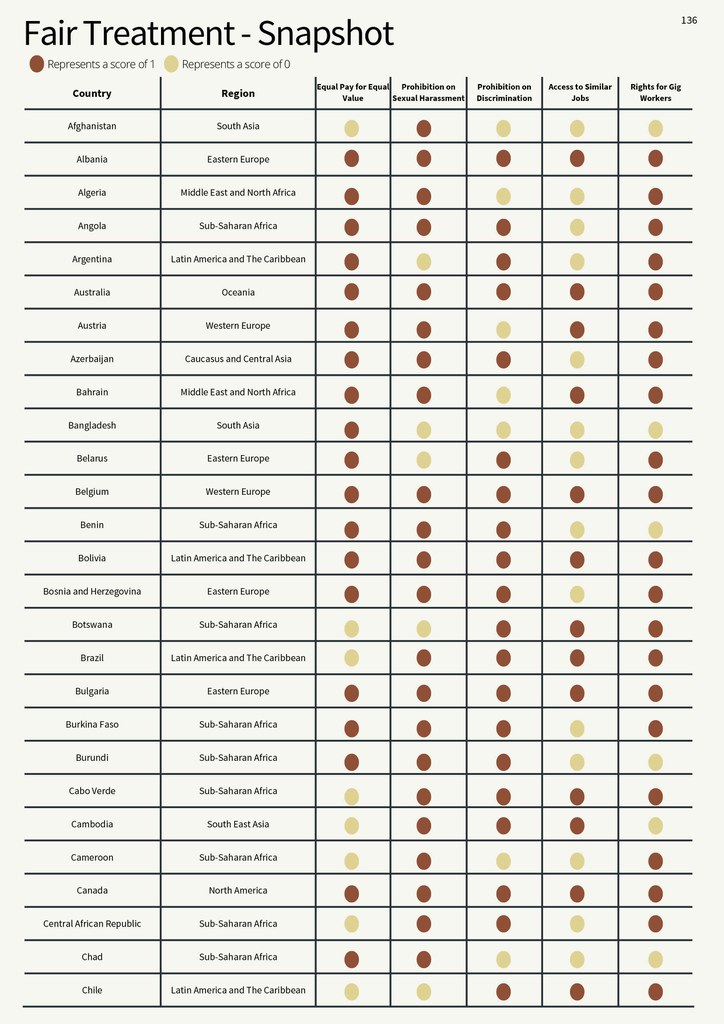
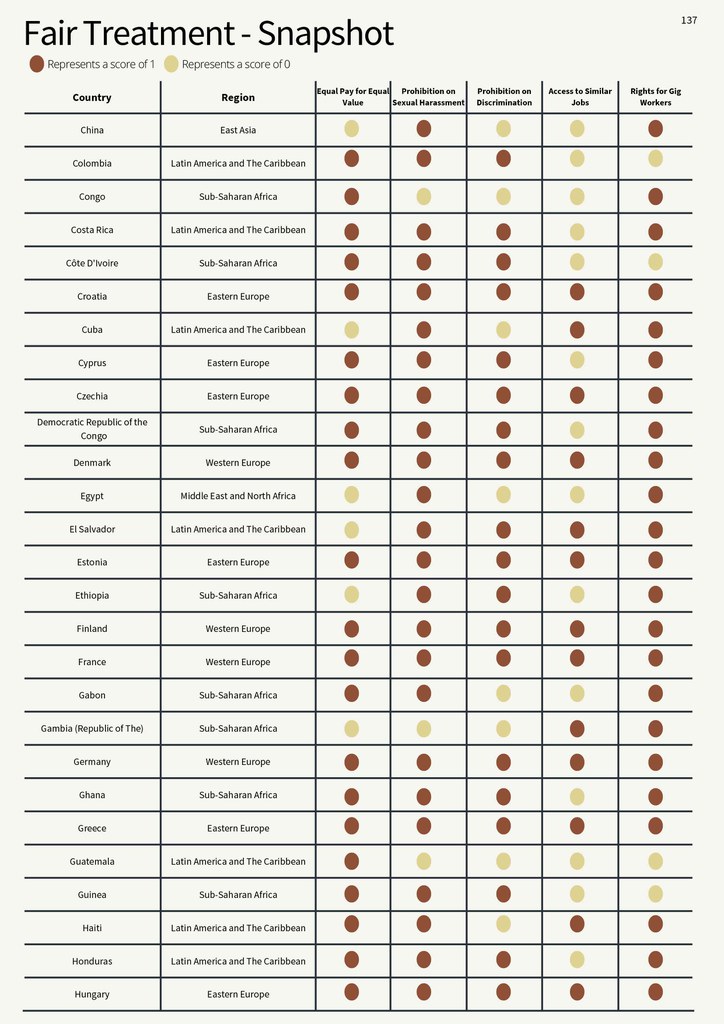
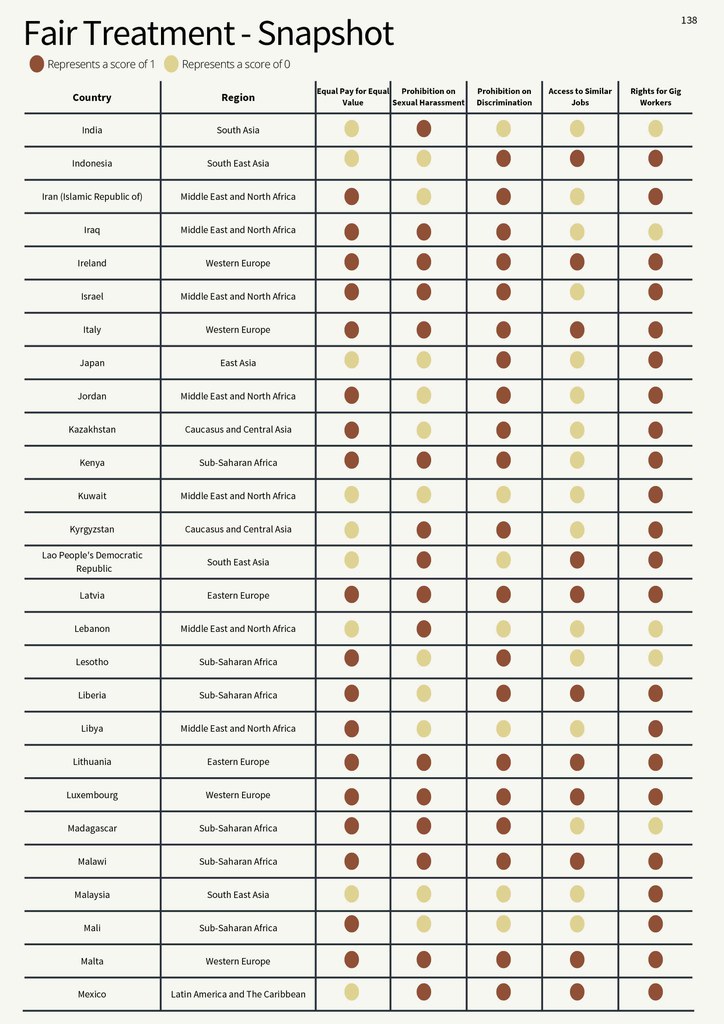
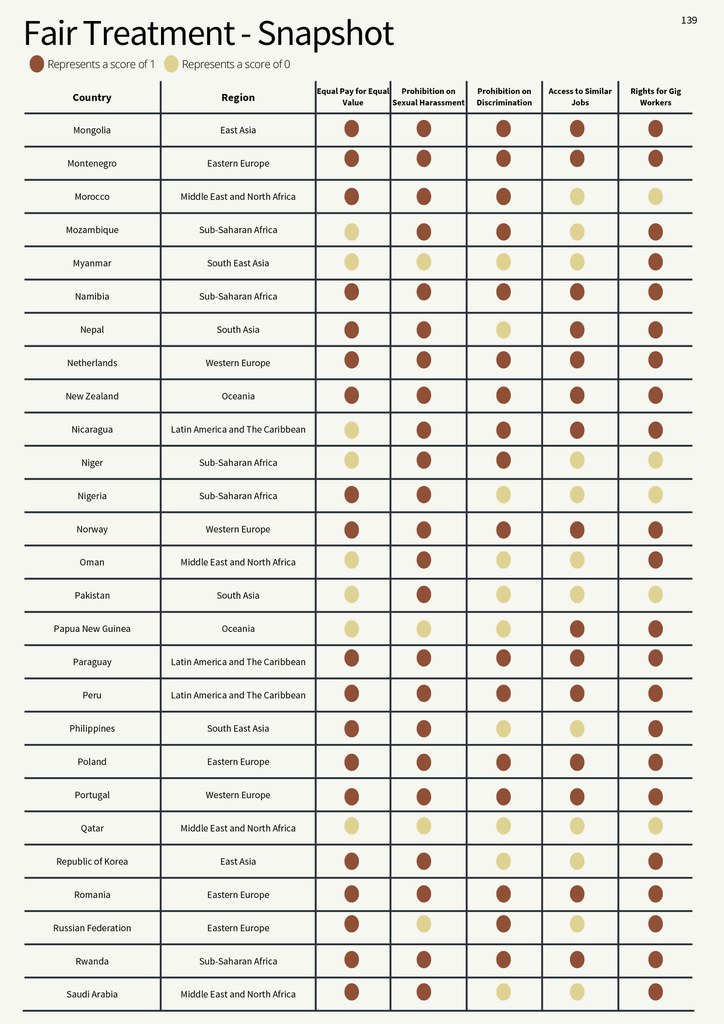
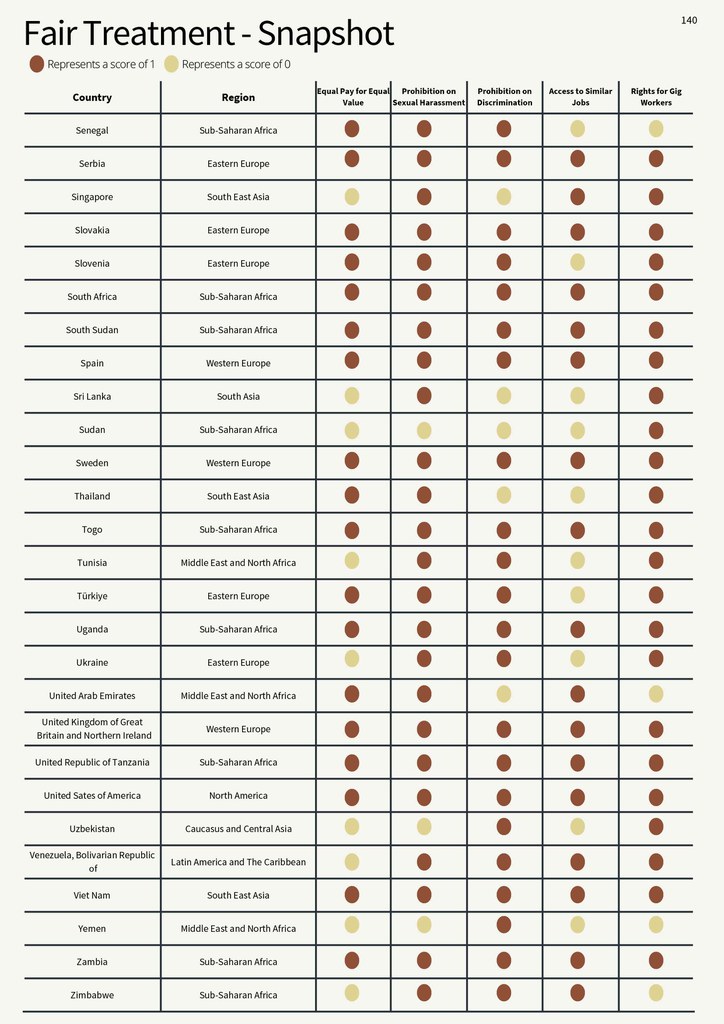
Child and Forced Labour
The Child and Forced Labour indicator measures legislation regulating the employment of children and linking this employment to their compulsory education.
The indicator also measures whether legislation prohibits forced labour.
9.1 Employment Age
Does the law prohibit employment of children?
International Regulatory Standard
Article 2 of Minimum Age Convention 1973 (No. 138) states that a minimum age for admission to employment or work shall not be less than the age of completion of compulsory schooling and, in any case, shall not be less than 15 years.
However, a ratifying Member whose economy and educational facility are insufficiently developed may, after consultation with the organisations of employers and workers concerned, initially specify a minimum age of 14 years.
Article 32(2) of the Convention on the Rights of the Child can be applied here as well. It states that the States Parties shall take legislative, administrative, social and educational measures to ensure the implementation of a minimum age or minimum age for admission to employment; provide for appropriate regulation of the hours and conditions of employment; Provide for appropriate penalties or other sanctions to ensure the effective enforcement of the present article.
Methodology
Whether the law prohibits the employment of children:
1: The legislation prohibits the employment of children under the age of 15 years (14 years in the case of developing countries).
0: The employment entry age is lower than 15 years (14 years in the case of developing countries).
19% of the assessed countries, spread across Africa, Americas and Asia, set the minimum age for employment at 14.
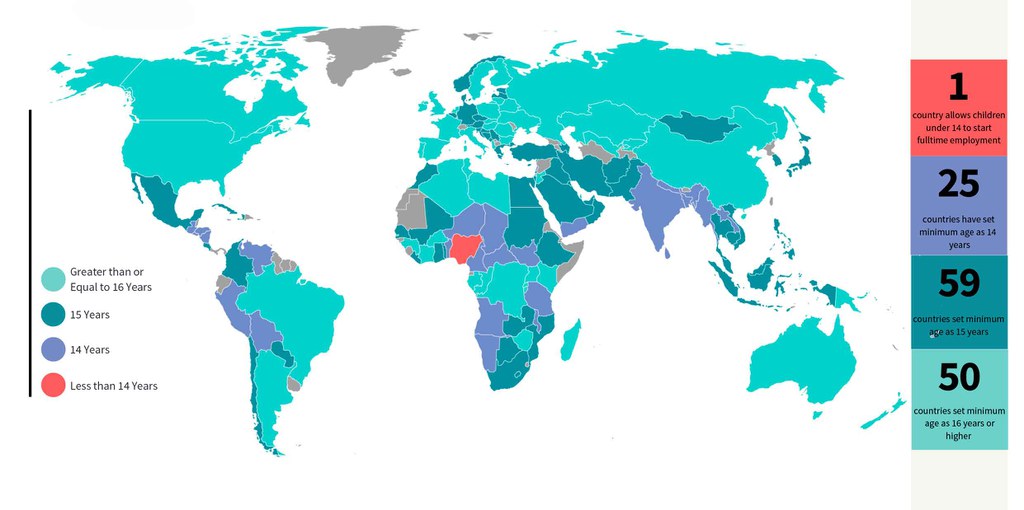
9.2 Compulsory Schooling Age
Does the law set employment entry age equal or higher than the compulsory schooling age?
International Regulatory Standard
Article 2(3) of Minimum Age Convention 1973 (No. 138) specifies that the minimum age for employment shall not be less than the age of completion of compulsory schooling and, in any case, shall not be less than 15 years (14 years for developing countries).
Methodology
Whether employment entry age is similar or higher than the compulsory education age:
1: The legislation sets the employment entry age similar to or higher than the compulsory education age.
0: The employment entry age is lower than the compulsory education age or if the compulsory schooling age is not defined under the law.
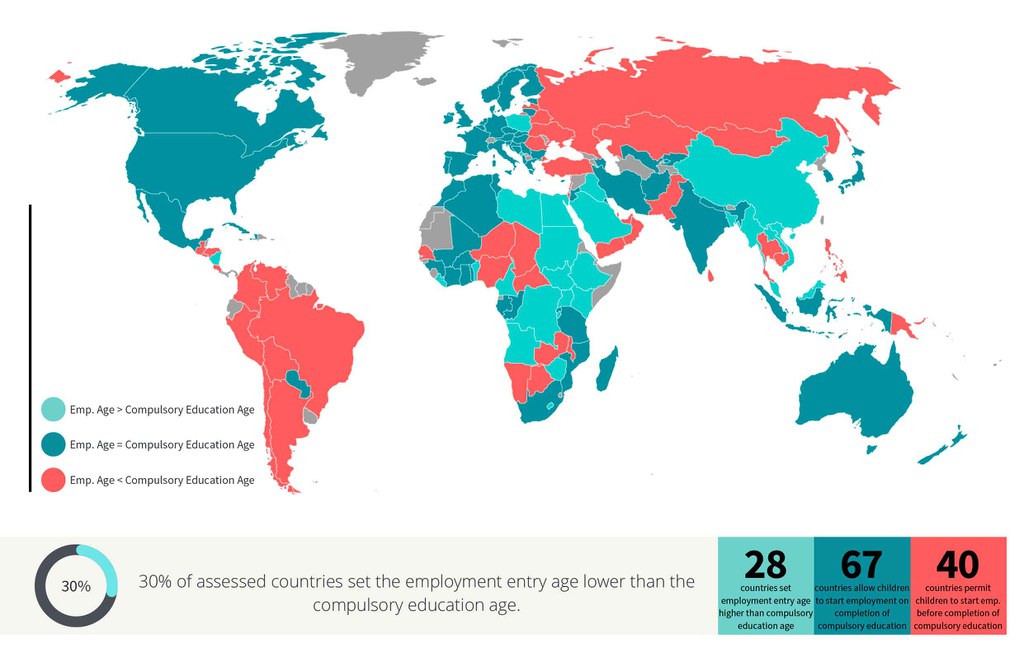
9.3 Age for Hazardous Work
Does the law prohibit the employment of children in hazardous work under the age of 18 years?
International Regulatory Standard
Article 3 of Minimum Age Convention 1973 (No. 138) stipulates that the minimum age for admission to any type of employment or work which, by its nature, or the circumstances in which it is carried out, is likely to jeopardise the health, safety or morals of young persons shall not be less than 18 years. The types of employment or work shall be determined by national laws or regulations or by the competent authority, after consultation with the organisations of employers and workers concerned, where such exist. National laws or regulations or the competent authority may authorise employment or work from the age of 16 years on the condition that the health, safety and morals of the young persons concerned are fully protected and that the young persons have received adequate specific instruction or vocational training in the relevant branch of activity.
Furthermore, Article 32 (1) of the Convention on Rights of Child states that there should be recognition of the right of the child to be protected from economic exploitation and from performing any work that is likely to be hazardous or to interfere with the child’s education, or to be harmful to the child’s health or physical, mental, spiritual, moral or social development.
Methodology
Whether the law prohibits the employment of adolescents in hazardous work:
1: The legislation prohibits the employment of children under the age of 18 years in hazardous work.*
0: The employment entry age for hazardous work is lower than 18 years or is not specified.
97% of the assessed countries set the minimum age for hazardous work at 18, making it a global standard.
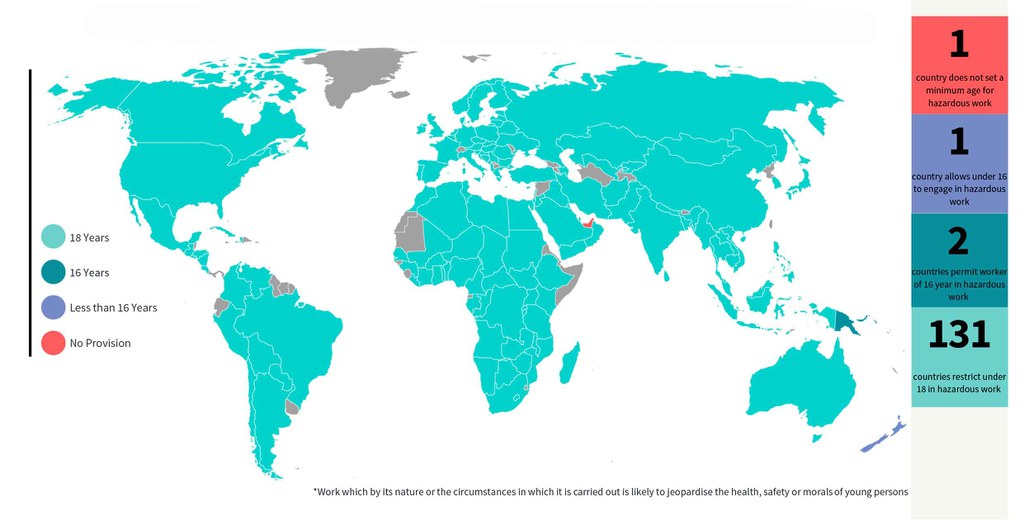
9.4 Forced Labour
Does the law prohibit forced labour?
International Regulatory Standard
Article 2 of the Forced Labour Convention, 1930 (No. 29) specifies that forced or compulsory labour means all work or service (with some exceptions) which is exacted from any person under the menace of any penalty and for which the said person has not offered himself voluntarily.
Protocol of 2014 to the Forced Labour Convention, 1930 focuses on taking effective measures to prevent and eliminate the use of forced or compulsory labour, to provide protection to victims and access to appropriate and effective remedies, such as compensation, and sanction the perpetrators of forced or compulsory labour. It also refers to specific action against trafficking in persons for the purposes of forced or compulsory labour.
Article 8 of the International Covenant on Civil and Political Rights states that no one shall be held in slavery or servitude; slavery and the slave trade in all their forms shall be prohibited, and no one shall be required to perform forced or compulsory labour.
Methodology
Whether the law prohibits forced labour:
1: The legislation prohibits forced labour except in certain extraordinary circumstances.
0: The law does not prohibit forced labour or has only a general prohibition without any sanctions.
More than 95% of the countries prohibit forced labour and impose penal sanction on those involved in the crime.

Child and Forced Labour - Snapshot
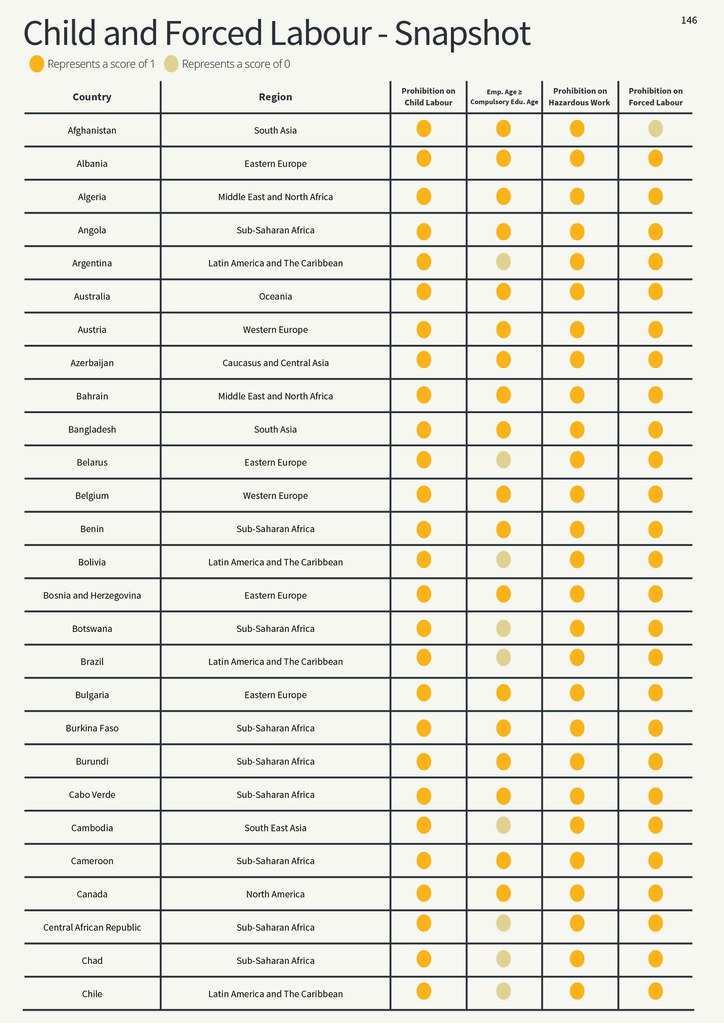
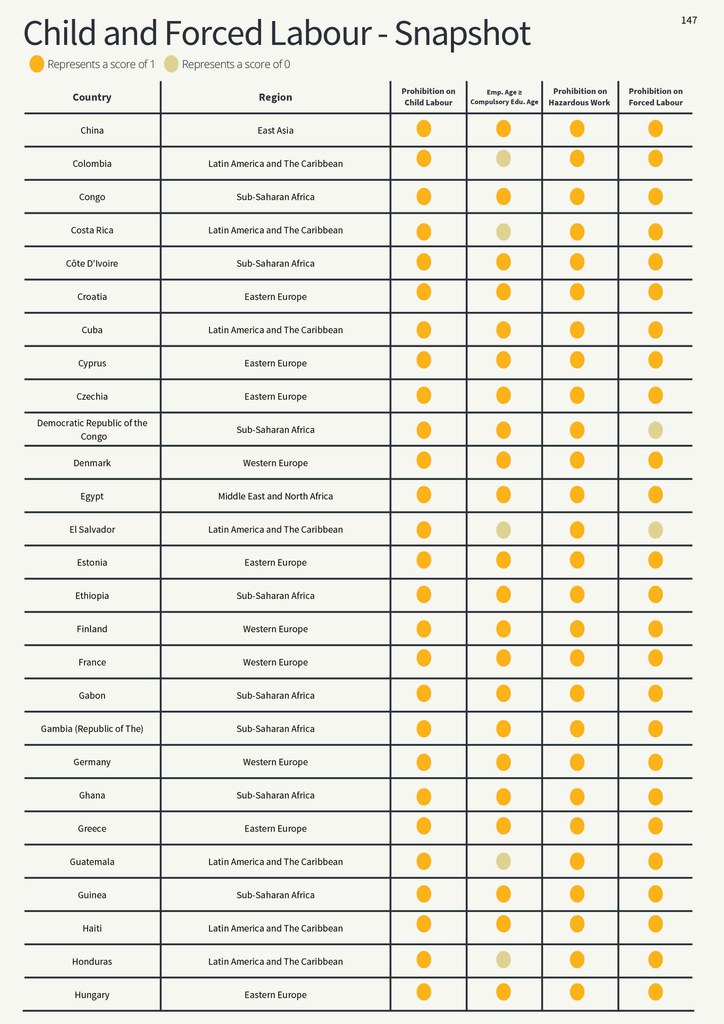
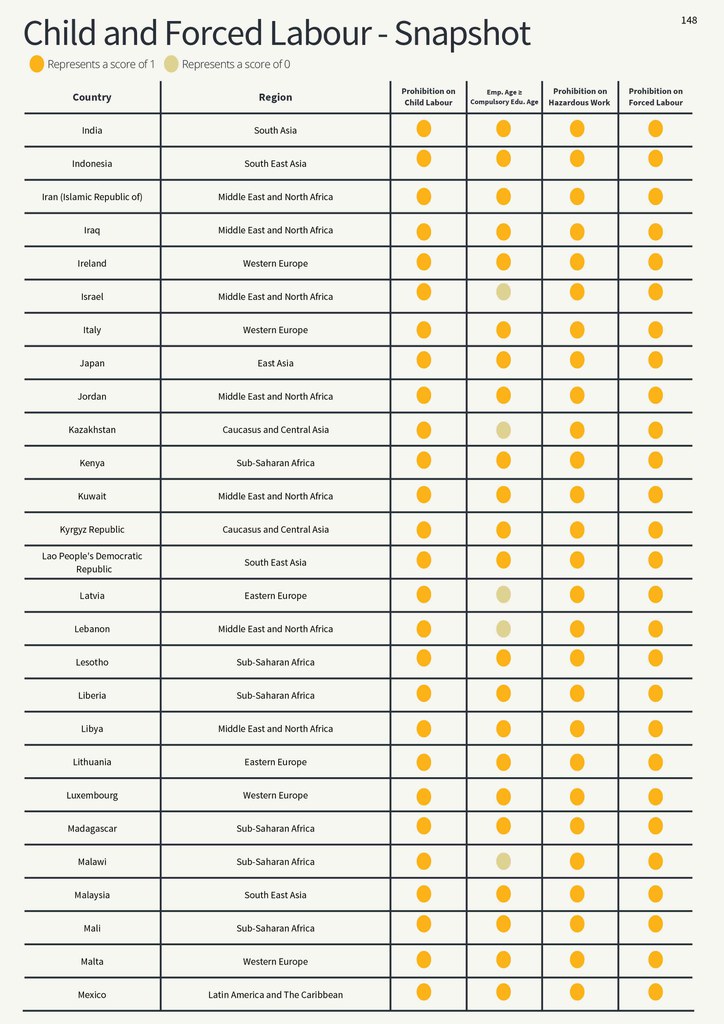
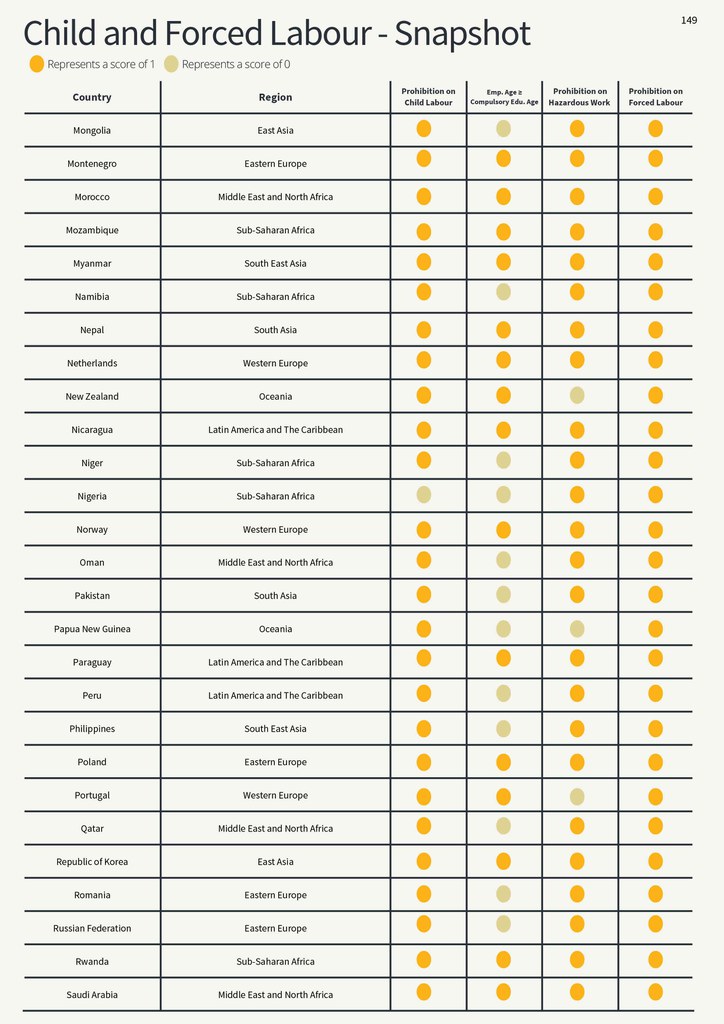

Trade Union
The Trade Union indicator measures legislation regulating freedom of association, the right to collective bargaining as well as the
right to strike.
The indicator also measures whether law prohibits employers from replacing workers on a legal strike.
10.1 Freedom of Association
Does the law allow workers to form and join unions of their own choice?
International Regulatory Standard
Article 2 of the Freedom of Association and Protection of the Right to Organise Convention, 1948 (No. 87) states that workers and employers, without distinction whatsoever, shall have the right to establish and, subject only to the rules of the organisation concerned, to join organisations of their own choosing without previous authorisation.
Methodology
Whether the law allows Freedom of Association (FoA):
1: The legislation allows workers to form and join organisations of their own choice with the exception of armed forces, police, prison services, intelligence agencies, judges, firefighting, those engaged in the administration of the state, and managerial employees.
0: There is an explicit general prohibition in law of the right to establish and join organisations, or the law prohibits more than one trade union in a single enterprise or there is state monopoly through the imposition of a single organisation to which workers must belong.
There are restrictions or exclusions from the right to freedom of association other than those referred to above.
Workers are excluded from the right to form and join organisations of their own choice based on exclusionary criteria like race, political opinion, nationality, age or on the grounds of occupational categories (public or private sector).
44% of the 135 countries prevent workers from their right to practice freedom of association.
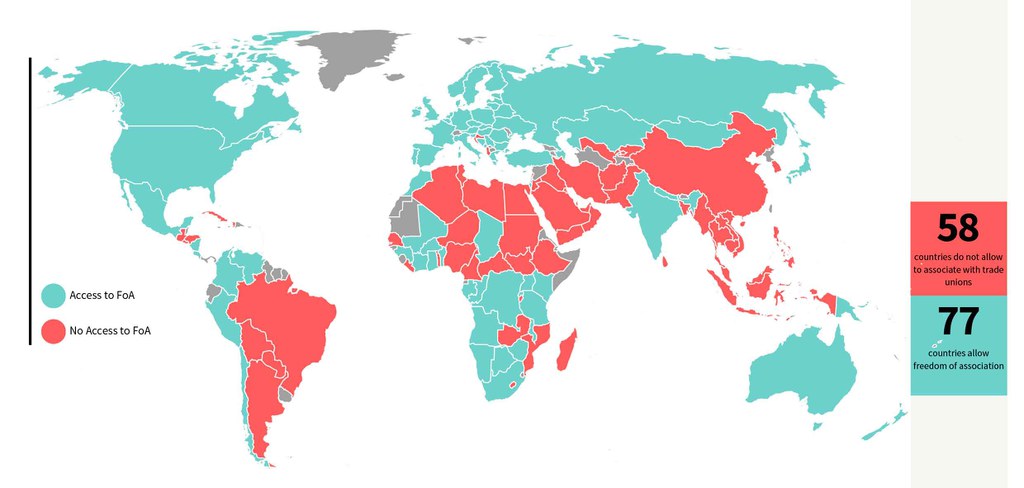
10.2 Collective Bargaining
Does the law allow workers to bargain collectively with employers through their representative unions?
International Regulatory Standard
Article 4 of the Right to Organise and Collective Bargaining Convention, 1949 (No. 98) states that measures appropriate to national conditions shall be taken, where necessary, to encourage and promote the full development and utilisation of machinery for voluntary negotiation between employers or employers’ organisations and workers’ organisations, with a view to the regulation of terms and conditions of employment by means of collective agreements.
Methodology
Whether the law allows workers to bargain collectively:
1: The legislation allows workers* and their representative organisations to negotiate and conclude collective agreements with employers to determine terms and conditions of employment.
0: There is an explicit general prohibition in the law of the right to collective bargaining. Workers are exclude from the right to bargain collectively based on exclusionary criteria like race, political opinion, nationality or on the grounds of occupational categories (public or private sector) except those referred to above. There are excessive requirements along with a lack of objective, pre-established and precise criteria for the determination and recognition of trade unions entitled to collective bargaining. There are excessively high representation thresholds (higher than 20%) for trade unions for collective bargaining purposes.
45% of the 135 countries prevent workers from their right to bargain collectively with employers.
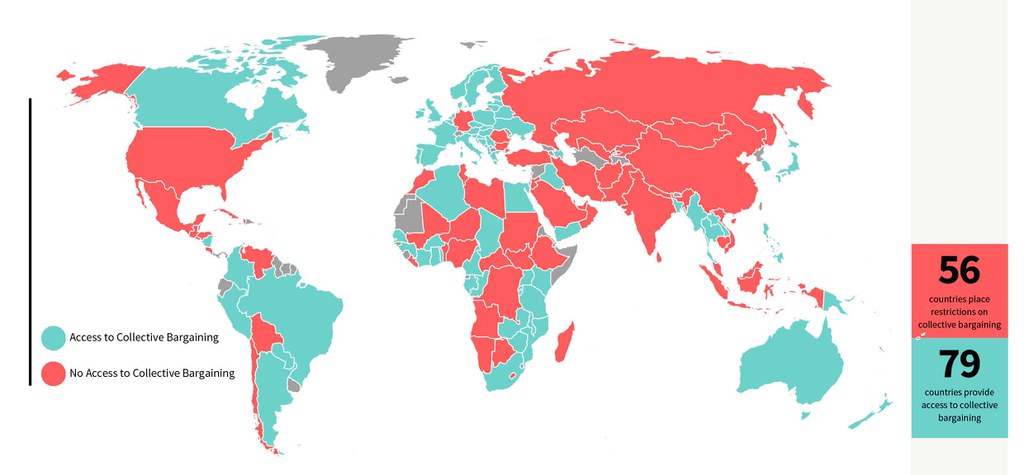
10.3 Right to Strike
Does the law provide the right to strike?
International Regulatory Standard
Article 11 , Convention 87 states that each Member of the International Labour Organisation for which this Convention is in force undertakes to take all necessary and appropriate measures to ensure that workers and employers may exercise freely the right to organise.
Para 751 of the Compilation of decisions of the Committee on Freedom of Association, 2018 shares that while the Committee has always regarded the right to strike as constituting a fundamental right of workers and of their organisations, it has regarded it as such only in so far as it is utilised as a means of defending their economic interests. Para 754 further states that the right to strike is an intrinsic corollary to the right to organise protected by Convention No. 87.
Methodology
Whether the law allows the right to strike:
1: The legislation provides for the right to strike for workers.
0: The right to strike is not provided in law or if there is an explicit general prohibition on strikes. There are excessive exclusions based on race, political opinion, nationality, or occupational categories (public or private sector). The right is jeopardized through many restrictions or where the list of essential services is broader than the approved list*. A requirement of more than 50% of workers to be in favor of a strike is present.
The legislation sets too long a period for previous negotiation, conciliation, and mediation (greater than 30 days) or unreasonable period of notice/cooling-off periods before calling a strike (greater than 14 days).
Only 22% of the 135 countries allow their workers the right to strike.
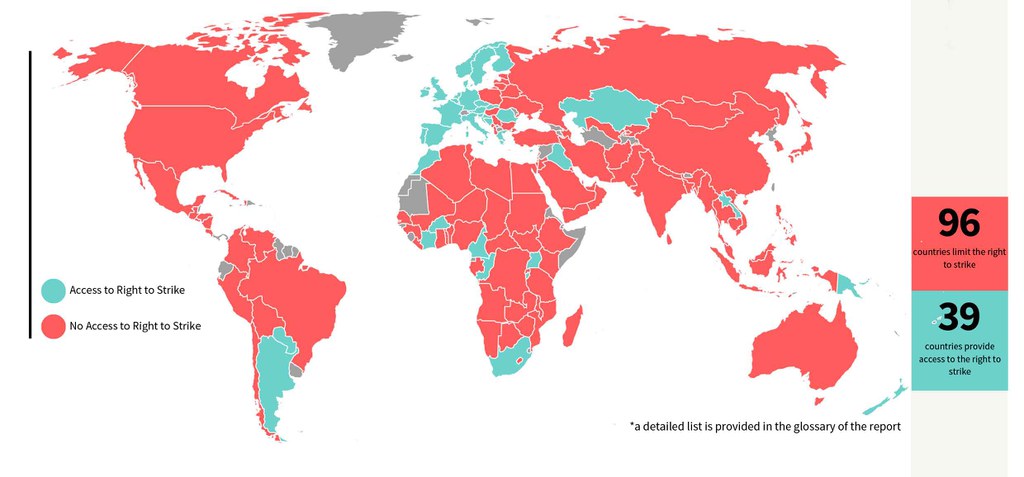
10.4 Replacing Workers on Strike
Does the law prohibit employers from terminating employment contracts of striking workers?
International Regulatory Standard
Article 1 of the Right to Organise and Collective Bargaining Convention, 1949 (No. 98) states that workers shall enjoy adequate protection against anti-union discrimination in their employment. Such protection shall apply more particularly in respect of actions calculated to make the employment of a worker subject to the condition that he shall not join a union or shall relinquish trade union membership; or to cause the dismissal of or otherwise prejudice a worker because of union membership or because of participation in union activities outside working hours or, with the consent of the employer, within working hours.
Methodology
Whether the law prohibits replacing workers on strike:
1: The legislation prohibits the replacement of striking workers.
0: The law does not prohibit the replacement of those workers who are on legitimate and peaceful strike, and there are excessive sanctions in case of strikes, including imprisonment of workers.
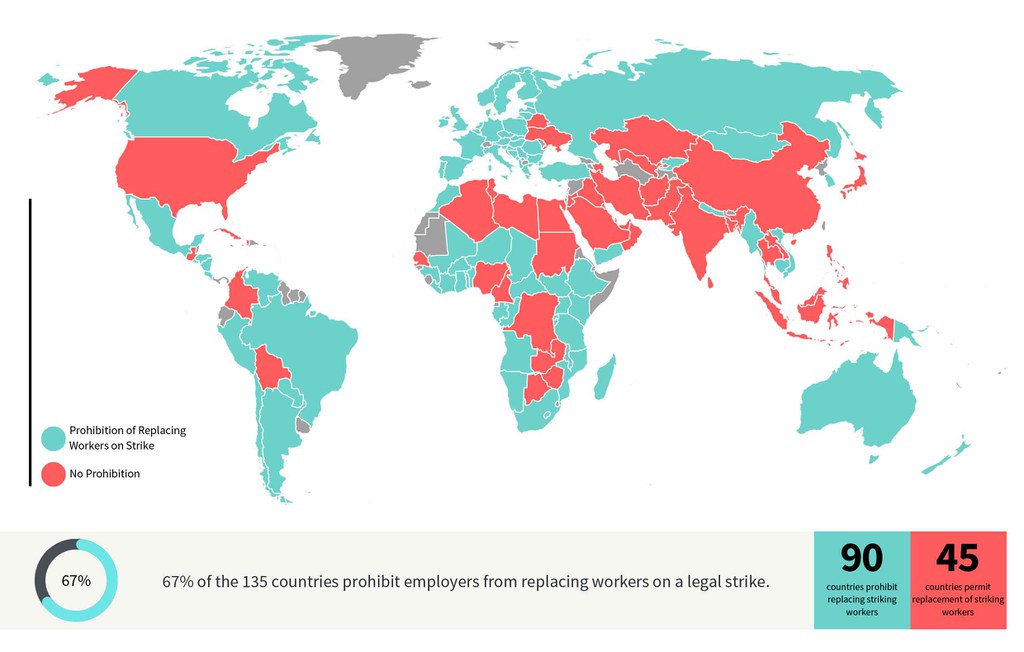
Trade Union - Snapshot
